

EDITED BY STEPHEN XU, MIRANDA WOMACK, EMMA YANG, MOKSH JAIN, VIHAAN HARI, AND TARUN SIVAKUMAR WITH PROFESSOR JEFFREY J. YOUNGER
DESIGNED BY JOCELYN CHEN AND SNEHA RAO



EDITED BY STEPHEN XU, MIRANDA WOMACK, EMMA YANG, MOKSH JAIN, VIHAAN HARI, AND TARUN SIVAKUMAR WITH PROFESSOR JEFFREY J. YOUNGER
DESIGNED BY JOCELYN CHEN AND SNEHA RAO
NYU STERN STUDENT VOICES
VOL. 12 / SPRING 2025
Front cover: The Woolworth Building is a 792' landmark skyscraper located at 233 Broadway in New York City, completed in 1913. Once the tallest building in the world, it is renowned for its neo-Gothic design, ornate detailing, and its status as one of the city’s most historic and beautiful structures.
Front and back cover taken by Alexander Thomas-Tikhonenko, a junior (Class of '26) majoring in Photography & Imaging at New York University's Tisch School of the Arts, with a minor in Business, Entertainment, Media, and Technology.



ROHIT DEO
Dean of the Undergraduate College
Distinguished Service Professor of Business and Professor of Statistics
New York University Stern School of Business
In an era defined by both unprecedented challenges and boundless possibilities, the pursuit of innovative solutions has never been more critical. The Call presents a compilation of student essays that address some of the most pressing issues of our time through a variety of lenses, including technology, sustainability, health, social equity and others.
To that end, I invite you to explore how cacao trees might help mitigate the ecological tolls caused by oil palm plantations, the availability of microfinance opportunities in Rajasthan, an analysis of geothermal power in Texas, and the ways in which AI is being used to reduce food waste, among others. Indeed, this collection truly represents the belief that “big problems require bold innovation,” which rings through from each page.
I hope these essays not only inform but inspire you to envision how we might create a better future together. I am incredibly proud to lead the NYU Stern Undergraduate College and to work with some of the finest business students on the planet who are already creating positive change for a better tomorrow.
Welcome to this journey of exploration and possibility.
In the spring of 2024, we focused on Amazon in the first unit of the course as an illustration of the complexity of the relationship between business and other societal institutions, considering its competitive market positioning, labor relations, and carbon footprint. Then, in the second unit, we explored a series of challenges and opportunities that face many businesses around the world, including the transition to a carbon-neutral economy, the creation of a socially just workplace, the engagement with political controversies, and the deployment of artificial intelligence. Finally, we worked in the third unit to develop business strategies that can create economic, social, and environmental value for stakeholders, including sustainability strategies, circular strategies, social entrepreneurial strategies, and strategies that connect individual agency with value for society.

The Business and Society course is the first course in the Social Impact Core Curriculum. No other undergraduate business program in the world gives students the occasion to think critically about these important issues in such depth and at such length. We have been undertaking these efforts for more than twenty years at NYU Stern because we believe that business leaders today and in the future need to be capable not only in the functional core disciplines of marketing, finance, accounting, management, and operations but beyond that, leaders need to understand the overall purpose of business in and for society and be able to engage in critical reflection and dialogue when stakeholders disagree about or call into question the value that business can and should create for society.
Clinical Professor of Business and Society Richman Family Director of Business Ethics and Social Impact Programming
All 650 first-year undergraduate students are thus well on their way, both in terms of their study of business and also in terms of their careers as business leaders capable of leadership in these uncertain and polarized times. They are encouraged to think critically, engage in critical dialogue with each other, and explore innovative possible solutions to the seemingly intractable, grand challenges facing our global society. They give me hope!
I want to thank the contributing authors and editors of this publication for their excellent work. I also want to thank Mara van Loggerenberg, the senior associate director of social impact programming, for her efforts in optimizing this course every year. Finally, I thank my faculty colleagues, whose intelligence and empathy in the classroom help support all of our students through the learning process.
Onward!

BY CORBIN CANAVARROS
The article highlights the significant employment challenges faced by individuals with disabilities, particularly those with paraplegia, who experience a much higher unemployment rate than non-disabled people. The author proposes that Neuralink’s braincomputer interface (BCI) technology, specifically through its PRIME study, could be expanded to include workforce training, enabling participants to improve their employment prospects by learning to operate digital tools essential for remote work.
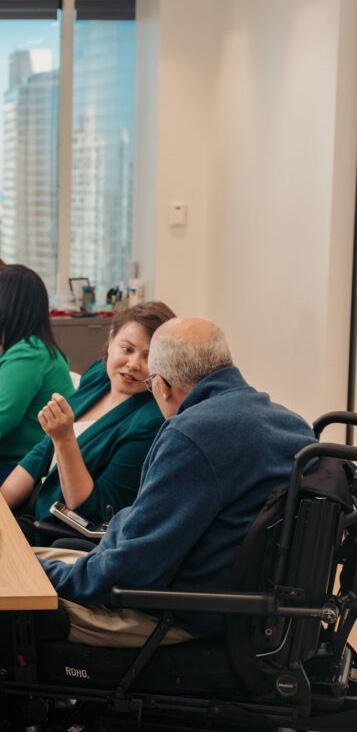
With over 70 million adults in the U.S. reporting a physical disability, efforts to improve their livelihoods should be at the forefront of society’s mind.1
According to the U.S. Bureau of Labor Statistics (BLS), the 2023 U.S. unemployment rate for people with disabilities was 7.2 percent – over twice the 3.5 percent unemployment rate for people without disabilities.2 Additionally, the BLS reported that only 22 percent of people with a disability were employed, compared to 66 percent for those without a disability.3
People living with disabilities are confronted with a harsh reality: finding employment is an unfair challenge. According to the CDC, high rates of unemployment among people with disabilities directly contribute to “adults with disabilities reporting experiencing frequent mental distress almost 5 times as often as adults without disabilities.”4
In addition to the challenges faced by disabled individuals, a cost estimate from IBISWorld Industry Reports suggests that unemployment amongst people with disabilities cost American taxpayers $109B in 2024 through welfare and other public support programs.5 The figure on p.08 shows the high cost alongside the economic productivity foregone due to this group not contributing to the economy and the personal toll paid by the 519,000 unemployed
working-age people with disabilities (Figure 1).
Governments and other humanitarian organizations have become aware of the significant damage that unemployment causes for people with paraplegia. As a result, several initiatives have been carried out to improve the issue. Unfortunately, multiple studies have proven these efforts ineffective.
For example, a random controlled trial of over 20,000 individuals with spinal cord injuries (SCI) found that ‘supported employment programs,’ which include employment training, facilitated favorable employment outcomes among subjects post-SCI. While such assistance would help readjustment in theory, the results were varied. The rate of returning to work post-SCI for the individuals surveyed was approximately 29 percent, indicating that supported training was ineffective in reaching employment for the majority.10 This study highlights that programs designed to improve employment outcomes for people with paraplegia do not necessarily achieve the desired employment outcomes.
A paper in the International Journal of Social Determinants of Health and Health Services also found that unemployment rates among people who experienced SCI remained relatively
similar between countries with stronger or weaker public support programs for these individuals. In fact, the study found that income levels before injuries were actually the strongest predictor of returning to employment post-SCI.11 This statistic may prove that public programs designed to improve employment outcomes for individuals with SCI are not impactful enough. Another effort to improve employment outcomes for people with disabilities is Google Glass. This innovation from Google offers a “wearable, voice-and motion-controlled Android device that…displays information directly in the user’s field of vision.”12 Initially advertised as an “Assistive Technology”13 device, the glasses held promising potential to enable people with disabilities to complete jobs their disabilities prevented them from doing. However, poor results led Google to stop production less than a year after starting.14
With the results of these two studies and the story of Google Glass in mind, it leads to the question of why those with paraplegia experience low rates of employment despite programs designed to assist them in finding employment. To answer this question, a study in the Journal of Occupational Medicine and Toxicology focused on people with paraplegia. The study found that the most common reason for lack of employment was “the state of health and disability,” placing this

Figure 1: Bureau of Labor Statistics employment figures6
number at 64 percent. Nearly a fifth of the respondents reported: “workspace environments which were not barrierfree and therefore not accessible without great effort.”15 Given this study, one could argue that the challenges in completing work and physical transportation to a workplace are the most common reasons why people with paraplegia experience low rates of employment. Yet, despite these hurdles, a novel opportunity exists to address this issue.
While previous attempts to improve employment rates for individuals with paraplegia have led to minimal improvement in employment outcomes, brain-computer interfaces (BCI) show promise in enabling people with paraplegia to join the workforce. BCIs are “computer-based systems that acquire brain signals, analyze them, and translate them into commands, relayed to an output device to carry out a desired action.”16 Neuralink, a BCI company founded by Elon Musk, states, “We are currently focused on giving people with quadriplegia the ability to control their computers and mobile devices with their thoughts.”17 Neuralink has made significant steps toward accomplishing this goal through its Precise Robotically Implanted Brain-Computer Interface (PRIME) study, which aims “to enable people with quadriplegia to control external devices with their thoughts, thereby restoring digital autonomy.”18 After receiving FDA approval for in-human testing, Neuralink surgically implanted a fully developed BCI device in a human with quadriplegia, enabling them to control a computer with their eyes and play online chess against other humans.
The results of Neuralink’s PRIME study indicate significant promise in enabling people with paraplegia to
“Neuralink has made significant steps toward accomplishing this goal through its Precise Robotically Implanted BrainComputer Interface (PRIME) study, which aims ‘to enable people with quadriplegia to control external devices with their thoughts, thereby restoring digital autonomy.’ ”
gain employment by enabling them to operate computers seamlessly. In this light, Neuralink should expand the objectives of the PRIME study to include workforce training as a central component for all participants seeking employment. Implementing workforce training for participants of the PRIME study would place Neuralink in a position to reduce unemployment for people with paraplegia, all while benefiting relevant stakeholders. Specifically, adding this component to the study would put Neuralink in a position to benefit society by enabling participants of the PRIME study to enter the workforce at much higher rates.
For several reasons, Neuralink’s PRIME study is ideal for implementing workforce training to improve patient employment outcomes. First, PRIME’s focus on enabling individuals with paraplegia to operate computers with their eyes comes at a time when, according to a McKinsey report, workfrom-home and digital gig-economy trends indicate that opportunities to make a living while remote are at the highest level in history.20 By training PRIME participants on how to operate email, word processors, video-call platforms, and various other digital services, Neuralink can improve the patient’s workforce skillset and significantly ease employment challenges for people with paraplegia. In addition to the technical feasibility of this change, PRIME is also ideal for implementing workforce training due to its logistical structure. The first 18 months for participants of the PRIME study include weekly monitored in-person and remote training on using the BCI to operate
a computer, utilizing exercises of operating different websites.21 This format would enable Neuralink to iteratively adapt workforce training to the patients’ demonstrated abilities, simultaneously allowing the company to collect more data for the PRIME study.
While some may doubt the efficacy of workforce training, as suggested above, “62 percent of people with SCI who had gainful employment had participated in vocational re-integration measures, while only 38 percent of the unemployed group had taken advantage of such support measures.”22 While workforce training is not 100 percent effective in enabling people with paraplegia to join the workforce, it does provide significant benefits.
Another concern some may have surrounding the implementation of workforce training in Neuralink’s PRIME study is employment opportunities for low-skill or uneducated people. While it is true that work-from-home trends have favored educated professionals, there is evidence that even low-skill or loweducation workers can make a good living through work-from-home gigs.23 Thus, concerns that implementing workforce training into the PRIME study would only benefit skilled or educated workers are invalid.
Workforce training in the PRIME study also benefits Neuralink. The company’s increase in its ESG efforts will serve to improve its public image. Part of the company’s mission aims to “create a generalized brain
interface to restore autonomy to those with unmet medical needs today and unlock human potential tomorrow.”24 Implementing workforce training into the PRIME study aligns with this goal and qualifies as ESG action through positive social impact. In addition, this initiative has financial incentives. Professor Tensie Whelan, Director of NYU Stern’s Center for Sustainable Business, states that 58 percent of corporations that invested in ESG initiatives experience positive results.25 Having faced criticism for its tight control over results from the PRIME study,26 Neuralink is in a position where demonstrating a commitment to social good is critical. As such, Neuralink’s public figure founder and CEO, Elon Musk, should leverage his public platform to bring awareness to the company’s efforts in the paraplegic employment space.
On top of improving Neuralink’s public image through investment in ESG, implementing workforce training into its PRIME study would enable Neuralink to make a measurable contribution to the UN’s Sustainable Development Goals. A study in Nature found that “AI may act as an enabler on 134 targets across all SDGs, generally through a technological improvement, which may allow it to overcome certain present limitations.”27 With the capacity to leverage its artificial intelligence capabilities, Neuralink can specifically address the UN’s eighth and third SDGs, which focus on employment and generally improved well-being,28 all the while making progress toward improving the devastating reality of high unemployment for people with paraplegia.
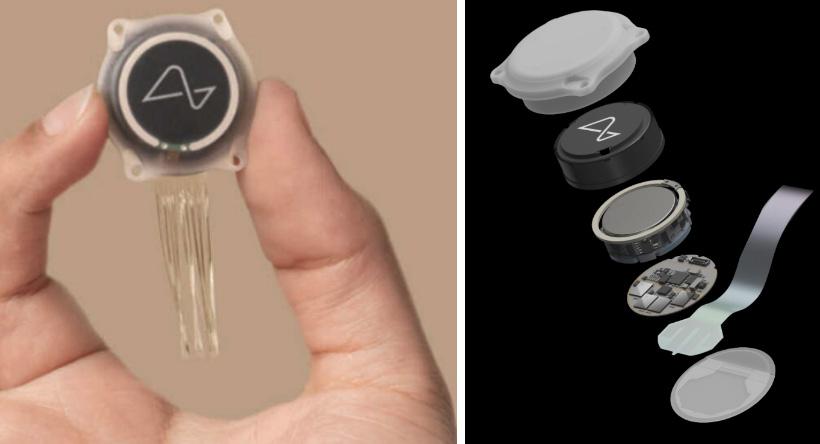
Despite the promise of regaining many abilities lost through paralysis, including the ability to work, some patients and members of the public may assume this process would be expensive. However, due to Neuralink’s extensive venture capital backing and the nature of the PRIME study, all costs associated with participating in the PRIME study are covered by Neuralink. With that in mind, there is no reason to believe that implementing a workforce training component changes the structure of the study and causes participants to have to pay for the service.
Another concern surrounding implementing workforce training into the PRIME study is whether employers want to hire individuals with paraplegia, even if they can work on computers. While this is a valid concern since significant discrimination
exists towards individuals with disabilities, a rise in work-fromhome and emphasis on ESG amongst corporations mitigates this concern.
A study in the Journal of Personalized Medicine found that the most common barriers to employment for people with spinal cord injuries are “transportation issues, physical inaccessibility, lack of accommodations, and discrimination by employers.”29 Three out of four of these reasons would be directly mitigated by working from home, a practice which is growing in popularity.30 The fourth concern, discrimination by employers, is rapidly declining, demonstrated by the fact that a historically high 65 percent of Fortune 500 companies list hiring more individuals with disabilities as a component of their ESG goals.31 In addition to this evidence, it follows logically that if participants of Neuralink’s PRIME study can fully operate computers, companies experiencing labor shortages (75
percent of American companies)32 would want access to a larger pool of potential employees. The concern that employers would not want to hire individuals who have undergone the suggested training in Neuralinks PRIME study may be insignificant.
Integrating workforce training into Neuralink’s PRIME study offers transformational societal benefits. By enabling individuals with paraplegia to work, Neuralink will help alleviate substantial emotional and financial burdens from the families of people with paraplegia, enhancing both economic independence and family well-being. Increased participation in the study due to increased employment opportunities would provide richer data and accelerate advancements in brain-computer interface technologies, potentially bringing forward the timeline for broader neurological solutions.
Furthermore, incorporating individuals with paraplegia into the workforce fosters a more inclusive society. Their unique perspectives can drive innovation and increase economic output, enriching the workplace diversity crucial for problem-solving and creativity. Neuralink’s initiative could transform the lives of many, paving the way for a society where every individual’s potential is recognized and valued and technological advancement aligns with human aspirations for a more equitable world.
1. What ideas in this paper affected your thinking about disabled people and their employment?
2. What various societal changes have made this idea more feasible than in the past?
1 “CDC Data Shows over 70 Million U.S. Adults Reported Having a Disability.” CentersforDiseaseControlandPrevention, Centers for Disease Control and Prevention, www.cdc.gov/media/releases/2024/ s0716-Adult-disability.html.
2 U.S. Bureau of Labor Statistics. (2024, February 22). Persons with a disability: Labor force characteristics summary - 2023 A01 results. U.S. Bureau of Labor Statistics. https://www.bls.gov/news.release/disabl.nr0. htm.
3 Persons with a disability: Labor Force Characteristics - 2023. (n.d.-a). https://www.bls.gov/news.release/pdf/disabl.pdf.
4 Centers for Disease Control and Prevention. (2023, November 20). The Mental Health of people with disabilities. Centers for Disease Control and Prevention. https://www.cdc.gov/ncbddd/disabilityandhealth/ features/mental-health-for-all.html.
5 IBISWorld - industry market research, reports, and Statistics. IBISWorld Industry Reports. (n.d.). https://www.ibisworld.com/us/bed/federalexpenditure-on-disability-benefits/4867/.
6 Persons with a disability: Labor Force Characteristics - 2023. (n.d.-a). https://www.bls.gov/news.release/pdf/disabl.pdf.
7 professional, C. C. medical. (n.d.-b). Quadriplegia (tetraplegia): Definition, causes & types. Cleveland Clinic. https://my.clevelandclinic.org/health/ symptoms/23974-quadriplegia-tetraplegia.
8 Budd, M. A., Gater, D. R., & Channell, I. (2022, July 20). Psychosocial consequences of Spinal Cord Injury: A narrative review. Journal of personalized medicine. https://www.ncbi.nlm.nih.gov/pmc/articles/ PMC9320050/#B42-jpm-12-01178.
9 Ibid.
10 Nowrouzi-Kia, Behdin, et al. “Prevalence and Predictors of Return to Work Following a Spinal Cord Injury Using a Work Disability Prevention Approach: A Systematic Review and Meta-analysis.” Trauma, vol. 24, no. 1, 19 July 2021, doi:10.1177/14604086211033083. SAGE Journals, journals.sagepub.com/doi/full/10.1177/14604086211033083.
11 Ona, Ana. “Disability, Unemployment, and Inequality: A Cross-Country Comparison of the Situation of Persons With Spinal Cord Injury.” International Journal of Social Determinants of Health and Health Services, doi:10.1177/27551938241235780. SAGE Journals, journals. sagepub.com/doi/10.1177/27551938241235780.
12 “Google Glass.” IoT Agenda, TechTarget, www.techtarget.com/iotagenda/ definition/Google-Glass#:~:text=Google%20Glass%20is%20a%20 wearable,inputs%20to%20provide%20relevant%20information.
13 “Google Glass Used as Assistive Technology: Its Utilization for Blind and Visually Impaired People.” ResearchGate, 2017, www.researchgate. net/publication/318733023_Google_Glass_Used_as_Assistive_ Technology_Its_Utilization_for_Blind_and_Visually_Impaired_ People#:~:text=In%20this%20point%20of%20view,Glass%20and%20 Cloud%20Platform%20functionality.
14 “Google Glass Used as Assistive Technology.”
15 Sturm, Christian. “Promoting Factors and Barriers to Participation in Working Life for People with Spinal Cord Injury.” Journal of Occupational Medicine and Toxicology, www.ncbi.nlm.nih.gov/pmc/ articles/PMC7745479/.
16 “A Brain-Computer Interface (BCI).” PubMed Central (PMC), National Center for Biotechnology Information, 2012, www.ncbi.nlm.nih.gov/ pmc/articles/PMC3497935/#:~:text=A%20brain%2Dcomputer%20 interface%20(BCI,carry%20out%20a%20desired%20action.
17 “Neuralink.” Neuralink, www.neuralink.com/.
18 “PRIME Study Progress Update.” Neuralink, Neuralink Corporation, www.neuralink.com/blog/prime-study-progress-update/.
19 “Neuralink.”
20 “What Is the Gig Economy?” McKinsey & Company, www.mckinsey. com/~/media/mckinsey/featured%20insights/mckinsey%20explainers/ what%20is%20the%20gig%20economy/what-is-the-gig-economy.pdf.
21 Prime-Study-Brochure.pdf. (n.d.-b). https://neuralink.com/pdfs/PRIMEStudy-Brochure.pdf.
22 Sturm, Christian.
23 “The Power of Gig: Shaping the Future of Work.” Awign Blogs, blogs. awign.com/the-power-of-gig-shaping-the-future-of-work/.
24 “Neuralink.”
25 Whelan, Tensie. Director, Center for Sustainable Business, NYU Stern. NYU Stern, 2021, mediasite.stern.nyu.edu/Mediasite/ Play/8ed20fa956524a6481b92d9c1aff7e881d.
26 Dellatto, Marisa. “Neuralink Monkey Deaths and Human Trials.” Vice, 21 Apr. 2023, www.vice.com/en/article/wxjp9q/neuralink-monkey-deathshuman-trials.
27 Vinuesa, Ricardo, et al. “The Role of Artificial Intelligence in Achieving the Sustainable Development Goals.” Nature Communications, vol. 11, no. 233, 13 Jan. 2020, www.nature.com/articles/s41467-019-14108-y.
28 Scott, Louise, and Alan McGill. “From Promise to Reality: Does Business Really Care about the SDGs?” PricewaterhouseCoopers, 2018, www. pwc.com/gx/en/sustainability/SDG/sdg-reporting-2018.pdf.
29 Budd, M. A., Gater, D. R., & Channell, I. https://www.ncbi.nlm.nih.gov/ pmc/articles/PMC9320050/#B42-jpm-12-01178.
30 “Remote Work Statistics.” USA Today, www.usatoday.com/money/ blueprint/business/hr-payroll/remote-work-statistics/#:~:text=Just%20 over%20one%2Dthird%20of,remote%20on%20a%20hybrid%20 setup.&text=More%20than%20one%20in%20five%20Americans%20will%20work%20remotely%20by%202025.&text=According%20 to%20a%20survey%20we,least%20three%20days%20a%20week.
31 McGowan, Jon. “72% of European Companies Include Disability in Their ESG Sustainability Reports.” Forbes, 30 Apr. 2024, www.forbes. com/sites/jonmcgowan/2024/04/30/72-of-european-companies-includedisability-in-their-esg-sustainability-reports/?sh=4fe2a89367ef.
32 “Labor Shortage Stats.” Exploding Topics, www.explodingtopics.com/ blog/labor-shortage-stats.
Photo Credits:
• Jordan Nicholson/Disability:IN–Page 09

“I had been interested in brain-computer interfaces (BCIs) and wanted to learn more about how they could be used to benefit society. I felt the nature of the rapidly developing BCI industry provided a robust platform for an examination of the intersection of science, business, government, and society.”

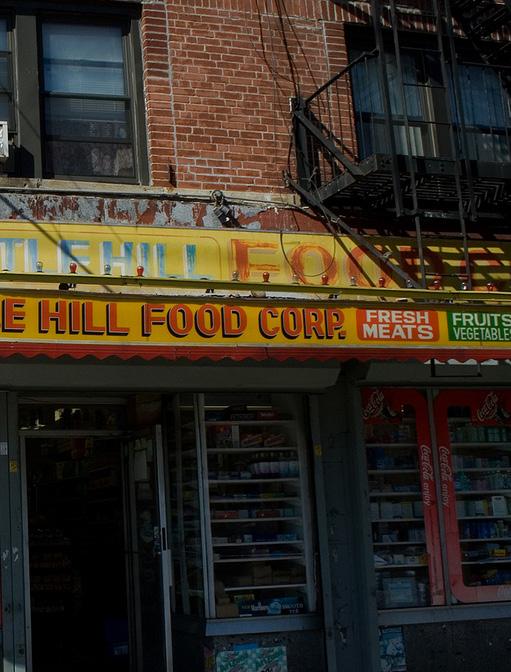
by Talia Lerner
ThisarticlediscussestheinaccessibilityofhealthyfoodintheBronx.Theauthor,TaliaLerner, proposesapartnershipbetweenBronxWorksandlocalbodegastoimproveaccesstonutritiousfood andincreaseconsumerawarenessthrougheducationalinitiativesandmarketingstrategies.

Out of all five boroughs in New York City, The Bronx ranks concerningly high in obesity, poverty, and low educational attainment, according to the NYC Department of Health and Mental Hygiene.1 Poverty and low education rates lead to unhealthy food choices and, ultimately, obesity.2,3 Conversely, affordable products and awareness of nutritional value can elicit healthier food choices.4,5
Since the early 2000s, schools, government entities, and community nonprofits have introduced countless strategies to improve health outcomes in this area, but to little avail. Living healthily in The Bronx is difficult because corner stores, known as bodegas, are the most convenient one-stop shop for Bronxites, but they stock a myriad of primarily unhealthy food.6 While non-profit organizations like BronxWorks work with bodegas to transform their product selections, these small businesses lack the financial incentives to provide healthy consumer
initiatives. Without consumer demand, a switch to healthier food risks lower profit margins, posing a difficult choice for bodega owners.7
To combat obesity in the Bronx, a synergistic partnership between BronxWorks and bodegas can popularize healthy foods while boosting interactive non-profit outreach to educate consumers on the importance of healthy lifestyle changes. This initiative elicits a positive feedback loop, generating profits for bodegas and creating meaningful, sustainable change.
Current measures to enhance the nutritional value of bodega offerings already exist under government initiatives, but problems mitigate their effectiveness. The rules primarily target bodegas that already have refrigeration and other equipment needed to carry perishable goods, ignoring bodegas that lack such infrastructure.8 Additionally, many government policies operate
off the idea that the Bronx is a food desert–it’s not.9 However, according to the National Library of Medicine, it is a food swamp with more access to nutritionally void foods than nutritious foods.10 Bodegas in the Bronx outnumber supermarkets by approximately a 35-1 ratio, and most residents rely primarily on bodegas for their food needs.11,12
BronxWorks and other nonprofits operate alongside government initiatives to promote a healthy Bronx community. Following a lifestyle-based strategy, they lead cooking classes, operate a community kitchen, run farmers’ markets, and hold educational events to encourage sustainable lifestyles in the borough. BronxWorks sometimes reaches out to in-need bodegas to help them transform their product selection. In the past, they’ve helped one store acquire a cooler and aided them in advertising their healthier products, albeit on a small scale.13
Despite initiatives to improve bodega product selections, these

convenience stores still remain notoriously unhealthy. Experts from New York University and the non-profit Bronx REACH found that “the density of corner stores is associated with an increased likelihood of consuming high-energy foods…and an increased risk of obesity among children and adults.”14 This finding dates to 2016, an entire decade after the NYC Department of Health and Mental Hygiene launched its “Healthy Bodegas Initiative.”15
Currently, the interests of BronxWorks directly oppose corner stores; the non-profits seek better health for the community, while bodegas resist change in their interests of keeping revenue flowing. Most corner store owners reference low demand and a lack of refrigeration as two barriers to entry into the healthy food market.16
As a non-profit organization genuinely interested in making a
positive impact on the community, BronxWorks could expand its operations with bodegas to set them up for success through equipment acquisition and produce sourcing. Firstly, they will supply bodegas with the necessary equipment and shelving. Helping bodegas acquire fridges and other storage needs alleviates the fixed-cost burden that otherwise makes bodegas reluctant to switch their stock selection.17
They could also help connect corner stores to affordable produce, focusing on stocking seasonal produce alongside other sourcing to meet related needs. Seasonal produce is cheaper than non-seasonal fruits and veggies and is more likely to come from local farms.18 Besides the economic allure of stores buying local seasonal products for retail, these practices stimulate the local economy and promote sustainable practices.
However, at such a large scale, BronxWorks and bodegas can’t rely solely on local sources. To optimize the
quantity and price of orders, they could use what researcher Sara John calls a dynamic sourcing model in the public health whitepaper, “Balancing Mission and Margins: What Makes Healthy Community Food Stores Successful.”19
Labeled as an identifier of successful healthy stores, this model encourages diverse sourcing to minimize inventory costs or shopping different vendors seeking the best prices on goods to enable competitive pricing.20 Diverse sourcing could include alternative options like gleaned produce – leftover produce that isn’t economically viable for farmers to harvest – and opportunity buys – sales of products at highly reduced rates. In this example, bodegas can source food from local farms, national vendors, gleaned produce, and occasional opportunity buys.
Acquiring equipment for bodega use and helping them source products allows bodegas to possess higherquality stock. On average, these community stores carry lower-quality fruits and vegetables than their
supermarket counterparts.21 Consumers would feel more inclined to purchase corner store produce if it looked appealing at the very least. Bolstering quality will prompt customer satisfaction, which will increase the probability of repeat purchases and benefit the store.
In return for assistance from BronxWorks, bodegas will transform into the exclusive hub for nonprofit resources and serve as mini venues for community events and cooking demonstrations. BronxWorks currently uses non-food-related businesses (e.g., nail salons, laundromats, etc.) as an outlet for pamphlet distributions of the health/wellness resources they offer. Resources include assistance for eligible residents filing for Supplemental Nutrition Assistance Program benefits (SNAP). Offering such posted useful information exclusively to bodegas will retain convenience for consumers and grant more community power to bodegas. People who don’t usually visit bodegas will need to visit them to access this information, thus increasing the store’s foot traffic. At the same time, people who already frequent bodegas will notice these enticing resources and have a greater chance of interacting with the organization.
Bodegas would also provide a
venue for cooking demonstrations and educational events that BronxWorks already holds. Most of BronxWorks’ cooking demonstrations and samplings occur at farmer’s markets and independently hosted events. I suggest they move the bulk of these interactive demonstrations into bodega spaces. They can also hold these events in front of the bodega storefront, weather permitting.
Such demonstrations will teach people how to cook with in-season produce that they may otherwise feel unfamiliar with, de-mystifying unapproachable or hard-tocook vegetables. Situating these demonstrations in or around the bodega storefronts, which carry the included ingredients, will help promote purchasing.
Cooking demonstrations and samples of healthy recipes can effectively encourage people to buy these corner store products. Consumers need to experience first-hand how delicious healthy dishes can taste. A marketing strategy at its core, cooking demonstrations represent an impactful nutritional intervention.
Studies prove that spreading nutritional information alone isn’t enough to enact change.22 Instead, combining informative interventions with modeling and encouragement of “positive ‘to-do’ behaviors”23 has the potential to create successful

change in fruit and vegetable intake. Another study from the Society for Nutrition Education and Behavior demonstrates the favorable effects of cooking demonstrations on dietary intake, nutritional education, and health outcomes. In agreement with this proposal, these researchers emphasize the need for community leaders to more astutely address economic barriers (like the price of food) to ensure effective results.24
Furthermore, bodegas should reincorporate past small-scale successful advertising strategies to market its stock effectively. A “Don’t Stress, Eat Fresh” marketing campaign from 2018 to 2019, led by Bronx Bodega Partners Workgroup, launched various advertisements in and around bodegas to encourage healthy eating.25 MESH Design and Development, the chosen design firm, created the joint marketing campaign with input from community voices. They created ads on public fixtures, buses, and geofencing around stores. Metrics gathered from the geofencing revealed an above-average level of interaction with the locationbased digital advertisements.
The participating bodegas also saw increased sales from the “Don’t Stress, Eat Fresh” project. Los Hermanos Bodega experienced a 50 percent increase in purchases after shifting to produce alongside this marketing campaign.26 Other government initiatives reported increased sales by participating bodegas.27 Advertised products led to an increase in purchases and profits compared to non-advertised products.28 This proves that bodegas can collect profits from healthy food – a crucial point for the initiative’s success. Bodega owners will only undergo inventory makeovers if they can see additional profit or, at the very least, avoid losses.29
This innovative, bodega-benefiting campaign occurred on a small scale; 53 bodegas participated in in-store advertisements. Approximately 15 of these 53 participated in the geofencing initiative. Expanding this virtual advertising strategy to include more
stores in the future may produce similar levels of engagement and encourage dietary improvements.
As part of the initiative, bodegas might also slowly increase the prices of select unhealthy foods to force buyers away from health-harming products. As bodegas shift to varied product selections, they might also incrementally increase prices for unhealthy products and place nearperfect substitutes beside them; for example, they might place grilled chicken breast meat near deli chicken meat and sweet fruit varieties like mangoes or bananas next to sugar-laden fruit products. Customers, noticing these price changes alongside marketed healthier alternatives, will be further incentivized to choose the latter.
Within this narrative lies a major benefit for sustainable bodegas: they can capture a growing market share of
On a side note, bodega owners also make up a part of the community. Unlike big corporations and food chains, they’re small business owners living in the Bronx. Therefore, they possess an innate “need and desire for a store to increase healthy food access.”31 While their businesses hinge on profits, the desires of small businesses overlap with community well-being– they just need to realize the possibility of achieving both profits and food access.
When working with bodegas of the Bronx, BronxWorks needs to keep a few things in mind. Corner stores make up a key stakeholder in the borough, integral to the community’s collective identity and culture. Clear and continuous recognition of the
consumers on the importance of healthy eating to drive them to purchase fresh foods. Bodegas know that if they stock fresher food, they must have appropriate consumer demand. BronxWorks knows that if they elicit these changes in bodegas, they must work harder to educate consumers to avoid bodega disenfranchisement -something they’re already interested in and actively embarking on. By doing these two things together, both sides achieve happiness and attain a clear incentive to do their part in this cooperative mission.
Another point to consider for BronxWorks outreach relates to the cultural authenticity of bodegas. Established by the Hispanic community, bodegas represent so much more than a corner store; they symbolize diversity, unity, and belonging. BronxWorks mustn’t
“...PARTNERSHIP
health-minded consumers. One bodega that expanded its selection to fresh salads in 2018 calls growing consumer demand the catalyst for this new offering.30 Other stores that introduced nutritious food alongside marketing support saw increased sales from the stakeholder value created. Healthy food and profits are not mutually exclusive.
Should the government continue nutritional literacy programs alongside the interactive model offered by BronxWorks, people will feel increasingly drawn to healthy products. Plus, the dangers of diseases related to obesity already circulate through school health classes, nonprofit mission statements, and widely-read NYC government statistics. It is the age of public health awareness, and bodegas must respond to this collective community stakeholder sentiment.
“unbreakable bond” bodegas have with the community must occur to effectively value their existence and work with them, not against them.32 When nonprofits try to scale, their “branches” should “grow down and out” to foster a foundation for subsequent outward scaling.33 If BronxWorks tries to scale its bodega initiatives without establishing personal connections with bodega owners, it will fail to grow outwards. Regular meetings with bodega owners and listening to their unique values and interests will make corner stores feel supported, not attacked.
By establishing a deeper relationship with bodegas, BronxWorks can reach a common ground with them and find a confluence of interests. In this scenario of synergistic interests, BronxWorks and bodegas can unite by educating
alienate certain demographics by removing access to culturally significant products deemed “unhealthy.” Instead, they should make sure cooking demonstrations shine a light on beloved cultural dishes in the community. At the same time, they can suggest how to prepare them in healthier ways for disease prevention.
To include other stakeholders in the discussion, BronxWorks should encourage a variety of cultural groups to volunteer to keep content geared towards the diverse borough. A variety of faith and ethnic-based collectives in the Bronx have interests in improving health.34 In line with this big idea of connecting with outreach targets, regular community meetings with different cultural community leaders (supplementary to the aforementioned bodega-owner meetings) ensure all

stakeholders feel heard and appreciated. Other stakeholders include healthcare facilities and schools. Both of these entities support healthy eating initiatives. Hospitals provide obesity treatment programs and healthy lifestyle training, including NYC Health + Hospitals’ bariatric services and Lifestyle Medicine Programs. Schools make efforts to provide healthier lunches and teach nutritional education. Efforts to combat obesity through this proposal may alleviate some financial and social burdens these entities currently face in combating the epidemic.
Similar to many sustainability
ventures, this initiative includes startup costs for store equipment, new food sourcing, and marketing efforts. Government grants and investors can help provide a main source of funding for these expenses. Additionally, BronxWorks must expand its volunteer force and staff to meet the demands of such growing outreach. If bodegas seek gleaned produce and opportunity buys, additional trained employees will need to work on scouting deals from local and national vendors. Bodega owners might also acquire sourcing and procurement training from BronxWorks experts and conduct these steps themselves.
Because of the nature of the issue, results from this initiative will take many years to show. Statistics
1. How might government support this initiative?
2. What are the challenges to this initiative?
regarding obesity itself cannot improve overnight; permanent weight loss is a long lifestyle process, and establishing healthy habits doesn’t happen overnight. It may take generations to break the current obesity trend because of its deep connection to systemic socioeconomic disparities.
Nevertheless, we can track changes by carefully evaluating buying habits, consumer purchasing power, and revenues. Are people buying more produce, whole grains, and legumes? Do they have more choices when considering their budget constraints? Are bodega revenues increasing or decreasing, and can this change be attributed to nutritious food purchases?
In conclusion, this proposal creates a deeper relationship between bodegas and BronxWorks through synergistic activities. BronxWorks will take measures to help bodegas introduce healthy products and promote on-site interactive marketing. Bodegas will advertise BronxWorks resources, increasing store foot traffic and outreach for the non-profit. These efforts will effectively change the buying habits of corner-store-reliant consumers, promoting good health and obesity mitigation over time. In such a scenario, calls to action for sustainability converge with the bodega’s interest in business prosperity.
3. In addition to gleaned produce and opportunity buys, what other approaches may reduce costs for bodegas?
1 Naidoo M, Traore K, Culp G, King L, Lopez C, Hinterland K, Gould LH, Gwynn RC. “CommunityHealthProfiles2018MapAtlas;TheNew YorkCityDepartmentofHealthandMentalHygiene,” 2018.
2 Millar, Helen. “What to Know About Obesity and Poverty.” Medical News Today, MediLexicon International, 25 Apr. 2023, www.medicalnewstoday.com/articles/obesity-andpoverty#:~:text=What%20to%20know%20about%20obesity%20 and%20poverty&text=Research%20suggests%20poverty%20has%20 links,time%20to%20engage%20in%20exercise.
/ TALIA LERNER
3 Sart, Gamze, et al. “Impact of Educational Attainment and Economic Globalization on Obesity in Adult Females and Males: Empirical Evidence from BRICS Economies.” Frontiers, Frontiers, 30 Jan. 2023, www.frontiersin.org/journals/public-health/articles/10.3389/ fpubh.2023.1102359/full.
4 Kern, David M, et al. “Neighborhood Prices of Healthier and Unhealthier Foods and Associations with Diet Quality: Evidence from the MultiEthnic Study of Atherosclerosis.” International journal of environmental research and public health vol. 14,11 1394. 16 Nov. 2017, doi:10.3390/
ijerph14111394.
5 Mackenbach, Joreintje Dingena. “Healthy Eating: A Matter of Prioritisation by Households or Policymakers?: Public Health Nutrition.” Cambridge Core, Cambridge University Press, 26 Feb. 2021, www.cambridge.org/ core/journals/public-health-nutrition/article/healthy-eating-a-matter-ofprioritisation-by-households-or-policymakers/6D5AEC30531ABE0C70 C8810883397E30.
6 Kiszko, Kamila, et al. “Corner Store Purchases in a Low-Income Urban Community in NYC.” Journal of Community Health vol. 40,6 (2015): 1084-90. doi:10.1007/s10900-015-0033-1.
7 Dannefer, Rachel, et al. “Healthy bodegas: increasing and promoting healthy foods at corner stores in New York City.” American Journal of Public Health vol. 102,10 (2012): e27-31. doi:10.2105/ AJPH.2011.300615
8 NYC Department of Health and Mental Hygiene. “CEO Internal Program Review Report” for the Healthy Bodega Initiative.” DOHMH, 2008. https://www.nyc.gov/assets/opportunity/pdf/BH_PRR.pdf.
9 Elbel, Brian, et al. “Assessment of a Government-Subsidized Supermarket in a High-Need Area on Household Food Availability and Children’s Dietary Intakes.” Public Health Nutrition 18.15 (2015): 2881–2890. Web.
10 Cookesey-Stowers et al. “Food Swamps Predict Obesity Rates Better Than Food Deserts in the United States.” National Library of Medicine, November 2017. https://www.mdpi.com/1660-4601/14/11/1366.
11 Rozner, Lisa. “‘Food Deserts’ Remain Big Problem in More than 2 Dozen New York City Neighborhoods.” CBS News, CBS Interactive, 13 June 2022, www.cbsnews.com/newyork/news/food-insecurity-remains-bigproblem-in-more-than-2-dozen-neighborhoods-in-new-york-city/.
12 Mackenbach.
13 “As Part of an Effort to Combat Obesity and Diabetes in Low-Income Communities, City Harvest and Bronxworks Help a Local Bodega Purchase a Cooler.” BronxWorks, 12 May 2021, bronxworks. org/2019/04/30/as-part-of-an-effort-to-combat-obesity-and-diabetesin-low-income-comunities-city-harvest-and-bronxworks-help-a-localbodega-purchase-a-cooler/.
14 Kiszko.
15 NewYorkCityHealthyBodegasInitiative, www.nyc.gov/assets/doh/ downloads/pdf/cdp/healthy-bodegas-rpt2010.pdf. Accessed 7 Dec. 2024.
16 Kiszko.
17 Ibid.
18 “What Produce Is in Season during the Winter Months?” OSF HealthCare, 26 Oct. 2022, www.osfhealthcare.org/blog/produce-in-season-duringthe-winter/.
19 John, Sara, et al. “Balancing Mission and Margins: What Makes Healthy Community Food Stores Successful.” International journal of environmental research and public health vol. 19,14 8470. 11 July. 2022, doi:10.3390/ijerph19148470.
20 Ibid.
21 “Online Food Shopping Exploded during the COVID-19 Pandemic. Can It Catch on with Bodegas?” NYU Steinhardt, Center of Health
and Rehabilitation Research, 8 Jan. 2024, www.nyu.edu/about/newspublications/news/2024/january/online-food-shopping-exploded-duringthe-covid-19-pandemic--can-.html.
22 Pem, Dhandevi, and Rajesh Jeewon. “Fruit and Vegetable Intake: Benefits and Progress of Nutrition Education Interventions - Narrative Review Article.” Iranian Journal of Public Health vol. 44,10 (2015): 1309-21.
23 Ibid.
24 Apatu, Emma, et al. “Cooking Classes: Are They Effective Nutrition Interventions in Low-Income Settings?” Journal of Nutrition Education and Behavior, Elsevier, 1 July 2016, www.jneb.org/article/S14994046(16)30139-7/fulltext.
25 Jay, Mikey. “Bronx Bodega Partners Workgroup Don’t Stress, Eat Fresh Marketing Campaign.” Institute, NYC Department of Health and Mental Hygiene, 31 May 2019, institute.org/wp-content/uploads/2019/05/ BBWDontStressEatFreshCampaign1-pagerBxDelegationApril2019.pdf.
26 Moura, Paula. “Ad Campaign Helps Bodegas Promote Healthy Food.” Mott Haven Herald, Craig Newmark Graduate School of Journalism, 12 Mar. 2018, motthavenherald.com/2018/02/25/ad-campaign-helpsbodegas-promote-healthy-food/.
27 Kiszko, Kamila et al.
28 Mikołajczak-Degrauwe, Kalina, and Malaika Brengman. “The influence of advertising on compulsive buying - The role of persuasion knowledge.” Journal of behavioral addictions vol. 3,1 (2014): 65-73. doi:10.1556/JBA.2.2013.018.
29 Healthy Bodegas (HB) A Program of the New York City Department of Health & Mental Hygiene (DOHMH): CEO Internal Program Review Summary, New York City Department of Health & Mental Hygiene, 23 Feb. 2010.
30 Pem, Dhandevi, and Rajesh Jeewon.
31 “What Produce Is in Season during the Winter Months?” OSF HealthCare, 26 Oct. 2022, www.osfhealthcare.org/blog/produce-in-season-duringthe-winter/.
32 “Bodegas in New York City: A Rich Tapestry of History and Culture.” NYC Moments, 23 Jan. 2024, nycmoments.nyc/nyc-culture/bodegasnew-york-city-rich-history-culture/#:~:text=Bodegas%20in%20 NYC%20Culture,beside%20Eastern%20European%20canned%20 goods.
33 Nardini, G., Bublitz, M. G., Butler, C., Croom-Raley, S., Edson Escalas, J., Hansen, J., & Peracchio, L. A. (2022). Scaling Social Impact: Marketing to Grow Nonprofit Solutions. Journal of Public Policy & Marketing, 41(3), 254-276. https://doi.org/10.1177/07439156221087997.
34 “Faith-Based Outreach Initiative.” The Institute for Family Health, Bronx REACH, institute.org/bronx-health-reach/our-work/faith-basedoutreach-initiative/. Accessed 4 May 2024.
Photo Credits:
• Wikiwiki718/Wikimedia Commons–Page 12
• Jeff/AdobeStock–Page 14
• Silvio Pacifico/Bronx Times–Page 16, 18

“When looking over the 17 SDGs, I was inspired and intrigued by “good health and well-being.” As someone committed to letting passion fuel all my academic endeavors, I geared my project towards this SDG to captivate my business interests and interest in physical wellness. Dietary issues in the Bronx require a multi-disciplinary solution, transcending just food or economic policy.”


By Jeffrey Gao
AuthorJeffreyGAo’spAperexplores A sustAinAble ApproAchtopAlmoilproduction. heproposes intercroppinGoilpAlmswithcAcAotrees,whichcAnreduceenvironmentAl dAmAGe,suchAsdeforestAtion AndbiodiversitylosswhileofferinGeconomicbenefits.

Palm oil seeps into our everyday lives, from things like chocolate and shampoo to others such as lipstick and biofuel. Today, it is the most popular vegetable oil in the world, found in over 50 percent of supermarket packaged products.1 Unfortunately, because oil palms grow in tropical climates, farmers often destroy tropical forests to clear land for oil palm plantations. Consequently, the expansion of these plantations has become the largest driver of deforestation in Indonesia–the world’s premier palm oil producer–accelerating climate change and threatening endangered species.2 Korindo, a Korean-Indonesian conglomerate that operates eight plantations, is a major contributor to this issue.3 In 2018, Greenpeace accused the company of clearing 11,120 hectares (approximately 43 square miles) of forests across five plantations.4 The worst occurred at PT Papua Agro Lestari (PAL), Korindo’s plantation in Indonesia’s Boven Diogel Regency, where the company destroyed 5,190 hectares of forests, an area the size of Manhattan.5 Palm oil producers like Korindo face few incentives to slow their expansion because they do not bear the full costs of deforestation. Meanwhile, existing solutions, such as certification programs, struggle
to balance the interests of palm oil producers, environmental activists, and other stakeholders.
To prevent further deforestation in PT PAL, Korindo can intercrop oil palms with cacao trees, boosting the company’s overall yield without expanding its land use. By growing both crops on the same land, Korindo also creates a more biodiverse ecosystem that is better at sequestering carbon, reducing the externalized impacts of palm oil production. With the recent surge in cocoa prices, this strategy is sustainable but has become economically viable as well, opening a new opportunity for Korindo to alleviate the environmental impacts of palm oil production.
The expansion of oil palm plantations releases significant greenhouse gas emissions, accelerating climate change. Many forests cleared by Korindo lie on carbonrich peatlands, which release vast amounts of CO2 into the atmosphere when drained. From 2013 to 2015, the increase in land used for palm oil production contributed 1.4 percent of global CO2 emissions, releasing an average of 500 million tons of CO2 emissions per year.6 The resulting climate change disproportionately impacts Indonesia, with the World Bank estimating that rising sea levels will submerge 95 percent of Jakarta’s coastal areas by 2050.7 Yet, neither palm oil producers nor consumers face the costs of frequent natural disasters and rising sea levels. Instead, the Indonesian government and its people bear these costs.
Beyond CO2 emissions, palm oil deforestation also severely impacts biodiversity, threatening at least 193 species on the International Union for Conservation of Nature (IUCN) Red List of Threatened Species.8 Orangutans are one of the most affected, as lowland forests, their primary habitat, are ideal locations for oil palm plantations due to their flat topography and fertile soils.9 After decades of palm oil deforestation, Indonesia’s Sumatran Orangutan is now a critically endangered species,
numbering fewer than 15,000.10
Beyond environmental consequences, this loss of biodiversity harms Indonesia’s ecotourism industry, which represents 35 percent of the country’s tourism sector.11 A decline in tourism, which accounts for nearly 5 percent of Indonesia’s GDP, would hinder the country’s economic development and increase rural unemployment.12
Nevertheless, palm oil producers continue to build new plantations in lowland forests as they reap the economic benefits of the land without incurring environmental and social costs. This dynamic enables them to sell palm oil at reduced prices, further driving demand for their unsustainable production practices.
Existing solutions, such as the Roundtable on Sustainable Palm Oil’s (RSPO) certification program, struggle to balance the diverse interests of the stakeholders involved. However, producers argue that the cost of obtaining the certification outweighs any benefits gained from a higherpriced “certified designation.”13
Economist Yu Leng Khor estimates that the price premium for certified sustainable palm oil (CSPO) is only between $2.50 and $3.50 per tonne, negligible compared to palm oil’s current price of $863 per tonne.14 As such, only 20 percent of global palm oil production is certified, and Korindo has yet to become an RSPO member.15 Palm oil producers lack the economic incentives to seek RSPO Certification, limiting the program’s efficacy.
This low adoption rate places the RSPO in a dilemma between lowering or raising its certification standards. On one hand, environmental groups such as Greenpeace criticize the RSPO for allowing producers to signal sustainability without meaningfully changing their practices; over half of the palm oil producers accused of deforestation are members of the RSPO.16 On the other hand, enforcing strict standards to satisfy environmental groups could further drive palm oil producers away from becoming RSPOcertified, particularly smallholders who
“lack both the information and the degree of organization that certification demands.”17 Their small scale means that certification costs would consume between 5 and 14 percent of their revenue.18 If the RSPO agrees to environmental groups’ demands, it risks barring smallholders from certification, further hindering the program’s adoption.
Although the RSPO Certification attempts to mitigate the industry’s externalized costs through sustainability standards, it fails to alter the misaligned incentive structure that drives continued deforestation. Smallholders lack the resources to obtain certification, and larger companies like Korindo have few financial reasons to pursue it. To address this shortcoming, intercropping oil palms with cacao trees presents an environmentally and economically effective solution.
Environmentally, Korindo can implement this strategy to utilize its existing land in PT PAL more efficiently. Both oil palms and cacao trees thrive in similar climates: high temperatures, humidity, and rainfall, as found in PT PAL.19 The two crops do not compete for the same resources – oil palms require full sunlight, whereas cacao trees thrive in partial shade – so planting shorter cacao trees next to taller oil palms would not disrupt the growth of either crop.20 A recent study found that an oil palm and cocoa intercrop achieved a high land equivalent ratio (LER) of 1.44.21 In other words, if Korindo cultivates oil palms and cacao trees on separate plots, it would require 44 percent more land to achieve the same yield as it would by growing both crops on the same plot. Therefore, the company can boost its overall yield without requiring additional land.
Beyond the environmental benefits
of efficient land use, intercropping oil palms with cacao trees would also allow Korindo to capitalize on the recent surge in cocoa prices. Heavy rains and disease outbreaks have significantly disrupted cocoa production in the Ivory Coast and Ghana, which together produce 60 percent of the world’s cocoa supply.22 This supply shock has driven cocoa prices up to $10,282 per tonne, nearly quadrupling from last year.23 In contrast, palm oil prices have remained relatively stable at $863 per tonne.24 Consequently, based on the yield per hectare of each crop, a hectare of land now generates $6837 producing cocoa, compared to $2943 producing palm oil.25 By converting a portion of PT PAL from palm oil cultivation to cocoa production, Korindo could maximize its revenue without expanding its land use.
Assessing whether this strategy will increase profitability is more challenging, as the costs depend on Korindo’s implementation and local market conditions. However, given the similarities in cultivation inputs between oil palms and cacao trees, the two crops have comparable unit economics. A study conducted in
Indonesia’s Asahan Regency found that palm oil and cocoa production had gross margins of 76 and 79 percent, respectively, over 25 years.26 If Korindo executes the strategy effectively, it can boost revenue and improve overall profitability while promoting environmental responsibility.
Korindo’s plantation workers also benefit from more stable and diversified income sources. With a correlation coefficient of 0.05 over the past year, palm oil and cocoa prices are virtually uncorrelated.27 This property could protect farmers against crop-specific risks, as a drop in the price of palm oil could be counteracted by a surge in cocoa prices and vice versa. Moreover, the strategy also creates a steady flow of work since the peak harvest season for palm oil is from August to September, while cocoa harvests occur from March to July and again from September to December.28 By maintaining both oil palms and cacao trees, Korindo and its workers have harvests almost year-round, granting a steady stream of income.
Consumer goods companies that buy palm oil from Korindo would also benefit from more streamlined and resilient supply chains. Because palm


oil and cocoa are often found together in products like chocolate, many palm oil buyers also purchase cocoa. Eight of the eleven major consumer goods companies that buy Korindo’s palm oil also use cocoa in their products.29 Instead of relying on separate suppliers, companies could source both ingredients from Korindo, simplifying their supply chains. Additionally, these companies would have a more reliable supplier, as intercropping enhances resilience to pests and diseases such as the cacao swollen shoot virus (CSSVD), a leading cause of the current cocoa shortage.30 The shade that oil palms provide for cacao trees reduces the severity of the disease,
with one study showing that even only 54 percent shade minimizes CSSVD symptom severity.31 If Korindo plants cacao trees next to oil palms, the cacao trees in PT PAL would be less susceptible to the same disease that disrupted cocoa production over the past year, allowing consumer goods companies to mitigate the risk of supply shocks.
Despite these benefits, there are risks associated with intercropping oil palms and cacao trees. Cultivating two crops simultaneously complicates crop management and requires specialized expertise. Sari Himanen, Senior Scientist at Finland’s Ministry of Agriculture and Forestry, emphasizes that successful intercropping requires “better knowledge on the optimal mixtures for specific production goals and local conditions.”32 To bridge these knowledge gaps, Korindo would need to invest resources into training and developing its plantation workers. Additionally, it takes three to five years for a cacao seed to mature into a cacao tree capable of producing cocoa.33 During this period, cocoa prices could drop to a point where intercropping becomes unprofitable for Korindo, especially after factoring in the initial investment in training employees and cultivating cacao trees. However, Korindo can mitigate this risk by
selling cocoa futures and locking in a price at which it agrees to deliver cocoa in the future. For instance, the company can sell cocoa futures expiring May 2025 to secure a selling price of $7,885 per tonne a year from now.34 At this price point, producing cocoa still generates more revenue per hectare than palm oil. With these tactics, Korindo can optimize its land use, mitigate financial risks, and ensure a return on sustainable investment.35 Ultimately, by aligning economic interests with environmental goals and reducing externalized impacts, this strategy can balance the interests of different stakeholders and succeed where existing solutions have failed. For Korindo, the strategy allows the company to optimize the use of its existing land in PT PAL, reducing the need for further deforestation and capitalizing on the current cocoa shortage. Plantation workers can also diversify their income streams and gain stable, year-round employment. Meanwhile, consumer goods companies gain the opportunity to simplify and strengthen their supply chains. In these ways, the proposal corrects the failures of existing solutions, creating shared value for the palm oil industry’s diverse stakeholders.36
1. What “misaligned incentive structure” continues to drive deforestation?
2. What prevents governments from passing regulations restricting behaviors that lead to deforestation?
3. What other attempts have been made to curtail deforestation? How have they succeeded or failed?
1 “8 Things to Know about Palm Oil.” WWF, www.wwf.org.uk/updates/8things-know-about-palm-oil. Accessed 7 Apr. 2024.
2 Austin, Kemen G, et al. “What causes deforestation in Indonesia?” Environmental Research Letters, vol. 14, no. 2, 1 Feb. 2019, https://doi. org/10.1088/1748-9326/aaf6db.
3 Bellantonio, Marisa, et al. “Burning Paradise: Palm Oil in the Land of the Tree Kangaroo.” MightyEarth, Mighty Earth, stories.mightyearth.org/ burning-paradise/index.html. Accessed 5 May 2024.
4 Greenpeace International, 2018, Final Countdown, https://www. greenpeace.org/international/publication/18455/the-final-countdownforests-indonesia-palm-oil/. Accessed 5 May 2024.
5 Ibid.
7 The World Bank Group, 2021, Climate Risk Country Profile: Indonesia, https://www.adb.org/sites/default/files/publication/700411/climate-riskcountry-profile-indonesia.pdf. Accessed 7 Apr. 2024.
8 Meijaard, E., et al. Oil Palm and Biodiversity: A Situation Analysis by the IUCN Oil Palm Task Force, 26 June 2018, https://doi.org/10.2305/iucn. ch.2018.11.en.
6 Searle, Stephanie. “Palm Oil Is the Elephant in the Greenhouse.” The International Council on Clean Transportation, 6 June 2018, theicct.org/ palm-oil-is-the-elephant-in-the-greenhouse/.
9 Jonas, Holly, et al. International Institute for Environment and Development, 2017, Https://Www-Arcusfoundation-Org. S3.Amazonaws.Com/Wp-Content/Uploads/2017/08/12605IIED.Pdf, https://www-arcusfoundation-org.s3.amazonaws.com/wp-content/ uploads/2017/08/12605IIED.pdf. Accessed 5 May 2024.
10 “Sumatran Orangutan.” World Wildlife, www.worldwildlife.org/species/ sumatran-orangutan. Accessed 7 Apr. 2024.
11 Ollivaud, Patrice, and Peter Haxton. “Making the most of tourism in Indonesia to promote sustainable regional development.” OECD Economics Department Working Papers, 7 Feb. 2019, https://doi. org/10.1787/18151973.
12 BPS-Statistics Indonesia, 2023, IndonesianEconomicReport, 2023, https://www.bps.go.id/id/publication/2023/09/21/ a62efbad86d18bc35581c33a/laporan-perekonomian-indonesia-2023. html. Accessed 5 May 2024.
13 “Does the RSPO Have a Future?” Thepalmoil.Com, 13 Jan. 2021, www. thepalmoil.com/does-the-rspo-have-a-future/.
14 Yu, Lengkhor. 2020, Sustainable Palm Oil: Trade and Key Players between Indonesia and China, https://www.proforest.net/fileadmin/ uploads/proforest/Documents/Publications/sustainable-palm-oil_tradebetween-indonesia-and-china-1-2-1.pdf. Accessed 7 Apr. 2024.
15 Yeo, Carol. “ACOP 2022: CSPO Production Hits 15 Million Mt Milestone.” Roundtable on Sustainable Palm Oil (RSPO), 29 Sept. 2023, rspo.org/acop-2022-reports-continued-progress-in-cspo-productionand-consumption-despite-global-disruptions-cspo-production-hits-15million-mt-milestone/.
16 Greenpeace International, 2018, Final Countdown, https://www. greenpeace.org/international/publication/18455/the-final-countdownforests-indonesia-palm-oil/. Accessed 5 May 2024.
17 Brandi, Clara, et al. “Sustainability Standards for Palm Oil: Challenges for Smallholder Certification Under the RSPO.” The Journal of Environment&Development, vol. 24, no. 3, 22 July 2015, pp. 292–314, https://doi.org/10.1177/1070496515593775.
18 Yu, Lengkhor. 2020, Sustainable Palm Oil: Trade and Key Players between Indonesia and China, https://www.proforest.net/fileadmin/ uploads/proforest/Documents/Publications/sustainable-palm-oil_tradebetween-indonesia-and-china-1-2-1.pdf. Accessed 7 Apr. 2024.
19 “Growing Cocoa.” InternationalCocoaOrganization, International Cocoa Organization, 14 Sept. 2021, www.icco.org/growing-cocoa/.
20 Ibid.
21 Khasanah, Nikmatul, et al. “Oil Palm Agroforestry Can Achieve Economic and Environmental Gains as Indicated by Multifunctional Land Equivalent Ratios.” FrontiersinSustainableFoodSystems, vol. 3, 21 Jan. 2020, https://doi.org/10.3389/fsufs.2019.00122.
22 Kimball, Spencer. “Cocoa Prices Are Soaring to Record Levels. What It Means for Consumers and Why ‘the Worst Is Still Yet to Come.’” CNBC, CNBC, 26 Mar. 2024, www.cnbc.com/2024/03/26/cocoa-pricesare-soaring-to-record-levels-what-it-means-for-consumers.html.
23 Refinitiv. Accessed 26 April 2024.
24 Ibid.
25 Fahmid, I M, et al. “Competitiveness, production, and productivity of
cocoa in Indonesia.” IOPConference Series: Earth and Environmental Science, vol. 157, May 2018, pp. 12–67, https://doi.org/10.1088/17551315/157/1/012067.
26 Nasution, S. K., Supriana, T., Pane, T. C., & Hanum, S. S. (2019). Comparing farming income prospects for cocoa and oil palm in Asahan District of North Sumatera. IOPConference Series: Earth and Environmental Science, 260(1), 012006.
27 Refinitiv.
28 Christina, Bernadette, and Fransiska Nangoy. “Indonesia Palm Oil Industry Urges Government to Ease Export Curbs as Harvest to Worsen Oversupply.” Reuters, Reuters, 15 July 2022, www.reuters.com/markets/ commodities/indonesia-palm-oil-industry-urges-govt-ease-export-curbsharvest-worsen-2022-07-15/.
29 Greenpeace International.
30 Kimball, Spencer.
31 Andres, Christian, et al. “Agroforestry systems can mitigate the severity of cocoa swollen shoot virus disease.” Agriculture,Ecosystems& Environment, vol. 252, Jan. 2018, pp. 83–92, https://doi.org/10.1016/j. agee.2017.09.031.
32 Himanen, Sari, et al. “Engaging farmers in climate change adaptation planning: Assessing intercropping as a means to support farm adaptive capacity.” Agriculture, vol. 6, no. 3, 29 July 2016, p. 34, https://doi. org/10.3390/agriculture6030034.
33 Stevens, Alison Pearce. “How to Grow a Cacao Tree in a Hurry.” Science NewsExplores, Science News Explores, 3 Dec. 2019, www.snexplores. org/article/how-grow-cacao-tree-hurry.
34 Refinitiv.
35 “Return on Sustainability Investment (ROSITM) Methodology.” NYU Stern Center for Sustainable Business, NYU Stern Center for Sustainable Business, www.stern.nyu.edu/experience-stern/about/ departments-centers-initiatives/centers-of-research/center-sustainablebusiness/research/return-sustainability-investment-rosi. Accessed 5 May 2024.
36 Porter, Michael E., and Mark R. Kramer. Harvard Business Review, 2011, pp. 62–77, CreatingSharedValue.
Photo Credits:
• Olga/AdobeStock–Page 21
• Junaidi Hanafiah/Wikimedia Commons–Page 22
• Tanarch/AdobeStock–Page 23
• Mercury Studio/AdobeStock–Page 24

“The most surprising part of my research was realizing that intercropping isn’t just environmentally friendly—it actually makes better financial sense for producers... Interviewing the high school alum who first introduced me to this issue was especially rewarding; it felt full circle, as his insights brought my research to life and deepened my understanding of sustainable solutions.”

Joint Liability Groups, Social Impact
Bonds, and Synchronized Repayments
Author Aryan Luniya highlights how tailored financial mechanisms, such as Joint Liability Groups, Social Impact Bonds, and synchronized repayment schedules, can improve microfinance access and support socioeconomic development in rural Rajasthan. The paper suggests that aligning financial services with local conditions, such as agricultural cycles, can reduce default rates and foster sustainable growth.

The rural areas of Rajasthan experience severe financial marginalization, which hinders socioeconomic growth. In other words, many people do not have access to basic financial services, which negatively impacts the growth of agriculture and entrepreneurship. Due to their restricted lending capabilities, microfinance institutions (MFIs) frequently struggle to satisfy the demand for credit in rural areas. To improve financial inclusion in these locations, this essay looks into novel financial mechanisms that could strengthen the capabilities of MFIs. With synchronized repayment plans emerging as the most viable solution, the essay evaluates the implementation of Joint Liability Groups (JLGs), Social Impact Bonds (SIBs), and repayment plans synchronized with agricultural output cycles to successfully increase credit availability and foster socioeconomic development of Rajasthan’s rural communities.
A Joint Liability Group, or JLG, is a small organization of 4-10 individuals who mutually guarantee each other’s loans from a bank. The JLG offers an effective method of reducing loan defaults and directly impacting the availability of microfinance funding since loan success is based on the principle of borrowers in a particular rural setting holding each other accountable. According to the National Bank for Agriculture and Rural Development (NABARD), India’s overall growth rate stands at 44.86 percent in terms of the number of JLGs formed and 60.73 percent in terms of JLG loans disbursed in the past decade.1 While this group solution has already been implemented, there is still room for expansion. Since this is a model that has been tested already, it reduces the level of risk when it is applied to different settings across and outside India.

The JLGs that Arth Microfinance, a local microfinance institution in Rajasthan, has established are a prime example of generating shared value in microfinance. Economist Michael E. Porter explains, “Creating shared value, not just profit per se, must be the redefined purpose of the corporation.”2 By using JLGs in a manner that engages borrowers and creates a sense of social security, Arth Microfinance has strengthened its own financial sustainability and improved community welfare by strategically converting a societal need into a business opportunity.3 Ruchi Mitra, a director at Arth Microfinance, posits, “In Rajasthan’s remote villages like Barmer and Sikar, the problem isn’t just the absence of banking facilities but also the cultural norms that discourage women from engaging with financial institutions.”4 This credit not only helps poor women to grow economically but also improves gender equality, the status of women within the family, their health, and their education level -- thus creating shared value.5
The use of JLGs is especially important in Rajasthan’s rural hinterlands. Here, old informal credit systems frequently trap the impoverished in debt, and there are few regular banking services available. Nearly 4,000 villages in the state, each with populations of over 2,000, lack banking facilities, leaving out a large chunk of people from accessing the benefits of financial services.6
To combat this, Porter suggests that “Corporations can generate shared value by implementing policies and operating practices that enhance a company’s competitiveness while simultaneously advancing the economic and social conditions in the communities in which it operates.”7 The incorporation of JLGs into this socioeconomic environment creates a compelling story of shared values, in which social improvement is both the engine and the beneficiary of economic progress, and aligns with Porter’s theory that long-term economic growth requires the alignment of corporate and societal interests.8
The Return on Sustainability
Investment framework (ROSI), a tool from the NYU Stern Center for Sustainable Business, can be utilized in the context of Arth Microfinance to determine the concrete effects of JLGs on the organization and the community.9 Because members of a JLG have a mutual stake in one another’s creditworthiness, these effects range from better risk management to increased operational efficiency due to lower default rates and more efficient loan distribution procedures. A statement in line with ROSI principles was made during my interview with Arth Finance Director Ruchi Mitra, who said, “Our adoption of JLGs has resulted in remarkable repayment success due to trust, which is critical for our ability to extend further credit and stabilize our financial position.”10
Stronger communal relationships can result in operational efficiencies and social license, and these improved community ties translate into trust. In rural financial systems, where information asymmetry and efficient resource allocation challenges persist, trust is a vital resource. Strong community ties, made possible by JLGs, lead to a trust economy that eases the flow of resources and financial services and is essential to the success of any microfinance program.
Arth’s JLG model exemplifies a careful analysis of the area’s socioeconomic structure and a customized financial solution that fosters economic empowerment. This approach has a twofold advantage: members of a JLG are motivated to maintain group financial accountability, which creates a link between social cohesion and economic viability. Due to its provision of financial inclusion, this approach automatically complies with Sustainable Development Goal 1, No Poverty, and Sustainable Development Goal 8, Decent Work and Economic Growth, which promotes self-sufficiency and microenterprise. While JLGs have demonstrated substantial benefits in promoting financial inclusion and community cohesion, they are not without drawbacks. One significant disadvantage is the potential for increased social tension and conflict among group members. This arises particularly when individual members fail to meet their financial obligations, burdening others within the group to cover the shortfall. While this collective responsibility model effectively reduces default rates, it can strain interpersonal relationships and lead to social ostracization or even conflict.
Implicit bias, too, is inherent in human decision-making. As discussed by Anthony Greenwald in his exploration of implicit associations, such bias can influence group dynamics negatively. Greenwald contends, “The best theory of how implicit bias works is that it shapes conscious thought, which in turn guides judgments and
decisions.”11 For example, members may harbor unconscious biases against individuals based on socioeconomic status or background, affecting group cohesion and cooperation. Such dynamics can undermine the social cohesion that JLGs aim to build, ultimately affecting the group’s effectiveness and the overall stability of the microfinance initiative.
To mitigate social tensions within JLGs, a comprehensive approach focusing on group dynamics and support is essential. Careful selection of group members with similar financial behaviors and trust levels, combined with conflict resolution training, can enhance group cohesion. Regular, transparent communication and flexible repayment options can alleviate financial pressures and prevent conflicts. Additionally, establishing support networks, including access to emergency funds and financial counseling, and implementing routine monitoring and feedback mechanisms ensures that groups function effectively while providing a safety net for members facing difficulties. These strategies collectively help maintain harmony within JLGs and improve their overall success.
In social entrepreneurship, Social Impact Bonds (SIBs) are a novel method because they utilize an external party to increase the flow of funds, which is useful, especially when it comes to tackling the problems of financial exclusivity that are common in rural Rajasthan. SIBs can facilitate improved microfinance services by utilizing private resources for public benefit. This aligns with the interests of investors and the community, thereby positively influencing the socioeconomic environment of the region. The fundamental tenet of SIBs is that private investors finance developmental initiatives in anticipation of receiving a return on their investment, subject to the achievement of predetermined
social outcomes. This connects investor rewards with concrete community benefits and guarantees attention to quantifiable social outcomes. According to Information Technologist Samer Abu-Saifan, “Social entrepreneurship incorporates endeavors that are directly tied with the ultimate goal of creating social value.”12 SIBs do the same by linking financial success to social advancement.
The implementation of SIBs in Rajasthan may be primarily focused on increasing the accessibility of microfinance. For example, financial inclusion could be improved by providing financing to support the introduction of mobile banking technologies in isolated areas. Improved loan repayment rates
“...INDIVIDUAL MEMBERS FAIL TO MEET THEIR FINANCIAL OBLIGATIONS, PLACING THE BURDEN ON OTHERS WITHIN THE GROUP TO COVER THE SHORTFALL…”
and more economic activity might be used as indicators to assess the efficacy of such efforts and provide investors with tangible rewards. This funding model guarantees that these endeavors are propelled by both financial diligence and a commitment to social impact. This is reflected in the ideas of Abu-Saifan, who says, “[social entrepreneurship] combines the passion of a social mission with an image of business-like discipline.”13 By implementing these ideas, SIBs in Rajasthan have the potential to genuinely embody the spirit of social entrepreneurship in the contemporary financial landscape and establish a precedent for financing methods that are both socially good and sustainable.
Cream skimming, however, is a major drawback of SIBs, one that is especially noticeable in the social services industry. This phrase describes the approach whereby service providers give priority to helping the most congenial people in order to increase the likelihood that they will meet predetermined goals associated with monetary gains. In the context of SIBs, providers may choose participants who are easier to work with and have a higher chance of success since the institution is under pressure to provide measurable outcomes. This strategy undercuts the initial goal of tackling large-scale social issues by ignoring people whose circumstances necessitate more intricate and resource-intensive solutions but who may be in even greater need of assistance. Cream skimming may widen the gap between different groups within vulnerable populations and fail to tackle the more entrenched social challenges. This tactic may go against the fundamental goal of SIBs, which seeks to foster innovative solutions to pressing social problems.
The agricultural finance industry in Rajasthan may incorporate producealigned repayment schedules, which is not only a creative financial strategy but also a paradigm change in the direction of incorporating the circular economy’s tenets into financial operations. The circularity platform, which promotes systemic redesign to naturally decrease waste and maximize resource usage, is based on the United Nations Environment Programme’s (UNEP) reduce-by-design philosophy. UNEP suggests, “Reduce by design leads to the design of products and services that are using fewer materials per unit of production.”14 Applying this theory to the intersection of financial products and agriculture improves their sustainability and reduces their negative social and environmental effects.
Within the specific context of the agricultural industry in Rajasthan, produce-aligned repayment schedules may serve as a customized financial solution that acknowledges the inherent seasonality of the agricultural sector. When a farmer grows wheat or mustard, for example, this method results in repayment schedules that are coordinated with their harvest and subsequent income from sales at the market. For example, mustard seeds typically require 85 to 95 days to mature from planting to harvest.15 Expecting a repayment after this period has passed may prove to be more successful. This kind of synchronization is an example of how the circular economy prioritizes effectiveness and waste reduction. The produce-aligned approach promotes a sustainable financial ecosystem by reducing the risk of loan defaults and relieving farmers of financial stress through the integration of financial services with the natural agricultural cycle.16
These produce-aligned payback schedules may be recognized as operational efficiency techniques from the perspective of the ROSI framework, which assesses the value created by sustainability solutions within the food and agricultural toolset. According to the ROSI paradigm, such strategic operational adjustments result in considerable cost reductions and productivity increases. When it comes to agriculture specifically, synchronized loan repayments could result in better cash flow management for farmers and help them avoid the traps of overcultivation or earlier crop maturity, which can result from financial strain during hard times.17
Even though the approach has many strong benefits, there are implementation issues. Fluctuations in farming productivity, resulting from uncontrollable elements like climate and insect infestations, have the potential to undermine the anticipated revenue streams that are crucial for the success of these customized financial offerings. Microfinance institutions

should use integrated strategies, such as crop insurance and contingencybased savings programs, which provide farmers with financial support during unproductive years, to mitigate this uncertainty. Local government initiatives that promote and assist sustainable farming methods can strengthen this technique even more, lowering the likelihood of crop failure and preserving the integrity of these produce-aligned repayment plans. This strategy is further strengthened by the fact that it directly contributes to multiple SDGs. Notably, it promotes sustainable farming methods that ensure food supply and improve food quality, which supports SDG 2, Zero Hunger. Simultaneously, it supports SDG 12, Responsible Consumption and Production, by encouraging financial prudence and economic efficiency, which lowers the prevalence of financial waste. The circular economy’s defining feature, a harmonic balance between agricultural economic activity and environmental stewardship, is thus fostered by this payback mechanism.
To improve access to microfinance in rural Rajasthan, three unique approaches—Joint Liability Groups, Social Impact Bonds, and producealigned repayment schedules— offer creative ways to tackle the problems associated with financial marginalization. By leveraging shared obligations to improve loan payback
rates and promote financial inclusion, JLGs leverage the power of community relationships. In rural areas where communal ties are strong, this strategy works very well. Its vulnerability to interpersonal problems or individual financial mismanagement, which could affect the creditworthiness of the entire group, stems from the fact that it extensively depends on each group member’s financial discipline and cohesiveness.
Alternatively, SIBs offer a new way to finance initiatives for the benefit of the public by directing private capital into them and offering returns only when certain social goals are reached. This strategy comes with complications when it comes to deal structuring and outcome measurement, yet it can mobilize large resources and potentially have a huge impact. Connecting investors’ financial incentives with community social goals is critical to the success of SIBs, but this can be a challenging synchronization process with unpredictable outcomes.
Produce-aligned repayment plans, on the other hand, directly address farmers’ cyclical financial difficulties by matching loan payback schedules to cycles of agricultural output. Farmers will immediately and visibly profit from this approach, which reduces the danger of default by adjusting to the normal ups and downs in agricultural income. Furthermore, it is easily implemented and feasible compared to the more complicated frameworks needed for JLGs and SIBs because it blends in smoothly with current
agricultural methods.
Repayment schedules that are matched with production are the most directly advantageous strategy when these strategies are compared to each other. This approach relieves financial strains during off-peak seasons, which not only helps farmers meet their
immediate requirements by matching their commitments with their actual income flows but also encourages sustainable farming. Produce-aligned repayment schedules offer a simple, workable solution that blends in naturally with Rajasthani farmers’ agricultural lifestyle. While JLGs and
SIBs require strong and dependable group dynamics and investor alignment, respectively, synchronized repayments are the most effective way to promote economic growth and financial stability in rural communities by increasing the loaning capacities of microfinance institutions.
1. What are the common features and benefits of the three banking programs described in this essay?
2. How would you describe the value and the challenges of a microfinance institution
1 Myvizhi, S., et al. “Growth Analysis of Joint Liability Groups (JLGs) in India - with special reference to Tamil Nadu.” Asian Journal of Agricultural Extension, Economics & Sociology, 8 Nov. 2021, pp. 347–356, https:// doi.org/10.9734/ajaees/2021/v39i1130760.
2 Porter, Michael E, and Mark R Kramer. “Creating Shared Value.” Harvard Business Review, 4 Apr. 2023, hbr.org/2011/01/the-big-idea-creatingshared-value.
3 ArthFinance – One Stop Solution for the Financial Problems - Visit Us, www.arthfinance.com. Accessed 7 Apr. 2024.
4 Luniya, Aryan. “Interview with Director Ruchi Mitra: Financial Exclusion in Rajasthan Due to Limited Loaning Capacities of MFIs.” 9 Mar. 2024.
5 Khursheed, Ambreen. “Exploring the role of microfinance in women’s empowerment and Entrepreneurial Development: A qualitative study.” Future Business Journal, vol. 8, no. 1, 8 Dec. 2022, https://doi. org/10.1186/s43093-022-00172-2.
6 Joychen, P J. “4000 Raj Villages Do Not Have Banking Facilities: Survey: Jaipur News - Times of India.” The Times of India, TOI, timesofindia. indiatimes.com/city/jaipur/4000-raj-villages-do-not-have-bankingfacilities-survey/articleshow/7637093.cms. Accessed 4 May 2024.
7 Porter, Michael E, and Mark R Kramer. “Creating Shared Value.” Harvard Business Review, 4 Apr. 2023, hbr.org/2011/01/the-big-idea-creatingshared-value.
8 Ibid.
9 “Center for Sustainable Business: Return on Sustainability Investment (RosiTM).” Return on Sustainability Investment (ROSITM) - NYU Stern, www.stern.nyu.edu/experience-stern/about/departments-centersinitiatives/centers-of-research/center-sustainable-business/research/ return-sustainability-investment-rosi. Accessed 4 May 2024.
10 Luniya, Aryan. “Interview.”
11 Mason, Betsy. “Making People Aware of Their Implicit Biases Doesn’t Usually Change Minds. but Here’s What Does Work.” PBS, Public Broadcasting Service, 10 June 2020, www.pbs.org/newshour/nation/ making-people-aware-of-their-implicit-biases-doesnt-usually-changeminds-but-heres-what-does-work.
12 Abu-Saifan, Samer. “Social Entrepreneurship: Definition and boundaries.” Technology Innovation Management Review, vol. 2, no. 2, 1 Feb. 2012, pp. 22–27, https://doi.org/10.22215/timreview523.
13 Ibid.
14 “Reduce by Design.” UNEP Circularity Platform, 10 Dec. 2020, buildingcircularity.org/reduce-by-design.
15 Vélez-Gavilán, J. “Brassica rapa (field mustard).” CABI Compendium, 7 Jan. 2022, https://doi.org/10.1079/cabicompendium.121115.
16 “Reduce by Design.” UNEP Circularity Platform, 10 Dec. 2020, buildingcircularity.org/reduce-by-design.
17 “Center for Sustainable Business: Food and Agriculture Toolkit.” Food and Agriculture Toolkit - NYU Stern, www.stern.nyu.edu/experiencestern/about/departments-centers-initiatives/centers-of-research/centersustainable-business/research/return-sustainability-investment-rosi/foodand-agriculture-sustainability-strategies/food-and-agriculture-toolkit. Accessed 4 May 2024.
Photo Credits:
• Boris Stroujko/AdobeStock–Page 26
• Milenioscuro/Wikimedia Commons–Page 28
• Prime Minister’s Office (India)/Wikimedia Commons–Page 30

“The most surprising part of my research was discovering how effective Joint Liability Groups are at reducing default rates by leveraging community accountability, even in areas with limited banking infrastructure. It was unexpected to see how deeply social dynamics can impact financial sustainability and repayment success within microfinance.”

BY JORDAN COLIN CHOO

In this essay, author Jordan Colin Choo proposes that architect Faris Rajak Kotahatuhaha collaborate with ConocoPhillips and luxury travel company Oliver’s Travels to develop an innovative iceberg-making submarine hotel. The submarine is designed to restore Arctic sea ice, boosting the two companies’ revenues while mitigating climate-related harm to the polar ecosystem.
“If planting more trees can replenish forests and remove carbon dioxide from the atmosphere, then could we also repopulate the Arctic with ice?”1
According to the 13th United Nations SDG, climate change is one of the most pressing issues facing humanity today.2 As habitats melt, marine mammals, such as polar bears, walruses, and seals, go extinct.3 To combat this effect, environmental scientists and architects are constantly innovating to halt the deterioration of our polar ecosystem.
In 2019, a new solution to combat sea ice loss was awarded 2nd place in an international design competition organized by the Association of Siamese Architects.4 Sole practitioner architect Faris Rajak Kotahatuhaha “proposes to re-freeze the Arctic” through an iceberg-making submarine hotel.5 This proposal aligns closely with Stern’s ROSI methodology of “bridg[ing] the gap between sustainability strategies and financial performance.”6 This proposal should spark interest from ConocoPhillips, a US oil company facing backlash for oil drilling, and Oliver’s Travels, a luxury hotel company seeking new revenue streams while strengthening its sustainability image.7
Michael Porter’s concept of “shared value” refers to “operating practices that enhance the competitiveness of a company while simultaneously advancing the economic and social conditions in the communities in which it operates.”8 A shared value proposition for combatting sea ice
loss involves three key stakeholders: ConocoPhillips, Oliver’s Travels, and Kotahatuhaha. ConocoPhillips and Oliver’s Travels would likely enjoy improved reputations as sustainability leaders, as well as new revenue sources. As the architect, Kotahatuhaha gets the opportunity to showcase his innovative design on a global scale.
The iceberg-making prototype can produce an “ice baby” of almost 2000 cubic meters, lasting three to six years.9 The submarine design also includes an underwater hotel, with the profit generated divided between ConocoPhillips and Oliver’s Travels. Yet, despite the strength of this proposal, questions about scalability, technological costs, and power sources highlight potential drawbacks.
For over 40 years, the Arctic Ocean has lost 75 percent of its sea ice volume due to anthropogenic activity.10 To counter such loss, geoengineering, “a set of emerging technologies that could manipulate the environment,” has been used to “offset the impacts of climate change.”11 Since the early 1970s, scientists and environmental architects have attempted to restore the Arctic by innovating new geoengineering proposals such as “mega polar umbrellas that reflect sunlight.”12
One promising architect, Kotahatuhaha, has devoted 17 years to architectural design, striving to “build

a more harmonious and sustainable relationship between people and environment.”13 However, he has never had the opportunity to showcase his design on a global stage. Most recently, in 2019, Kotahatuhaha designed a prototype to combat sea ice loss. Such a proposal provides economic and environmental benefits for ConocoPhillips and Oliver’s Travels.
On March 13th, 2023, the Biden Administration authorized ConocoPhillips to begin “the Willow Project,” an oil drilling project in Alaska’s National Petroleum Reserve.14 As a result, the company has faced backlash from environmental and indigenous organizations, such as Trustees for Alaska and Sovereign Iñupiat for a Living Arctic.15 Due to the controversy surrounding the project, ConocoPhillips has been pressured to invest in more sustainable practices in order to align with stakeholder interests.16
In a similar vein, Oliver’s Travels has “been working [since 2019] towards becoming a sustainable business.”17 In the company’s climate emergency plan, they acknowledge the Arctic Council’s statements: “The Arctic could be completely ice-free by 2040 if the current global heat trends continue.”18 Currently, Oliver’s Travels continues to strengthen its brand as a sustainable travel business while exploring other sources of revenue.
One framework involves “creating economic value in a way that also creates value for society by addressing its needs and challenges.”19 In essence, how can a “business move beyond meeting customer needs to address fundamental societal needs through its business model?”20 With the support of Kotahatuhaha and Oliver’s Travels, ConocoPhillips could fulfill the shared value framework, as the company has the opportunity to benefit economically
“THE
while addressing sea ice loss in the Arctic. Likewise, Oliver’s Travels will generate top-line growth while continuing to emphasize its company sustainability goals.
Kotahatuhaha uses the term “reiceberg-isation” when describing the mechanisms behind the iceberg-making submarine.21 The vessel is designed to operate in harsh Arctic waters and can produce a 16-foot-thick, 82-foot wide “ice baby.”22
As a first step, the submarine sinks underwater, filling its hexagonal-shaped ballast tank, a compartment within a ship that holds water with cold Arctic seawater. Turbines would then blast the tank with cold air and accelerate the freezing process. During this procedure, the vessel would resurface, and the tank would be covered by a lid, protecting the water from sunlight. A reverse osmosis (RO) system would then filter out the salt from the water. This removal would speed up the freezing process as it takes longer for saltwater to freeze.23 Once the water is purified and rid of salt, the Arctic environment, with temperatures ranging from 2°C to −29 °C,24 would naturally freeze the fresh water. Within a month, a 2,027 cubic meter hexagonal iceberg would form. Each iceberg would have a lifespan between three to six years,25 as “they cluster together in a honeycomb pattern to form a larger ice floe.”26
The project hopes to restore the polar ecosystem through artificially made icebergs, saving countless marine mammals from going extinct. Kotahatuhaha emphasizes that the design is an “adjustable prototype,” meaning different aspects of the freezing process, such as the tank or RO system, can be scaled for “future massive development” and larger icebergs.27
In order to finance his project, Kotahatuhaha utilized his prior experience within the boutique hotel industry and designed the submarine to function as an “underwater, sightseeing, eco-tourism” hotel.28 More than half of the submarine would be living quarters for paid travelers from around the world; furthermore, other facilities could function as polar research centers.29 Competitive prices for underwater hotels range from $15,000 to $150,000 a night, making this submarine a potentially lucrative venture.30 With the support of ConocoPhillips and Oliver’s Travels, Kotahatuhaha’s design provides both a sustainable solution and a source of income.
In ConocoPhillips’s “20222023 Plan for Net-Zero Transition” report, the company has invested approximately $150 million in Scope 1 and Scope 2 emission reduction.31 Scope 1 involves emissions from sources that an organization owns or controls directly. In contrast, Scope 2 involves “emissions that a company causes indirectly and comes from where the energy it purchases and uses are produced.”32 Though ConocoPhillips has invested considerably into reducing its emissions, the company remains unable to establish its reputation as a sustainable business.
Such backlash stems from the Willow Project, as ConocoPhillips’ actions will likely result in significant sea ice loss.33 To counter, the company is seeking to invest in projects that would contribute towards its sustainability plan.34 Therefore, by recruiting Kotahatuhaha to bring his proposal into reality, ConocoPhillips would be able to mitigate a portion of the sea ice loss associated with the WP project. According to Kotahatuhaha, “The biggest challenge is not about
the research itself but investment to support the research project.”35 While ConocoPhillips is capable of financing an expensive endeavor, given their prior $150 million investments, none of their prior projects have succeeded in changing their reputation. With this audacious project, there is a greater potential for ConocoPhillips to bolster its name as a leader in sustainability. Simultaneously, they would receive a new source of revenue (and word of mouth) from the affluent travelers who vacation in the submarine.
With the support and expertise of Oliver’s Travels, both ConocoPhillips and Kotahatuhaha would be able to find clients for the hotel. Founded in 2003, “luxury property specialist” Oliver’s Travels once offered “extraordinary villa holidays” and luxury hotel suites. In its 2014 press release, the company launched an “exclusive leisure submarine” nicknamed Lovers Deep. It also offers “private speedboat transfers as standard, customized with optional extras, including helicopter transfers with a beach landing.”36
By creating a partnership between the two companies, ConocoPhillips can utilize Oliver’s Travels’ past experiences within the luxury hotel industry. Having marketed a submarine hotel in the past, Oliver’s Travels understands what’s needed to run a successful submarine hotel. Furthermore, the company’s knowledge of hotel marketing strategies, current and past clientele, and day-to-day operations would help the proposal succeed. The company would be able to align with its sustainable mission, “committed to becoming the most environmentally progressive villa company in the world”37 while enjoying a diverse revenue stream. With Oliver’s Travels managing the hotel aspects of the proposal and ConocoPhillips
tending to the financial and technical issues, Kotahatuhaha’s design will restore the polar ecosystem and combat overall sea ice loss.
Although the proposal will benefit all parties, mitigate sea ice loss, and revive the polar ecosystems, certain drawbacks, such as scalability or power source factors, may lead to unknown costs. Leeds University Professor Andrew Shepard commented on the project’s scalability, estimating that “replacing polar ice at the same rate it has disappeared in the last four decades would require around 10 million submarines.” In response, Kotahatuhaha emphasizes that “big problems require bold innovation.”38 To truly combat the major effects of climate change, the solution itself must be daring and transformative.
In terms of unknown factors, Kotahatuhaha excluded the technological costs of the design. Though he describes the technology required for the project, he does not specify the costs of each machine. This aspect presents a potential downside to his proposal as there isn’t an accurate estimation for the entirety of the project. For example, a typical RO system built in North America would range between $1,285,000 - $1,930,000 for purifying 2,027 cubic meters or 535,500 gallons of water.39 However, other costs, such as turbines, ballast tanks, or even a large submarine, are

not specified within his proposal. Such exclusion would disincentivize ConocoPhillips and Oliver’s Travels from investing in a design that “has not been ironed out.”40
Furthermore, the project does not specify how the submarine would be powered. Kotahatuhaha would “need to conduct some more research… [as] he’d want the submarine to be a ‘zero-emission vehicle’ that harnesses power from the sun or tides.”41 He recognizes that “if fossil fuels powered the vessel, it would release greenhouse gases into the atmosphere.”42 Without a sustainable power source, the purpose of the project is at risk. Additional research has to be conducted before it can be successful in real-world circumstances.
Lastly, the proposal is only a bandaid solution for sea ice loss. According to Dr. Lisa Weber, a climate change professor at NYU London, “To get any grip on climate change, society should stray away from fossil fuels entirely.”43 Kotahatuhaha emphasizes that “the
proposal is not only about feasibility – it’s about finding a different way to approach climate challenges.”44
Polar ecosystems are sensitive to climate change, as small temperature differences have significant impacts on the thickness of sea ice. Animals that rely on sea ice, including seals and polar bears, are experiencing habitat loss, forcing them out of their hunting and breeding grounds.45 A shared value solution that aims to restore the Arctic ecosystems involves ConocoPhillips, Oliver’s Travels, and Kotahatuhaha. By employing Kotahatuhaha’s newest geoengineering proposal, an iceberg-making submarine hotel, ConocoPhillips and Oliver’s Travels may benefit economically while helping to revitalize the social Arctic ecosystem. Though limitations arise, Kotahatuhaha emphasizes that “innovation is the first step to opening [our] way of thinking…feasibility must be deepened.”46 This proposal exemplifies that “big problems require bold innovation.”47
1. What do you consider to be the most exciting aspect of this bold idea?
2. What other situations might challenge the reality of building and running a sustainable Arctic Iceberg-making Submarine Hotel?
1 Holland, Oscar. “Scientists and designers are proposing radical ways to ‘refreeze’ the Arctic.” CNN, 1 September 2019, https://edition.cnn.com/ style/article/refreeze-arctic-design-scn/index.html. Accessed 30 April 2024.
2 “The 17 Goals | Sustainable Development.” United Nations. Accessed December 11, 2024. https://sdgs.un.org/goals.
3 WWF. “Climate change.” WWF Arctic, 2024, https://www.arcticwwf.org/ threats/climate-change/. Accessed 3 May 2024.
4 Griffiths, Alyn, and Michael Neumayr. “Iceberg-making submarine aims to tackle global warming by re-freezing the Arctic.” Dezeen, 27 July 2019, https://www.dezeen.com/2019/07/27/refreezing-the-arcticgeoengineering-design-climate-change/. Accessed 1 May 2024.
5 Holland.
6 “Center for Sustainable Business: Return on Sustainability Investment
(RosiTM).” Return on Sustainability Investment (ROSITM) - NYU Stern, www.stern.nyu.edu/experience-stern/about/departments-centersinitiatives/centers-of-research/center-sustainable-business/research/ return-sustainability-investment-rosi. Accessed 11 Dec. 2024.
7 Oliver’s Travels. “Live a Little Greener | Our Journey.” Oliver’s Travels, 2024, https://www.oliverstravels.com/sustainable-travel/. Accessed 30 April 2024.
8 Porter, Michael E., and Mark R. Kramer. “Creating Shared Value.” Harvard Business Review, 15 August 2015, https://drive.google.com/file/d/1xIC VXDsTOjEz8zxsMm9MAn23Y7eiDTYZ/view?usp=sharing. Accessed 30 April 2024.
9 Kotahatuhaha, Faris Rajak. “FARIS RAJAK KOTAHATUHAHAPORTOFOLIO 2019 by faris kota.” Issuu, 1 November 2019, https:// issuu.com/fariskota/docs/faris_r_kotahatuhaha_-_portofolio_2019_print. Accessed 30 April 2024.
10 Meijeraan, Tom. “Arctic Reflections – The Netherlands.” UNESCO, 9 November 2017, https://oceandecade.org/actions/arctic-sea-icerestoration/. Accessed 30 April 2024.
11 Harvard’s SGRP. “Harvard’s Solar Geoengineering Research Program - Harvard University.” Harvard’s Solar Geoengineering Research Program, 2024, https://geoengineering.environment.harvard.edu/ geoengineering. Accessed 30 April 2024.
12 Pirozzi, Derek. “The Polar Umbrella | Derek Pirozzi Architecture Workshop.” The Polar Umbrella, 2013, https://archello.com/project/thepolar-umbrella. Accessed 30 April 2024.
13 Kotahatuhaha, Faris Rajak. “ASA-Com-120765143221.” ASA EXPERIMENTAL DESIGN COMPETITION 2024, 2019, https://www. asacompetition.com/post/re-freeze-the-arctic. Accessed 1 May 2024.
14 Nilsen, Ella. “The Willow Project has been approved. Here’s what to know about the controversial oil-drilling venture.” CNN, 14 March 2023, https://edition.cnn.com/2023/03/14/politics/willow-project-oil-alaskaexplained-climate/index.html. Accessed 1 May 2024.
15 SILA. “SOVEREIGN IÑUPIAT FOR A LIVING ARCTIC.” Sovereign Iñupiat for a Living Arctic, 2024, https://www.silainuat.org/. Accessed 1 May 2024.
16 ConocoPhillips. “Plan for the Net-Zero Energy Transition.” ConocoPhillips, 2023, https://static.conocophillips.com/files/resources/ plan-for-the-net-zero-energy-transition.pdf. Accessed 1 May 2024.
17 Oliver’s Travels.
18 Ibid.
19 Porter, Michael E., and Mark R. Kramer.
20 Christensen, Karen. “Michael Porter | on Creating Shared Value - Rotman School of Management.” Rotman School of Management, 2016, https:// www.rotman.utoronto.ca/Connect/Rotman-MAG/IdeaExchange/Page3/ Michael-Porter. Accessed 1 May 2024.
21 Kotahatuhaha, Faris Rajak. ASA EXPERIMENTAL DESIGN COMPETITION 2024.
22 Kotahatuhaha, Faris Rajak. “PORTOFIOLIO-2019”.
23 NOAA. “Can the ocean freeze?” National Ocean Service, 18 January 2024, https://oceanservice.noaa.gov/facts/oceanfreeze.html. Accessed 1 May 2024.
24 Britannica. “Alaska - Arctic, Subarctic, Temperate.” Britannica, 2024, https://www.britannica.com/place/Alaska/Climate. Accessed 1 May 2024.
25 Poseidon. “Iceberg vs Glacier: Learn the Difference Between Glacier and Iceberg.” Poseidon Expeditions, 2024, https://poseidonexpeditions.com/ about/articles/iceberg-vs-glacier/. Accessed 1 May 2024.
26 Griffiths, Alyn, and Michael Neumayr.
27 Kotahatuhaha, Faris Rajak. ASA EXPERIMENTAL DESIGN COMPETITION 2024.
28 Ibid.
29 Griffiths, Alyn, and Michael Neumayr.
30 Dream over Water. “Underwater Hotels Around the World - PricesBooking - Reviews.” Dream Overwater Bungalows, 2024, https:// dreamoverwater.com/underwater-hotels/. Accessed 4 May 2024.
31 ConocoPhillips.
32 NationalGrid. “What are scope 1, 2 and 3 carbon emissions?” National Grid, 13 June 2023, https://www.nationalgrid.com/stories/energyexplained/what-are-scope-1-2-3-carbon-emissions. Accessed 1 May 2024.
33 Turrentine, Jeff. “Why the Willow Project Is a Bad Idea.” NRDC, 13 November 2023, https://www.nrdc.org/stories/why-willow-project-badidea. Accessed 1 May 2024.
34 ConocoPhillips.
35 Johnsen, Morgan McFall. “Designers Plan to Combat Sea-Level Rise With Iceberg-Making Submarine.” Business Insider, 21 August 2019, https://www.businessinsider.com/iceberg-making-submarine-to-combatsea-level-rise-2019-8. Accessed 3 May 2024.
36 Oliver’s Travels.
37 Ibid.
38 Holland.
39 Herber, Gunnar. “The Real Cost of Desalination Plant: How Operating Expenses Can Triple Your 30-Year Water Project Budget.” Medium, 7 January 2024, https://medium.com/@desalter/plant-prices-the-costsof-constructing-a-desalination-facility-2c31f7fcb690. Accessed 3 May 2024.
40 Johnsen.
41 Ibid.
42 Ibid.
43 Weber, Dr. Lisa, and Jordan Choo. “Climate Change Interview .” 6 Mar. 2024.
44 Holland.
45 UC San Diego. “FAQ: Climate Change in the Polar Regions | Scripps Institution of Oceanography.” Scripps Institution of Oceanography |, 2024, https://scripps.ucsd.edu/research/climate-change-resources/faqclimate-change-polar-regions. Accessed 3 May 2024.

46 Holland.
47 Kotahatuhaha, Faris Rajak. ASA EXPERIMENTAL DESIGN COMPETITION 2024.
Photo Credits:
• Faris Rajak Kotahatuhaha–Page 32, 34, 36
“The most surprising part of my research was learning that submarine hotels actually exist! While researching for this paper, I had the chance to speak with employees at Oliver’s Travels, which was incredibly rewarding. As they spoke about their Luxury Submarine Hotel, The Mile Low Club, their perspectives provided valuable insights into the potential and challenges of sustainable tourism.”
CLASS OF 2027, MAJORING IN FINANCE AND ACCOUNTING AND MINORING IN COMPUTER SCIENCE AND MATHEMATICS
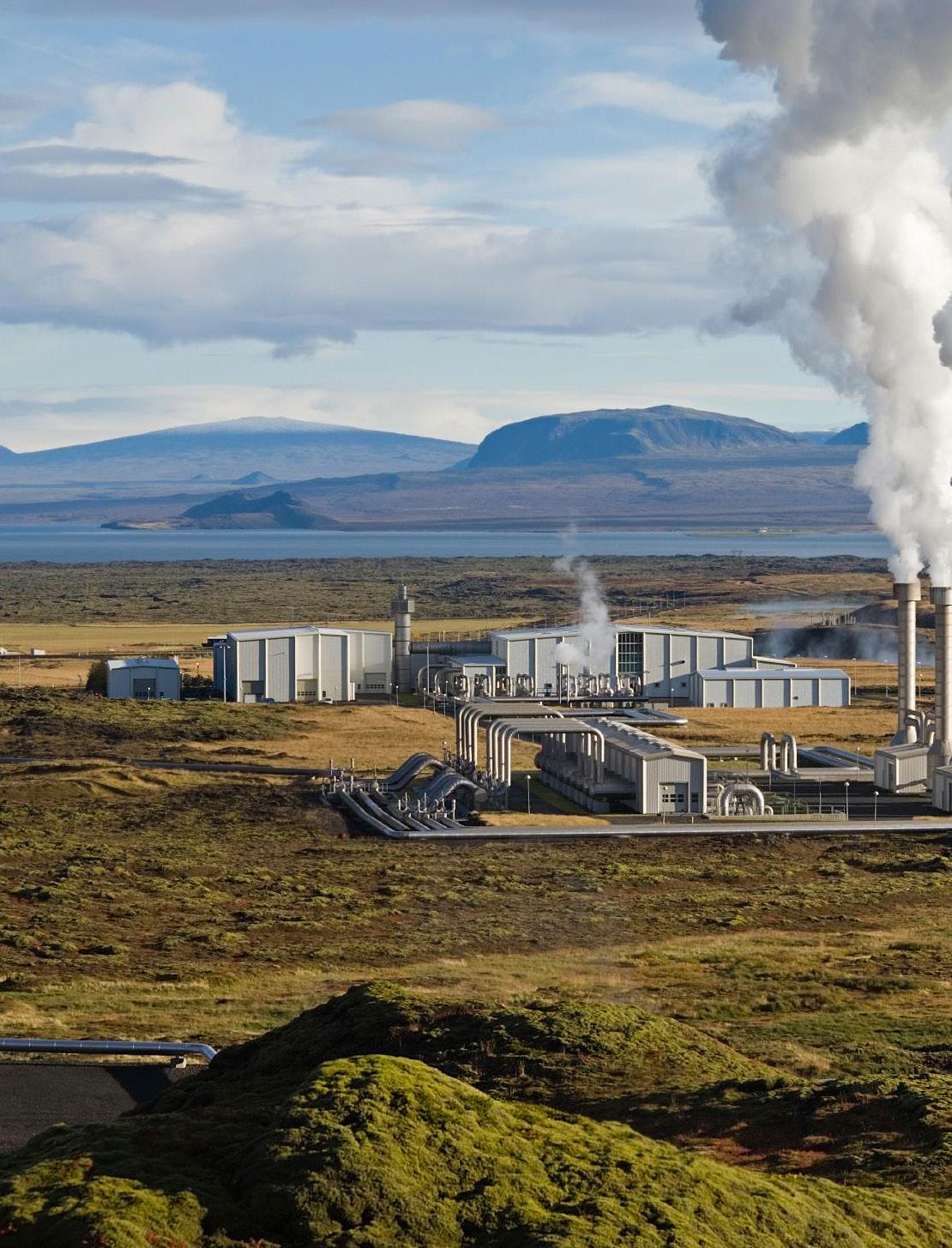
Hot Air or Liquid Gold?
By Zachary Li
“Author Zachary Li examines the failures of Texas’s power grid during the 2021 winter storm and focuses on the deregulated electricity market that incentivized the lack of emergency preparations. The author proposes leveraging geothermal energy as a viable and sustainable alternative to address environmental and economic concerns while preventing future disasters.”

When Alan Brockelman saw the first snowflakes hit the ground in February of 2021, he first saw it as a welcome surprise from the traditionally hot climate of Texas. However, North Texas spent the next 139 hours—almost six days—below freezing, cutting power to over 5 million residents1 and experiencing the state’s most expensive disaster in history.2 For Alan, the most important loss was his mother: a 56-year-old nurse, cancer survivor, and lupus warrior. After their shared home lost power, he watched helplessly as his mother’s condition deteriorated without the vital heating and medical equipment necessary to keep her alive. In just a couple of hours, the cold won.3
Alan’s story is one of an estimated 702 across the state, as critical power failures caused heating systems, medical equipment, and public infrastructure to fail.4 In addition to hundreds of deaths, the storm was blamed for nearly $200 billion in property damage and the bankruptcy filings of at least five electric cooperatives.5 Yet, millions of angry Texans focused their frustration not on Mother Nature but on the state’s largest electricity provider, Oncor. In their eyes, this tragedy was not an act of God but a result of human negligence and misaligned business incentives.6
In the 1990s, a shift in Austin towards less federal interference led to the deregulation of the wholesale power generation market in 1995 and the rest of the sector in 1999 under an organization called the Electric Reliability Council of Texas (ERCOT).7 Under the new system, energy retailers across the state could contract with providers, setting electricity prices based on market demand. It was argued that deregulation would allow for lower electricity prices and greater utility flexibility; however, analysis over the decade following deregulation found that residential electricity rates rose sixty-four percent between 1999 and 2007.8
More importantly, this system incentivized power producers to
neglect emergency and backup power generation sources as they had become substantially less profitable. Since the price of electricity swung to match supply and demand, companies had no financial incentive to build additional power capacity since the infrastructure would essentially go unused and be unprofitable.9 Consequently, utility companies such as Oncor made the most money when they produced enough electricity to feed the grid. Any more, and they risked spending unnecessary funds on capital expenditures.
Major warning signs came in February 2011 when a surprise winter storm hit Texas. Extremely low temperatures affecting critical infrastructure such as pipelines, natural gas wells, and energy production facilities caused them to fail. Despite recommendations from the Federal
resilience are either insufficient or unreasonable. The most obvious solution is to force Oncor to build emergency power generation plants for use in crisis situations. While this would certainly solve the issue, neither ERCOT nor Oncor would support it. Given its founding purpose, ERCOT has historically been reluctant to implement regulations, and it would be an exercise in futility to ask Oncor to spend hundreds of millions on a power plant that would only be used once a decade.
Another popular solution is to call for the winterization of natural gas plants. However, the approach has several drawbacks. First, it keeps natural gas plants online, emitting harmful greenhouse gases (albeit substantially less than other nonrenewable sources)12 and delaying the global climate transition.
public fear of radiation from nuclear energy make this proposal unattractive as well.16 Environmentalists have also proposed using batteries to store electricity when it is plentiful, but high costs and potential malfunctions in adverse weather make them questionable as long-term, sustainable solutions.17 In essence, the most popular solutions are imperfect.
Geothermal as a Potential Answer
While previously proposed solutions have failed to combat the issue effectively, one renewable energy source stands out. While often forgotten in favor of its more popular peers, solar and wind, geothermal power continues to be a growing segment of renewable energy globally. By relying on the Earth’s internal temperature, geothermal power can

“GEOTHERMAL ENERGY WORKS BY TAKING ADVANTAGE OF THE CORE, WHICH LIES ALMOST 2,000 MILES BELOW THE EARTH’S SURFACE AT TEMPERATURES OF NEARLY 9,000OF.”
Energy Regulatory Commission (FERC) and North American Electric Reliability Corporation (NERC) to winterize electricity infrastructure, the concerns were dismissed by state lawmakers, who maintained that the system was resilient enough to handle future cold weather events. So when record-low temperatures came just one decade later, the state’s electric grid was completely vulnerable.10
The continued lack of action to improve the grid means that Oncor needs to substantially change its power generation operations to provide stable electricity to Texas.11 While many solutions have been proposed, only one has the potential to satisfy the interests of shareholders and stakeholders alike.
Existing calls to improve Oncor’s
Furthermore, winterization fails to address power shortages caused by factors other than cold weather. For example, the summer months pose a unique challenge to the power supply as Texans rely on cooling systems to protect themselves from extreme heat.13 As a result, winterization is an incomplete solution.
A proposal in the legislative process is to replace natural gas plants, mainly at fault for the grid failure,14 with renewable alternatives such as wind and solar energy. However, these renewable sources also face reliability issues during abnormal weather events. Wind turbines can freeze in place, rendering them inoperable, while solar infrastructure can feel the effects of adverse weather and be subject to substantial wear and tear.15 The billiondollar price tag of new reactors and
provide affordable, clean, and reliable electricity, making it attractive for power companies.
Geothermal energy works by taking advantage of the core, which lies almost 2,000 miles below the Earth’s surface at temperatures of nearly 9,000 oF. While two thousand miles is too far for even the most skilled engineers, this heat eventually flows through the Earth and rises to the surface via geysers, steam vents, and other hot water features.18 This steam can be harnessed to spin underground turbines, generating an electric current and, eventually, electricity. The process is clean and efficient, producing energy directly from the Earth’s natural processes. Even though geothermal power makes up a minuscule percentage of global electricity and heat production today,
according to S&P Global Commodity Insights, geothermal power has the potential to provide 77 percent of electricity demand and 146 percent of heat demand by 2050.19
This potential is particularly evident in Texas, where the geography is uniquely suited to geothermal power. The warm temperatures above ground continue below the surface, and much of the state is at or near viable temperatures for geothermal power generation just four miles below the surface.20 Despite the vast size of Texas, this heat isn’t just in remote areas. Much of it lies near population centers, as little as three miles beneath the major cities of Houston and Austin.21 This proximity to population centers reduces the infrastructure that needs to be built and maintained to ensure a steady flow of electricity, reducing its upfront cost.
Further, geothermal’s most important ally might also be its unlikeliest. Even though geothermal energy is often marketed as a replacement for traditional oil and gas plants, Texas’s environment gives them a rare chance to work together. When oil and gas giants tapped into the vast resources of the Permian Basin, they left behind hundreds of thousands of wells miles below the surface. While many wells came up dry, they might find new life almost a decade later. By installing a wellhead and pumping in tens of thousands of barrels of water, the heat of the Earth can produce pressurized water, spinning turbines and generating electricity.22 As a result, champions of geothermal energy might find opportunities in abandoned oil and gas wells, saving millions in exploration and drilling costs that often make geothermal prohibitive.
Geothermal isn’t a faraway fantasy; it’s making massive inroads in Texas. In June 2023, Houston-based Fervo Energy made a significant breakthrough in geothermal technology, completing a 30-day test of their well and generating 3.5 megawatts of electricity.23 Another company, Bedrock Geosystems, completed a new geothermal project
in Austin in April of 2024, powering an office campus and its heating and cooling systems.24 Even the Air Force is taking notice, hoping to take advantage of the reliability and sustainability of the electricity. A project intended to test the viability of geothermal power for military applications came online at Joint Base San Antonio in November of 2023, potentially paving the way for large-scale public and private use of geothermal power.25
carbon emissions, lowering prices, and ensuring grid reliability. This solution combines benefits for stakeholders across the state of Texas while also creating a substantial business opportunity for Oncor, making it not only effective but also plausible.
Before 2021, the Electric Reliability Council of Texas had developed a metric known as the loss of load

From a cost perspective, geothermal power performs on par with or better than other electricity sources. Per megawatt-hour, geothermal power costs about $61-$102 on an unsubsidized basis. In comparison, renewable sources such as solar and wind can run anywhere from $46-$102/hr. and $42-114/hr. respectively, and their costs remain dependent on solar intensity and wind speed. Other sources, such as nuclear and coal, cost $141-$221 and $68-$166 per megawatt-hour, respectively, making them more expensive than geothermal.26 Thus, energy companies have a financial incentive to switch to geothermal power to increase their margins, creating a unique business opportunity for companies in the energy industry. As a result, the solution for Oncor is simple. By repurposing rapidly depleting oil and natural gas wells as geothermal plants, Oncor can save tens of millions on upfront exploration costs and reduce production costs in the long run. Furthermore, the company can create societal value by reducing
expectation (LOLE) to measure the reliability of its system. LOLE estimates the number of days per year that a shortage in electricity would occur. For example, a LOLE of 0.1 days/year would indicate that a system is estimated to have a shortage for 0.1 days each year (or 1 day every decade).27
After the storm, further metrics were developed to help improve grid reliability and officials’ understanding of the grid. The first is expected unserved energy (EUE), which is the expected amount of energy not supplied due to a lack of capacity. Defined in terms of energy, the value indicates how much electricity demand is not being met.28 The second is the value of lost load (VoLL), which quantifies the societal benefits of reduced outages. By calculating the amount customers would be willing to pay to avoid disruptions, it attempts to find the monetary value of potential power outages.29
These metrics help to add nuance and definition to the reliability issues
facing ERCOT. When Oncor and other energy providers add geothermal power sources to their grid, minimizing these metrics would be an important way to see if the overall grid reliability improves. Our goal with any potential change to ERCOT should be to minimize all of the metrics—LOLE, EUE, and VoLL—and ensure that Texans have reliable access to power.
One of the biggest roadblocks to geothermal energy production is the high initial cost of bringing a project online. While the production costs of geothermal energy remain attractive in Texas and are expected to fall as the technology matures, the capital risk of projects remains a drawback. Lower maintenance and generation costs offset some of this risk; however, companies are rightfully anxious about their ability to make a return on their investment.30 Furthermore, since the technology is relatively young, geothermal power generation might run into reliability or production issues that require further innovation.
Another drawback is the potential environmental pollution caused by geothermal energy production. While producing geothermal electricity doesn’t cause greenhouse gas emissions, its impact on local water
quality and biological environments has not been fully studied. Research is clear that geothermal plants will have some effect on the environment through surface disturbances, fluid withdrawal, and chemical discharge.31 Still, the extent to which these effects will be realized remains to be seen. Further innovations in geothermal energy will undoubtedly go a long way in mitigating the ecological impact of geothermal power, but these developments will require years of research and development.
One last potential drawback of Oncor’s geothermal projects is that they are dependent on implementation. While small-scale projects have been shown to succeed, there may be challenges in scaling them up to the level necessary to power millions of homes. These challenges may result in unanticipated complications during crises, as geothermal plants face pressures to which they are not accustomed. This could lead to limited grid failures as production facilities attempt to keep up with accelerating demand, potentially doing more harm than good.
While these drawbacks remain obstacles to further geothermal development, the federal government has the potential to alleviate these concerns. In February 2024, the
Biden administration announced $60 million of investment into three separate geothermal projects focused on demonstrating the efficacy and scalability of geothermal power.32 Should these subsidies continue under Trump, energy innovation might prevail. Subsidies and grants can help alleviate the capital costs of new geothermal plants and push geothermal power into commercial viability. As such, moves like these from government agencies will help spur innovation that will make geothermal power cheaper, less destructive, and more scalable than ever before.
The 2021 winter storm put the vulnerability of the Texas power grid on full display. However, by replacing depleted fossil fuel wells and repurposing them as geothermal power facilities, Oncor has a unique opportunity to strengthen the reliability of its electric grid and lower its production costs in the long run. While the effects of 2021 are already written in history, this move may ensure that no one else will ever lose their loved ones to a faulty grid again. Beyond Texas, Oncor’s efforts could serve as a model for how geothermal technology can play a critical role in meeting the world’s electric and heating needs.
1. As you read this piece promoting geothermal energy, what other questions do you have?
2. What do you consider to be the strongest incentives for businesses and/or governments to dedicate financial resources toward geothermal energy production?
1 Sullivan, Brian, and Naureen Malik. “5 Million Americans Have Lost Power after a Devastating Winter Storm.” Time, 15 Feb. 2021, time. com/5939633/texas-power-outage-blackouts. Accessed 28 Apr. 2024.
2 Gold, Russell. “The Texas Electric Grid Failure Was a Warm-Up.” Texas Monthly, 18 Jan. 2022, www.texasmonthly.com/news-politics/texaselectric-grid-failure-warm-up. Accessed 28 Apr. 2024.
3 Trahan, Jason, and Jobin Panicker. “The Ones We Lost: At Least 22 People in Dallas County Alone Lost Their Lives to the February 2021 Winter Storm.” WFAA, 16 Feb. 2022, www.wfaa.com/article/features/originals/ the-ones-we-lost-at-least-22-people-in-dallas-county-alone-lost-theirlives-to-the-february-2021-winter-storm/287-a8654006-deb6-434b8751-b60cb9eaf55e. Accessed 28 Apr. 2024.
4 Aldhous, Peter, et al. “The Texas Winter Storm and Power Outages Killed Hundreds More People than the State Says.” BuzzFeed News, 26 May 2021, www.buzzfeednews.com/article/peteraldhous/texas-winter-storm-
power-outage-death-toll. Accessed 28 Apr. 2024.
5 King, Carey, et al. “The Timeline and Events of the February 2021 Texas Electric Grid Blackouts.” The University of Texas at Austin, July 2021.
6 Jankowski, Philip. “Texas Appeals Court Allows Winter Storm Lawsuits against Oncor, Others to Move Forward.” The Dallas Morning News, 3 Apr. 2024, www.dallasnews.com/news/courts/2024/04/03/appeals-courtallows-winter-storm-lawsuits-against-oncor-others-to-move-forward. Accessed 19 Apr. 2024.
7 Baddour, Dylan. “Texas’ Deregulated Electricity Market, Explained.” Houston Chronicle, 8 June 2016, www.houstonchronicle.com/local/ explainer/article/texas-electric-deregulation-ERCOT-TCAP-7971360. php. Accessed 28 Apr. 2024.
8 Root, Jay. “Since Deregulation, Texas Utility Rates Have Soared.” NBC 5 Dallas-Fort Worth, 9 Feb. 2009, www.nbcdfw.com/news/local/sincederegulation-texas-utility-rates-have-soared/2117017. Accessed 28 Apr.
2024.
9 Malik, Naureen, and Mark Chediak. “Analysis | Why the Texas Power Grid Is Facing Another Crisis.” Washington Post, 25 July 2023, www. washingtonpost.com/business/energy/2023/07/25/why-the-texas-powergrid-is-facing-another-crisis-quicktake/7fb03a08-2aff-11ee-a948a5b8a9b62d84_story.html.
10 Douglas, Erin, et al. “Texas Leaders Failed to Heed Warnings That Left the State’s Power Grid Vulnerable to Winter Extremes, Experts Say.” The Texas Tribune, 18 Feb. 2021, www.texastribune.org/2021/02/17/ texas-power-grid-failures. Accessed 28 Apr. 2024.
11 Abnet, Zack. “Texas Requires a Reliable Power Grid. The Reforms under Consideration Won’t Give Us That.” Dallas News, 23 Jan. 2023, www. dallasnews.com/opinion/commentary/2023/01/23/texas-requires-areliable-power-grid-the-reforms-under-consideration-wont-give-us-that. Accessed 4 May 2024.
12 U.S. Energy Information Administration. “Natural Gas and the Environment - U.S. Energy Information Administration (EIA).” www. eia.gov, 7 Nov. 2022, www.eia.gov/energyexplained/natural-gas/naturalgas-and-the-environment.php.
13 Correa, Santiago. “How the ERCOT Grid Has Changed over Time, and the Obstacles Ahead.” Wood Mackenzie, 27 July 2023, www.woodmac. com/news/opinion/ercot-grid-changes-and-obstacles. Accessed 18 Apr. 2024.
14 Penney, Veronica. “How Texas’ Power Generation Failed during the Storm, in Charts.” The New York Times, 19 Feb. 2021, www.nytimes. com/interactive/2021/02/19/climate/texas-storm-power-generationcharts.html. Accessed 28 Apr. 2024.
15 Foxhall, Emily. “Texas Grid Faces Winter after Failed Attempt to Get More Power Online.” The Texas Tribune, 1 Dec. 2023, www. texastribune.org/2023/12/01/texas-power-grid-ERCOT-winter-2023. Accessed 18 Apr. 2024.
16 Igini, Martina. “The Advantages and Disadvantages of Nuclear Energy.” Earth.org, Earth.org, 28 Jan. 2023, earth.org/the-advantages-anddisadvantages-of-nuclear-energy. Accessed 30 Apr. 2024.
17 Peters, Keaton, and Emily Foxhall. “As Brutal Heat Tests Texas’ Power Grid, Batteries Play a Small but Growing Role in Keeping the Lights On.” The Texas Tribune, 12 Sep. 2023, www.texastribune. org/2023/09/12/texas-power-grid-batteries. Accessed 28 Apr. 2024.
18 Turgeon, Andrew, and Elizabeth Morse. “Geothermal Energy | National Geographic Society.” Education.nationalgeographic.org, National Geographic Society, 20 May 2022, education.nationalgeographic.org/ resource/geothermal-energy.
19 Mulder, Brandon. “Texas Researchers Push for Geothermal’s Rise from Obscurity.” Spglobal.com, S&P Global Commodity Insights, 24 Jan. 2023, www.spglobal.com/commodityinsights/en/market-insights/latest-
21 Elbein, Saul. “Geothermal Energy Could Be Off-Ramp for Texas Oil.” The Hill, 24 Jan. 2023, thehill.com/policy/equilibriumsustainability/3828568-geothermal-energy-could-be-off-ramp-for-texasoil. Accessed 19 Apr. 2024.
22 Foxhall, Emily. “In Texas, Ex-Oil and Gas Workers Champion Geothermal Energy as a Replacement for Fossil-Fueled Power Plants.” The Texas Tribune, 26 Mar. 2024, www.texastribune.org/2024/03/26/ texas-geothermal-energy-oil-and-gas. Accessed 19 Apr. 2024.
23 Becerra, Ernesto. “Houston Energy Startup Achieves Geothermal Breakthrough.” www.houston.org, 18 July 2023, www.houston.org/ news/houston-energy-startup-achieves-geothermal-breakthrough. Accessed 19 Apr. 2024.
24 Coggins, Jessica. “A Geothermal Project Kicks off New Wave of Energy Sources in Texas.” Texas Signal Media Foundation, 17 Apr. 2024, texassignal.com/a-geothermal-project-kicks-off-new-wave-of-energysources-in-texas. Accessed 19 Apr. 2024.
25 Roza, David. “Why the Air Force Wants a Geothermal Plant in Texas.” Air & Space Forces Magazine, 28 Nov. 2023, www.airandspaceforces.com/ air-force-geothermal-san-antonio. Accessed 19 Apr. 2024.
26 Lazard. “2023 Levelized Cost of Energy+.” www.lazard.com, 12 Apr. 2023, www.lazard.com/research-insights/2023-levelized-cost-ofenergyplus.
27 Lauby, Mark, and Rhaiza Villafranca. Methods to Model and Calculate Capacity Contributions of Variable Generation for Resource Adequacy Planning. North American Electric Reliability Corporation, Mar. 2011.
28 Fockens, S., et al. “A Concise Method for Calculating Expected Unserved Energy in Generating System Reliability Analysis.” IEEE Transactions on Power Systems, vol. 6, no. 3, 1991, pp. 1085–1091, https://doi. org/10.1109/59.119250. Accessed 8 Sep. 2022.
29 Gorman, Will. “The Quest to Quantify the Value of Lost Load: A Critical Review of the Economics of Power Outages.” The Electricity Journal, vol. 35, no. 8, Oct. 2022, p. 107187, https://doi.org/10.1016/j. tej.2022.107187.
30 Energy Monitor Staff. “High Upfront Costs Stunt Growth of Geothermal in the US.” Energy Monitor, 9 Aug. 2021, www.energymonitor.ai/news/ high-upfront-costs-stunt-growth-of-geothermal-in-the-us. Accessed 28 Apr. 2024.
31 Kristmannsdóttir, Hrefna, and Halldór Ármannsson. “Environmental Aspects of Geothermal Energy Utilization.” Geothermics, vol. 32, no. 4-6, Aug. 2003, pp. 451–461, https://doi.org/10.1016/s03756505(03)00052-x. Accessed 28 Apr. 2024.
32 Campbell, Julie. “Biden-Harris Administration Sends Geothermal Energy Projects $60 Million - H2 News.” Www.hydrogenfuelnews.com, 22 Feb. 2024, www.hydrogenfuelnews.com/geothermal-energy-us-bidenfunds/8563194. Accessed 4 May 2024.

Photo Credits
Gretar Ívarsson/Wikimedia Commons–Page 36 C.Stadler/Bwag/Wikimedia Commons– Page 38 Dianne Bayes/Flickr–Page 39
“Beyond showing the potential of geothermal energy in Texas, the main implication of my paper is the way that groups that might appear diametrically opposed can work together. Whether it be oil drillers and geothermal supporters, corporations and governments, or simply businesses and societies, I want to show that we can often find consensus in the most unlikely places.”

CALM AND CARRY ON SWIMMING:
by Joowon Alix yoon
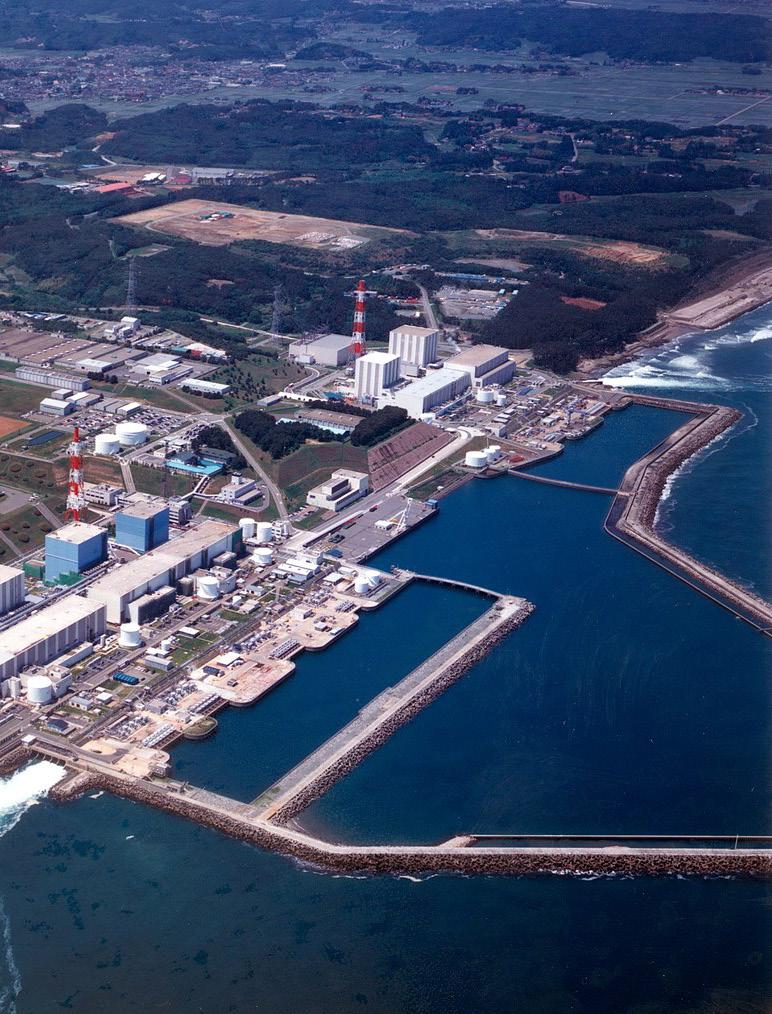
The author proposes building a Fukushima Pacific Ocean Expo aquarium using treated and purified water from the Fukushima Nuclear Plant. The proposal aims to rebuild public faith in Japan’s water and fishing industry while boosting tourism in an area severely impacted by the 2011 disaster.
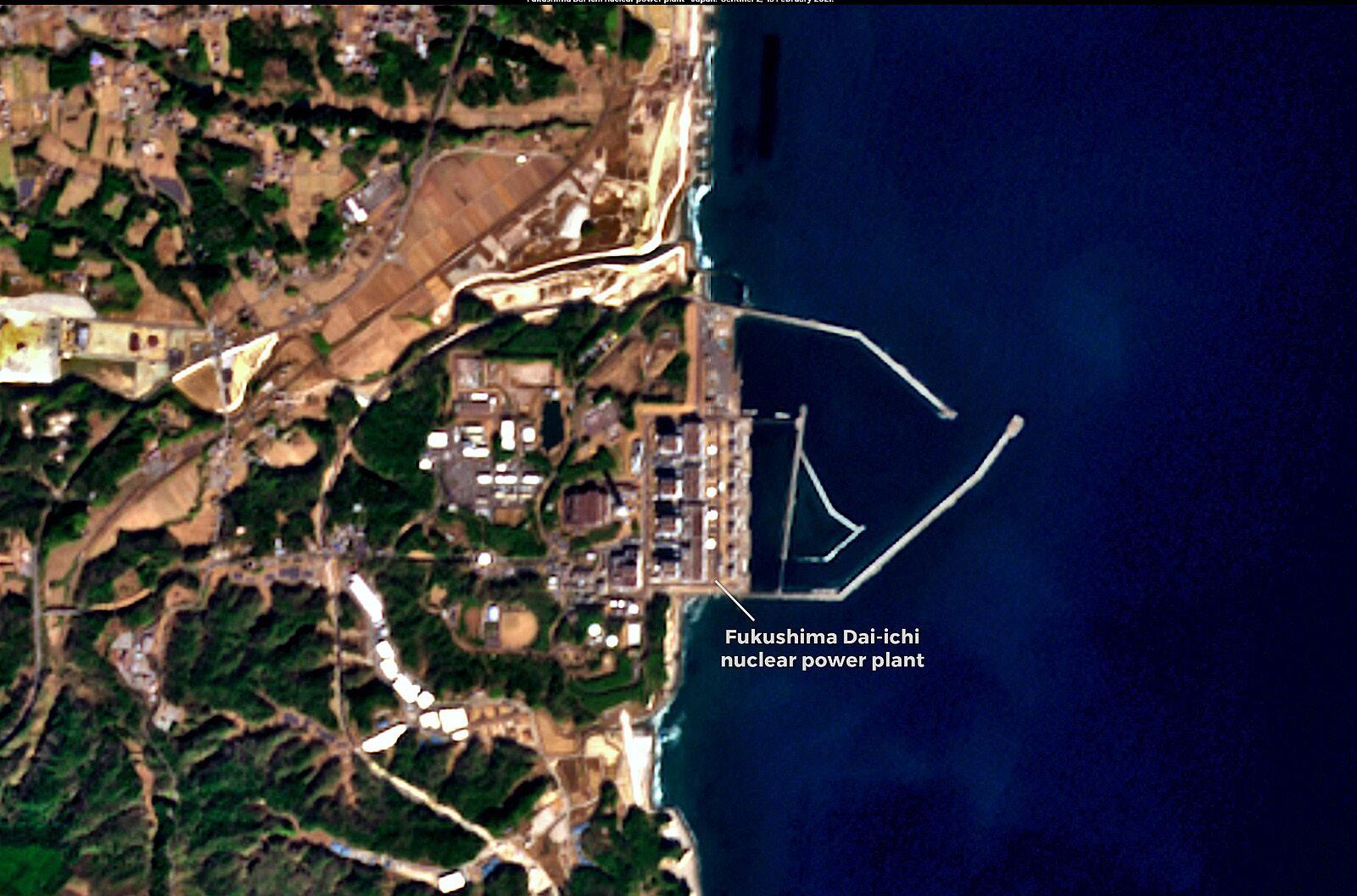
In 2011, one of the most destructive earthquakes and subsequent tsunamis in modern history hit Japan, taking thousands of lives and causing hundreds of millions of dollars in damages. The impacts of the disaster are still evident today, with one of the most significant being the destruction of Japan’s Fukushima Daiichi nuclear power plant. The plant is one of Tokyo Electric Power Company’s (TEPCO) largest facilities, which left the corporation facing acute practical, financial, and reputational challenges.1 The tsunami led to the accumulation of radioactive water in its storage tanks.2 In response, the company plans to treat the contaminated water before releasing it into the Pacific Ocean, which is in alignment with UN Goal 6, Clean Water and Sanitation.3
However, this decision has drawn criticism from both local fishing communities and consumers of Japanese seafood in neighboring countries.4 Both TEPCO and the Japanese government–which has supported the company–now face backlash over the plan. To regain the trust of stakeholders, TEPCO should partner with the Okinawa Churashima Foundation to build an aquarium showcasing aquatic creatures thriving in the treated water. This exciting tourist attraction would prove the safety
of TEPCO’s treated water and create a new revenue stream for the struggling company.
The 2011 tsunami in Fukushima destroyed the power plant’s ability to produce energy and pump water in and out of the facility.5 As a result, water that initially cooled the plant’s reactive cores became contaminated with radioactive material.6 Contaminated water currently fills 98 percent of the more than 1,000 water storage tanks owned by TEPCO, and estimates suggest that by the second half of 2024, all of the tanks will reach capacity.7
TEPCO plans to release the radioactive wastewater into the Pacific Ocean after subjecting it to a filtration process.8 The company has already announced a goal to discharge 31,200 cubic meters of water by the end of the 2024 fiscal year.9 The first batch of water was released into the Pacific Ocean on August 24, 2023.10
The Japanese government has backed this controversial plan, claiming that the treatment process will make the water “safer than international standards.”11 This state support may be influenced by TEPCO’s national strategic importance, as the company supplies a third of Japan’s electrical needs.12 However, this action has caused many stakeholders–including
Japanese fishermen and seafood consumers–to doubt the safety of treated wastewater in the ocean.13
CAll to ACtion: the purifiCAtion proCess
TEPCO has tried to assure the public of the safety of their treated water. They use a method known as the Advanced Liquid Processing System (ALPS) to remove harmful radionuclides from the water.14 To prove validity, the company asked the International Atomic Energy Agency (IAEA) to verify the efficacy of its filtration process.15
However, a significant concern remains. The purifying process is unable to remove a type of ion called tritium because of its low concentration.16 Although exposure to small amounts of tritium is not considered to be dangerous to humans, large quantities can result in DNA damage to cells and possible tumor formation.17
Professor Daniel Spyer, who teaches mechanical and aerospace engineering at New York University, argues that such human health concerns should not be exaggerated since “the amount of radioactive substance released [by TEPCO] is not that large compared to the scale and size of the ocean.”
Nevertheless, many disagree with this analysis, as is evident from the boycotts placed on imports of Japanese seafood in South Korea.18
the BACklAsh: the reputAtion of JApAn’s fishing industry At stAke
South Korea is not the only country opposing TEPCO’s discharge plan. China, one of Japan’s largest customers for exported seafood, has also reacted. Immediately after the first contaminated water release in 2023, the Chinese government placed an embargo on seafood imports from Japan.19 Soon after, Russia similarly suspended all imports of Japanese seafood.20
TEPCO is also facing domestic backlash from local fishermen, especially in the Fukushima district. The fishing community fears that discharging water from the nuclear
plant’s storage tanks will undo years of effort to improve the fishing industry’s reputation in the wake of the 2011 catastrophe.21 In their eagerness to combat negative publicity, Japanese government officials have even tried to prove the safety of fish sourced from the Fukushima region by consuming it on live television.22 However, this demonstration did little to alleviate concerns among the viewing audience.23
known for its beautiful nature, sake, rice wine, and hot spring baths.25 There are also seasonal events, such as hosting world-class ski resorts in the winter and sakura cherry blossoms in the spring.26 However, despite having lower radiation levels than many major world cities, tourists have been
“Such an aquarium, which would use treated water from the nuclear plant, will show the … public that marine life can thrive in these conditions.”
reluctant to visit this region in the wake of the 2011 Fukushima incident.27
trust Must Be eArned (seeing is Believing)
There is a popular saying: “Seeing is believing.” The best and most engaging way for TEPCO and the Japanese government to prove the credibility of the ALPS system is to open an aquarium called the Fukushima Pacific Ocean Expo (FPOE). Such an aquarium, which would use treated water from the nuclear plant, can show the public–on a global scale–that marine life can thrive in these conditions. Along with offering tangible evidence of the effectiveness of TEPCO’s treatment process and the safety of the release plan, the FPOE aquarium will provide a forum for scientific research and engage in educational activities for visitors.
An optimal location for the FPOE would be in the Aizu region, which is part of the Fukushima Prefecture but some distance from the Daiichi nuclear power station.24 The Aizu region is
The FPOE would build on a recent uptick in visitors to the region by offering the aquarium as a new tourist attraction.28 For reference on the popularity of aquariums, the Georgia Aquarium in Atlanta, the third largest in the world, welcomed almost three million guests in 2019.29 The FPOE thus has the potential to drive significant numbers of tourists to the Aizu region, offering a needed boost to local communities and the economy.
A helping hAnd froM the governMent
The Japanese government, which has a long history of partnering with TEPCO, would be able to provide substantial funding for this ambitious project. For example, after the 2011 Fukushima disaster, TEPCO was on the verge of bankruptcy until the nation’s Nuclear Damage Compensation and Decommissioning Facilitation Corporation took a more than ¥1 trillion public stake in the company.30
The government would assist with the building of the aquarium not only because of its investment in the company but also to support the Japanese fishing industry’s global image. Given their majority ownership stake in TEPCO and the importance of the fishing industry on a national scale, assisting in the aquarium’s development would be strategically beneficial for Japanese officials. They would help finance the FPOE and provide necessary exhibit and sales licenses.31 Subsequently, this project could restore public trust in both TEPCO and the safety of Japanese seafood exports, thereby protecting the country’s economic interests and international reputation.
eMpoWering loCAl fisherMen: A strAtegiC pArtnership
Alongside the Japanese government, the Okinawa Churashima Foundation is a second key partner for the FPOE aquarium. The Foundation


already owns the Okinawa Churaumi Aquarium, which is part of the Ocean Expo Park in Motobu, Japan.32 Collaborating with the Foundation would allow TEPCO to draw on the former’s invaluable expertise in aquarium management. The support and know-how from a respected industry leader would help allay public concerns about TEPCO’s ability to run the FPOE effectively.
Another practical issue is how the FPOE would stock its aquarium with marine life. Okinawa Churaumi Aquarium hosts over 740 species and 21,000 marine creatures, so the Foundation can help TEPCO by sharing its best practices for acquiring and caring for a diverse array of aquatic animals. However, rather than relying on the Foundation for marine life transportation, which might have complex cost and logistical implications, an alternative sharedvalue solution presents itself involving
local fishermen from Fukushima.
The FPOE should establish formal supply contracts with fishing cooperatives or individual fishermen to provide species of fish native to the Fukushima region. These species — potentially including tuna, squid, clams, and local reef fish — would be representative of the local marine ecosystem and of interest to aquarium visitors.33 What’s more, the payment arrangement is designed to support the livelihoods of fishing communities affected by the Fukushima disaster and, again, demonstrate TEPCO’s commitment to regional economic recovery.
The Japanese government should support TEPCO and FPOE to prevent possible revenue losses and safeguard the reputation of their fishing
industry. In 2023, Japan’s fishery and aquaculture exports were valued at around ¥390 billion, which is about a quarter of the country’s total primary sector exports.34 Thus, working directly with TEPCO will give the government the opportunity to make amends to displeased consumers and potentially win back boycotting clients.
Additionally, the Okinawa General Bureau reports that since 2014, the Okinawa Churaumi Aquarium has brought about ¥65 billion to northern Okinawa and now attracts more than 3 million people a year.35 Assuming the FPOE has similar success, the Japanese government can capitalize on the number of tourists who visit the location without the need for profit sharing with TEPCO and the Okinawa Foundation.
tepCo
TEPCO needs to partner with a native and reputable brand, such as

the Okinawa Churashima Foundation, to save the image of both TEPCO and Japan’s fishing industry. According to the Association of Zoos and Aquariums, 69 percent of visitors to zoos and aquariums are families with children.36 By operating an aquarium, TEPCO can use the joy that children derive from seeing sea life to directly show families that their thoroughly treated water will not harm marine animals.
This plan will also allow the company to profit immensely from the sales they will receive. Okinawa Churaumi Aquarium reportedly welcomes over 3 million visitors annually (mostly tourists, and the general admission fee for an adult is ¥2,180).37 This means that the aquarium earns an annual revenue of approximately ¥6.5 million.
With the help of the previously established Churashima Foundation, TEPCO can adopt similar business
practices and prices in hopes of achieving the same success. Presuming that the FPOE also prospers, TEPCO will have earned enough profit to compensate for the loss and damage caused by the Fukushima Daiichi incident. Taking into account the level of involvement from each party, the revenue should be split 60:40 between TEPCO and the Foundation, respectively.
the okinAWA ChurAshiMA foundAtion
The Okinawa Churashima Foundation can gain more opportunities for research from this collaboration. This is because they would be one of the first organizations to be able to closely observe the marine life exposed to the treated water. This would not only further the organization’s reputation within the marine biology field but would also help them become specialized experts when it comes to
dealing with organisms exposed to the treated water.
Additionally, opening an aquarium filled with treated radioactive water would give the Foundation more marketability and drive profit growth. The Okinawa Churaumi Aquarium already attracts millions of tourists because it owns the largest acrylic panel aquarium ceiling in the world.38 Thus, the FPOE has the potential to become another gigantic tourist attraction, and the Foundation would see financial growth after sharing the profit with TEPCO, of course.
Aquatic animals in waters that were once contaminated with radioactive materials may cause some people to be concerned about the safety of the fish. While research, such as a study conducted by Stanford University, proves that the level of radiation found
in the ocean has no detrimental impact on marine life, there is a possibility that the water could be discovered to be harmful at a later date.39
If the contaminated water becomes toxic to the FPOE aquatic life, the Foundation, TEPCO, and the Japanese government could all be reputationally damaged. Failure to protect the fish can cause the Foundation, which is heavily involved in marine life entertainment and preservation, to lose credibility. Meanwhile, the Japanese government will continue to receive backlash from both consumers and producers and may even see financial losses in their fishery and aquaculture export sector. Additionally, TEPCO, which has already been struggling with its finances and reputation, may see irreparable damage for being the face of the ambitious project and bear most of the blame for harming the aquatic ecosystem.
The Okinawa Churashima Foundation can help by using its advanced research facility.40 In addition to being a popular tourist attraction, the aquarium conducts research and conservation efforts to protect marine life. The safety of the organisms would not be a concern if the foundation funded an in-house research project to monitor the condition of the fish before and throughout the aquarium’s launch.
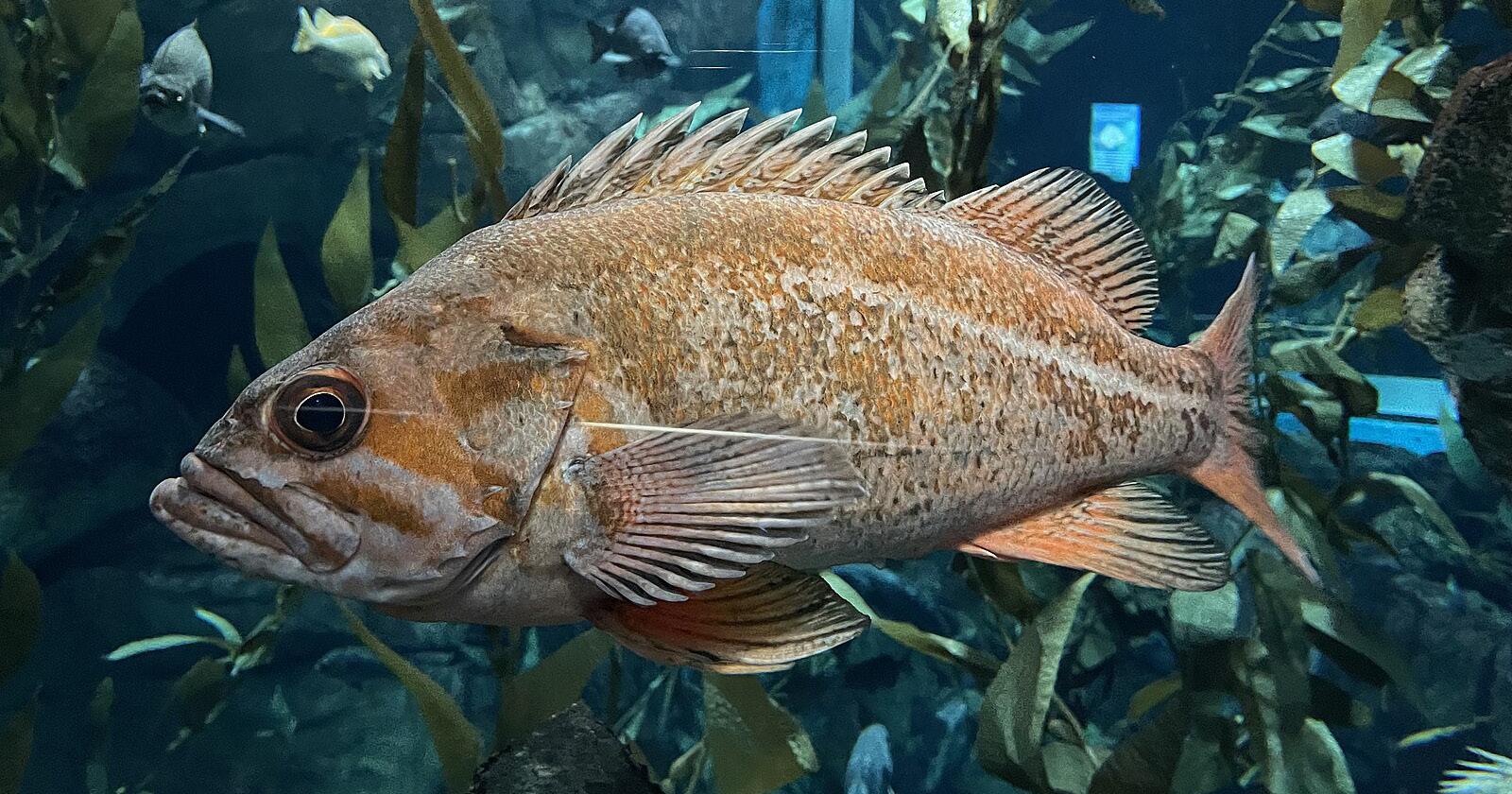
The Okinawa Churaumi Aquarium is also known for its educational preservation programs for visitors of all ages. TEPCO can incorporate this project into its aquarium and add additional components to educate visitors about the ALPS process. This way, visitors can learn more about the filtration procedure first-hand rather than receiving information through third-party news outlets. On a similar note, the FPOE can also hold an exhibition dedicated to Fukushima’s local communities, such as local fishermen, with stories and testimonies from them appealing to the pathos of visitors and earning their trust.
In conclusion, the Fukushima Pacific Ocean Expo will help recover
TEPCO and Japan’s fishing industry’s image on a domestic and international level while generating new revenue opportunities. The partnership between TEPCO, the Japanese government, and the Okinawa Churashima Foundation may be the most effective way for both entities to gain the public’s faith after the announcement of TEPCO’s water release project. If successful, Japan and Fuksuhuma’s psychological wounds from the nuclear disaster will be one step closer to healing.
1. How might TEPCO and the Fukushima Pacific Ocean Expo market and promote the aquarium to tourists?
2. Would you visit such an aquarium in Fukushima? Why or why not? (or when?)
1 Khadka, Navin Singh. “The Science behind the Fukushima Waste Water Release.” BBC News, 26 Aug. 2023, www.bbc.co.uk/news/worldasia-66610977.
2 Ibid.
3 Diaz-Maurin, François. “Why Japan Should Stop Its Fukushima Nuclear Wastewater Ocean Release.” Bulletin of the Atomic Scientists, 22 Sept. 2023, thebulletin.org/2023/09/why-japan-should-stop-its-fukushimanuclear-wastewater-ocean-release/#:~:text=On%20August%20 24%2C%202023%2C%20Japanese.
4 “Seoul Backs Fukushima Water Plan; China Imposes Japan Food Ban.” Al Jazeera, www.aljazeera.com/news/2023/7/7/seoul-backs-fukushimawater-plan-china-imposes-japan-food-ban. Accessed 2 Mar. 2024.
5 Speyer, Daniel. “Pick Up the Phone.” Alix Yoon, March 24, 2024.
6 Ibid.
7 Johnston, Eric. “A Closer Look at the Fukushima Water Discharge Plan.” The Japan Times, 24 Aug. 2023, www.japantimes.co.jp/
news/2023/08/24/japan/explainer/explainer-fukushima-water-dischargeplan/.
8 Take, Sayumi. “Japan Begins Release of Fukushima Water: 5 Things to Know.” Nikkei Asia, asia.nikkei.com/Spotlight/Environment/Japanbegins-release-of-Fukushima-water-5-things-to-know#:~:text=For%20 the%20fiscal%20year%20through. Accessed 8 Apr. 2024.
9 Ibid.
10 Diaz-Maurin, François.
11 “Japan’s Discharge of ALPS Treated Water in Line with International Safety Standards, New IAEA Task Force Report Confirms.” Www. iaea.org, 30 Jan. 2024, www.iaea.org/newscenter/pressreleases/japansdischarge-of-alps-treated-water-in-line-with-international-safetystandards-new-iaea-task-force-report-confirms#:~:text=The%20IAEA. Accessed 2 Mar. 2024.
12 “Get to Know Tepco: Japan’s Biggest Power Company.” PBS NewsHour, 17 Mar. 2011, www.pbs.org/newshour/world/get-to-know-tepco-japans-
biggest-power-company.
13 Al Jazeera.
14 Iaea.org.
15 Ibid.
16 Ibid.
17 Chen, Weibo, et al. “Medical Treatment and Dose Estimation of a Person Exposed to Tritium.” Dose-Response, vol. 17, no. 4, 1 Oct. 2019, p. 155932581988067-155932581988067, www.ncbi.nlm.nih.gov/pmc/ articles/PMC6796214/#:~:text=Previous%20studies%20have%20 shown%20that, https://doi.org/10.1177/1559325819880670. Accessed 29 Oct. 2023.
18 Hasegawa, Kyoko, and Tomohiro Osaki. “Japan Fishermen, Locals Seek Halt to Fukushima Water Release.” Phys.org, phys.org/news/202309-japan-fishermen-locals-halt-fukushima.html#:~:text=Many%20 Japanese%20fishermen%20have%20been. Accessed 8 Apr. 2024.
19 Ibid.
20 France-Presse, Agence. “After China, Russia Suspends Japanese Seafood Imports.” VOA, 16 Oct. 2023, www.voanews.com/a/after-china-russiasuspends-japanese-seafood-imports-/7312507.html.
21 Hasegawa.
22 Ibid.
23 Ibid.
24 “Is It Safe to Visit Fukushima?” News.nationalgeographic.org, news. nationalgeographic.org/is-it-safe-to-visit-fukushima/. Accessed 5 May 2024.
25 Ibid.
26 Ibid.
27 Ibid.
28 Ibid.
29 “Georgia Aquarium ‘Sea Change’ 2019 Annual Report.” Sea Change 2019 Annual Report, Georgia Aquarium, www.georgiaaquarium.org/ wp-content/uploads/2020/05/2019-Annual-Report-Web.pdf. Accessed 25 Jan. 2025.
30 The Yomiuri Shimbun. “10 Years after Effective Nationalization, Tepco Faces Further Hurdles.” The Japan News by The Yomiuri Shimbun, The Japan News, 9 Aug. 2022, japannews.yomiuri.co.jp/business/ economy/20220809-50147/.
31 “Facility Data.” Okinawa Churaumi Aquarium, churaumi.okinawa/en/ outline/. Accessed 5 May 2024.
32 Ibid.
33 Schubel, J. R., et al. “Aquarium of the Pacific.” Increasing Public Ocean Awareness and Understanding: An Aquarium Model, Aquarium of the Pacific’s Marine Conservation Research Institute, July 2006, www. aquariumofpacific.org/downloads/AquariumModel-July%202006.pdf.
34 Klein, Catharina. “Japan: Export Value of Fishery Products 2023 | Statista.” Export Value of Commodities from the Fisheries and Aquaculture Industry from Japan from 2014 to 2023, Statista, 22 Oct. 2024, www.statista.com/statistics/750719/japan-export-value-of-fisheryproducts/.
35 Sato, Keiichi. “Administration and Future Issues of an Aquarium Which Lost Inbound Visitors by the Covid-19 Expansion.” ICOM Japan, International Council of Museums Japan, 11 June 2021, icomjapan.org/ en/updates/2021/06/11/p-2582/.
36 “Visitor Demographics.” Www.aza.org, www.aza.org/partnerships-visitordemographics#:~:text=54%25%20women%2F46%25men.
37 “Administration and Future Issues of an Aquarium Which Lost Inbound Visitors by the COVID-19 Expansion.” ICOM Japan, icomjapan.org/en/ updates/2021/06/11/p-2582/. Accessed 14 Apr. 2024.
38 “Facility Data.”
39 Mckinzie, Matthew. “Fukushima Radiation Risks from Eating Fish.” Www.nrdc.org, 24 Sept. 2013, www.nrdc.org/bio/matthew-mckinzie/ fukushima-radiation-risks-eating-fish.
40 “Facility Data.”
Photo Credits:
• IAEA ImageBank/Wikimedia Commons–Page 44
• European Union/Wikimedia Commons–Page 46
• Mostafameraji/Wikimedia Commons–Page 47
• Alex Ho/Wikimedia Commons–Page 48
• FaysaLBinDaruL/Wikimedia Commons–Page 50

“I was inspired to write about the current pollution problem in the Pacific Ocean after visiting South Korea during the summer of 2023. I remember media outlets covering this issue, which led to the Korean public feeling hostile to Japanese aquatic imports---including members of my own family. The ripple effects of Japan’s decision, reverberating through politics, economics, and society across Asia, piqued my interest and inspired me to explore this topic further.”

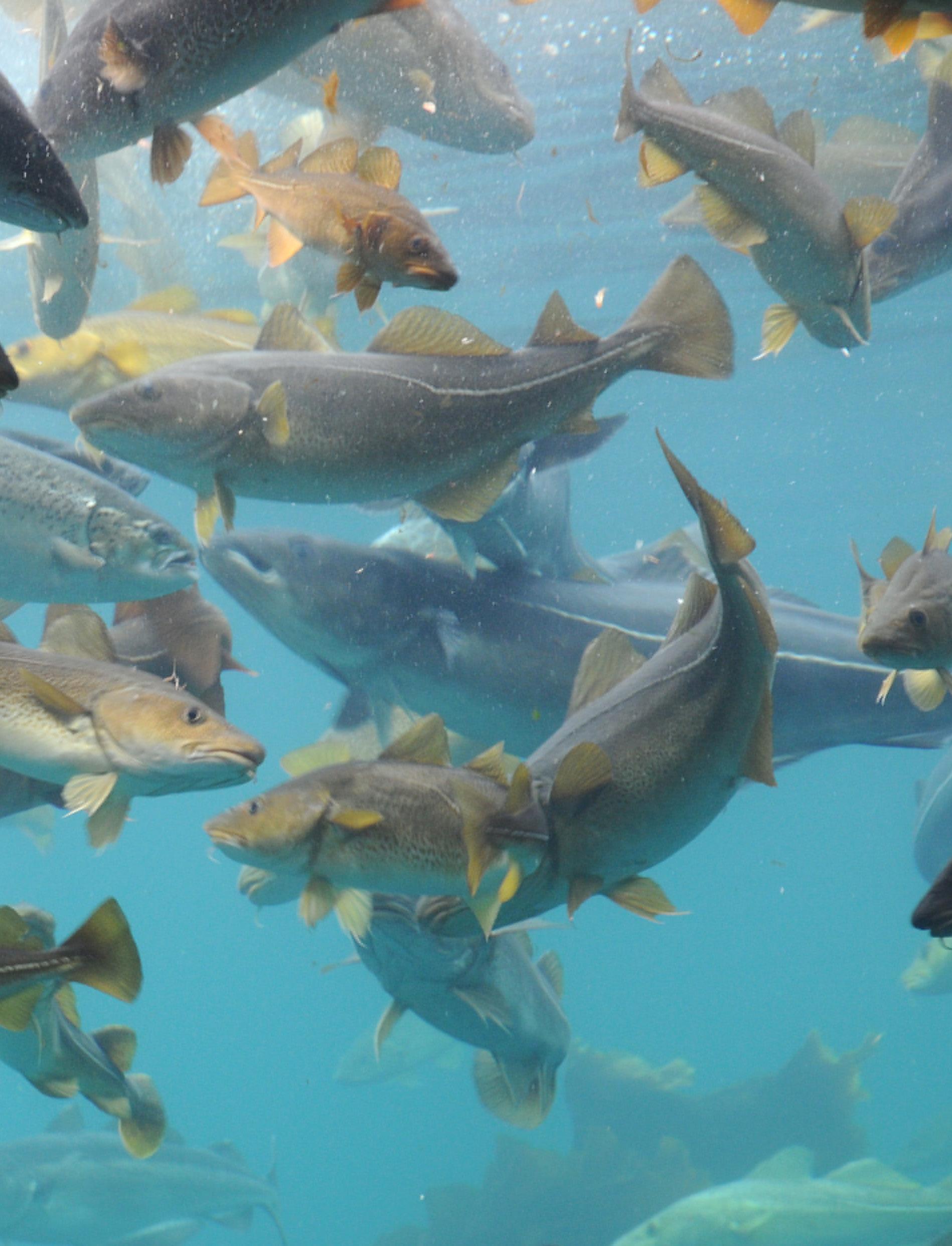
By Christine Neubert
Author Christine Neubert proposes an additional income stream for Atlantic cod fishers—specifically, providing their byproduct for acellular fish skin grafts (AFS). This new medical technique for creating human skin grafts uses fish skin and can address the shortcomings of current skin graft procedures. It may also offer a solution to the practice of overfishing.

Once an essential part of New England’s identity, Atlantic cod has been overfished for decades, making the species vulnerable to extinction. Businesses have long exploited cod stocks, using advanced fishing techniques to maximize shortterm profits. The only possibility for recovery is if cod fishing is reduced so the population is given a chance to regrow to sustainable levels. Lower catch rates allow the population to stabilize and grow, ensuring enough breeding adults to replenish numbers.
However, fishers are worried about reductions in their catch quota impacting their revenue and thus resist regulations because they are interested in maintaining their livelihoods.
According to the Conservation Law Foundation, New England fishery managers have not honored the federal Magnuson-Stevens Act, which requires catch limits to end overfishing.1 This situation demonstrates how merely setting catch limits is not an effective strategy, as fishers will prioritize their businesses. Given this business incentive, the economic interests of the fishers must be considered if effective change is to be accomplished. One way to address the issue of overfishing while still giving fishers the opportunity to make a profit is to use more parts of the cod to make sellable products. Ensuring every part of the
fish serves a purpose will optimize resource utilization and promote a more sustainable seafood industry.
The idea is that if more parts of each fish are used to create profitable products, such as turning fish skin into human skin grafts, fishers will be able to lower their catch sizes without putting their businesses at risk. Selling their waste byproducts adds new revenue streams, which enables an increase in profit and allows them to stay in business despite the suffering of the cod population. By reducing catch sizes, the cod population will have the opportunity to recover, benefitting both the fish and these businesses over the long term.
In addition, less waste will be created, the disposal of which creates environmental concerns. Disposing of fish waste not only creates strong odors due to bacterial decomposition, but it can also reduce oxygen levels when dumped in seawater and introduce diseases to the ecosystem of the seafloor.2 Therefore, in reducing the volume of waste fishers produce, such initiatives help prevent negative environmental externalities.
Cod is typically sold as filets, which only make up around 35 percent to 45 percent of the fish’s weight.3 According to research by the Iceland
Ocean Cluster, “about half of each fish’s weight goes wasted in the production process.”4 This operation leaves “undesirable” parts of the fish to be thrown away because they are not profitable. However, numerous business opportunities exist to derive additional value from each fish in the form of Omega-3 capsules, cold medicine sprays, dog snacks, and possibly more.5 One interesting opportunity lies in a partnership with the Icelandic company Kerecis. The firm “develops, manufactures, and sells patented fishskin soft tissue regeneration products.”6 Essentially, it has found a way to turn Atlantic cod fish skin into human skin grafts.
Skin grafts are commonly used in medicine to facilitate the closure of non-healing skin wounds caused by burns, injuries, disease, or infection.7 The North American market for skin grafts was estimated to be about $426 million in 2021, a figure expected to grow to about $664 million by 2028.8 Surgeons most often use healthy skin from a person’s own body (autograft). However, there sometimes isn’t enough healthy skin to use for the procedure.9 In these cases, they turn to skin alternatives such as another human (allograft) or an animal (xenograft), most commonly a pig.10
Many types of skin-replacement materials exist, although none meet all the criteria for an ideal method. Collagen alginate dressings and silver sulfadiazine cream require frequent dressing changes, posing challenges for healthcare providers and patients.11 Autografts require a new wound to be formed on the body, making additional surgical morbidity a concern.12 Antibodies and antigens related to allografts make graft rejection a potential hazard, which may cause complications for the recipient. Further, mammalian xenografts carry the risk of viral disease transmission.13 Due to these challenges, there is a need to develop and bring into practice new materials in skin grafting technology, which fish skin can fill.
Most skin substitutes must be
heavily processed to eliminate the risk of disease transfer. Animal tissues must go through viral inactivation, which also removes components beneficial to wound healing, such as lipids and glycans.14 Products from human tissue also require treatment in the form of antibiotics to reduce bioburden.15 In contrast, viral inactivation is not required for fish skin as it has very little risk of viral disease transmission to humans.16 It is only minimally processed using a method preserving its scaffold structure and lipid composition, which would otherwise be degraded. This procedure allows the skin to be particularly rich in omega-3 fatty acids, which promote tissue regeneration.17
Therefore, fish skin is well suited for skin grafting applications. In a systematic review of medical literature from the National Institutes of Health, research comparing the efficacy of acellular fish skin grafts (AFS) to alternative techniques, such as collagen alginate dressings, silver sulfadiazine cream, and allografts, showed that fish skin was superior in wound healing.18 It describes a study comparing AFS grafts to synthetic skin substitutes and autografts and concluded that AFS grafts allowed for faster healing, longer functionality, and improved aesthetic results.19 These benefits establish the use of fish skin in medical applications as valuable to patients suffering from
burns and chronic ulcers.
In addition to having superior functionality, AFS grafts are a more cost-effective alternative. As mentioned, other skin substitutes must undergo processing with powerful detergents in order to decrease the risk of viral disease transfer, which
...a
is expensive.20 In having a milder manufacturing process, AFS grafts can bypass these expenses. Because the fish skin grafts allow quicker healing and a higher proportion of wounds to close, fewer amputations are made after fish skin therapy compared with the standard of care (4.6 percent vs. 6.9 percent).21 Amputations are expensive, and decreasing their frequency allows for a substantial reduction in treatment costs.
In a 2020 study evaluating the cost-effectiveness of AFS grafts in
treating diabetic foot ulcers compared to collagen alginate dressings, AFS grafts were superior. The cost of each treatment with AFS grafts was found to be $11,210, while the cost of the alginate dressings was $15,075.22 A sensitivity analysis found fish skin therapy is 93.6 percent likely to be cost-effective (which factors in quality of life), and 71.4 percent likely to be cheaper than the standard of care.23 Therefore, chances are high that hospitals will prefer this technology due to its effectiveness and cost efficiency.
Because fish skin grafts are a novel technology, their use can only continue to spread, increasing demand. Their wound-healing properties and comparatively low manufacturing costs make acellular fish skin a desirable material to use in the medical field, and it will hopefully be implemented in more treatments. The more demand for this material, the more fish skin is needed, which is where fishers come in. Those who had previously thought of Atlantic cod skin as waste because it is not sold widely on the market (like filets) are now able to find use for it. Since it was previously discarded, fishers have an excess of skin that they can sell to companies for the manufacturing of skin graft sheets.
ProfitinG from ByProductS
One advantage of this additional

sale is the reduction of waste produced by fishers. Fishers must cover the costs associated with waste disposal, such as transportation, processing, and fees for landfill sites. By using more fishing byproducts previously thought of as waste, fishers can reduce waste disposal costs while gaining additional revenue streams. This initiative allows the seafood industry to minimize its environmental footprint while becoming more cost-effective.
In addition to lowering costs associated with production waste, fishers can earn extra revenue from selling the fish skin. If the use of fish skin grafts becomes more widespread, companies producing this product will need more skin and can purchase it from fishers who already have access. Fishers may be able to sell it at low prices due to its availability, which will benefit Kerecis and other AFS medical businesses. Any additional revenue generated from these sales will profit fishers because the skins would have previously been wasted.
This business model, as well as many others possible by creating profitable commodities from waste byproducts of the Atlantic cod fishing industry, allows fishers to increase the value of each cod landed. They can decrease the quantity of fish they catch without needing to worry about losing profits because they can focus on selling more of each cod, thus increasing the value of the fishery. Decreasing catch sizes allows dwindling cod populations to rebuild, so the initiative may tackle the problem of overfishing as well.
riSkS
Despite the numerous benefits of this initiative, there are some challenges fisheries may face, one of which is the complexity of creating a supply chain for a new product type. Fish skin destined for medical use, such as skin grafts, requires handling and storage standards that are different and more stringent than those for edible fish products. Fishing companies producing this byproduct are used
to treating it as waste, thus handling it with the intention of disposal. In order for the fish skin to be medical grade, protocols must be set in place to prevent contamination and preserve the biological properties of the skin. Setting up such facilities involves specialized equipment and training personnel for these new protocols, which are all costs associated with this initiative.
Fishers could raise money from individuals or organizations passionate about the conservation of the cod species or environmental sustainability to set up these facilities. Government programs aiming to help sustainable cod fishing might also offer incentives. Another challenge for US fishers working with Kerecis is that the firm exclusively manufactures its medical skin products using certified sustainable fish stocks, as sustainability is an important part of its message. The company’s website states, “Our suppliers’ fisheries are certified by the Marine Stewardship Council (MSC) and Iceland Responsible Fisheries Management (IRFM), ensuring sustainable practices.”24 Therefore, in order to even begin working with Kerecis, US fishers would have to ensure they are using sustainable practices and hold all the necessary certifications.
While fishers might be concerned about changes in their practices or reductions in quotas coming with sustainable management, fishing responsibly would help maintain Atlantic cod stocks, and using more of their byproducts would increase revenue. Ultimately, fishers must recognize the risk of extinction of Atlantic cod due to their actions, and the only way to mitigate this is to fish less. Despite costs, fishers may be inclined to adopt more sustainable practices. One alternative, cod dying out entirely, comes at an even greater cost.
By using the abundant byproducts of the fishing industry to create sustainable products, cod fishers can attempt to overcome the hardships imposed on their businesses due to necessary restrictions on catch sizes. Shifting from a linear, wasteful business model to a circular one, creating value from waste, not only benefits the fishers but also allows for the increased use of innovative technology in medical treatment. Most importantly, it will allow for substantial growth in the efforts to rebuild declining cod populations, allowing them to reach sustainable levels once again.
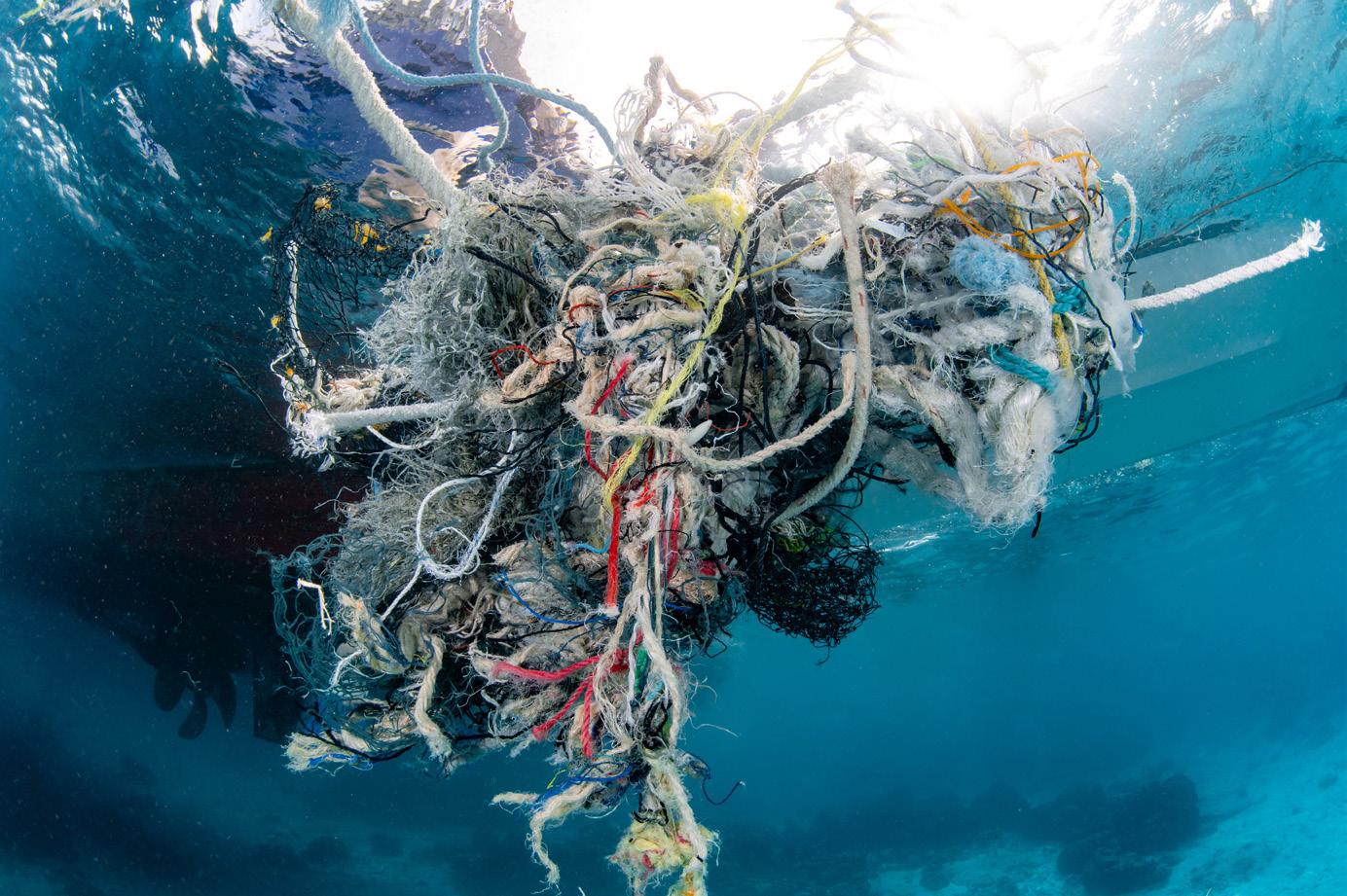
1. Do fishing restrictions still seem necessary in this new scenario? Why or why not?
2. What other food harvesting practices might benefit from the discovery (and sales) of new applications for their products?
1 Bergman, Megan Mayhew, and Brian Skerry. “Can Atlantic Cod Be Saved?” Conservation Law Foundation, https://www.clf.org/blog/ feature/can-atlantic-cod-be-saved/. Accessed 5 May 2024.
2 Environmental Protection Agency. “Ocean Disposal of Fish Wastes | US EPA.” United States Environmental Protection Agency, 5 April 2024, https://www.epa.gov/ocean-dumping/ocean-disposal-fish-wastes. Accessed 5 May 2024.
3 Iceland Ocean Cluster. “100% Fish.” Íslenski sjávarklasinn, https:// sjavarklasinn.is/en/iceland-ocean-cluster/100-fish/. Accessed 5 May 2024.
4 Ibid.
5 Nargi, Lela. “Iceland’s Quest to Use 100 Percent of Its Fish Waste.” Hakai Magazine, 19 July 2023, https://hakaimagazine.com/news/icelandsquest-to-use-100-percent-of-its-fish-waste/. Accessed 5 May 2024.
6 “Overview - KERECIS |.” Kerecis, 11 Sept. 2023, www.kerecis.com/ overview/.
7 Cleveland Clinic. “Skin Graft: What Is It, Risks, Benefits & Recovery.” Cleveland Clinic, 21 July 2021, https://my.clevelandclinic.org/health/ treatments/21647-skin-graft. Accessed 5 May 2024.
8 Business Market Insights. “North America Skin Graft Market Forecast to 2028.” Business Market Insights, https://www.businessmarketinsights. com/reports/north-america-skin-graft-market. Accessed 5 May 2024.
9 Cleveland Clinic.
10 Ibid.
11 Ibrahim, Mohamed. “Fish Skin Grafts Versus Alternative Wound Dressings in Wound Care: A Systematic Review of the Literature.” NCBI, 19 March 2023, https://www.ncbi.nlm.nih.gov/pmc/articles/ PMC10111873/. Accessed 5 May 2024.
12 Fiakos, Gabriella, et al. “Improved skin regeneration with acellular fish skin grafts.” Engineered Regeneration, vol. 1, 2020, pp. 95-101. Science Direct, https://www.sciencedirect.com/science/article/pii/ S2666138120300116. Accessed 5 May 2024.
13 Ibrahim.
14 Di Mitri, Marco, et al. “Fish Skin Graft: Narrative Review and First Application for Abdominal Wall Dehiscence in Children.” NCBI, 14 September 2023, https://www.ncbi.nlm.nih.gov/pmc/articles/ PMC10501472/. Accessed 5 May 2024.
15 “Fish-Skin Technology - Kerecis |.” Kerecis, 19 Apr. 2024, www.kerecis. com/omega3-fishskin/.
16 Ibid.
17 Di Mitri.
18 Ibrahim.
19 Ibid.
20 Ibid.
21 Winters, Christopher, et al. “Cost Effectiveness of Fish Skin Grafts Versus Standard of Care on Wound Healing of Chronic Diabetic Foot Ulcers: A Retrospective Comparative Cohort Study.” HMP Global Learning Network, October 2020, https://www.hmpgloballearningnetwork.com/ site/wounds/article/cost-effectiveness-fish-skin-grafts-versus-standardcare-wound-healing-chronic-diabetic. Accessed 5 May 2024.
22 Ibrahim.
23 Winters.
24 “ESG - KERECIS |.” Kerecis, 8 Dec. 2023, www.kerecis.com/esg/.
Photo Credits:
• davidyoung11111/AdobeStock–Page 52
• Witold Krasowski/AdobeStock–Page 54
• Kerecis–Page 55
• zephyr_p/AdobeStock–Page 56

“I arrived at my paper topic somewhat unexpectedly. I chose the “Life Below Water’” SDG at random and, after a quick Google search, discovered that Atlantic cod is an endangered species. While researching this species, I came across the website for Kerecis, which immediately piqued my interest. Fascinated by the science behind it, I knew it would make an exciting research topic.”

By Travis Xue

Travis Xue proposes using AI image recognition to enable better inventory management and reduce food waste in a wide range of industries. The author also suggests partnerships with food banks and composting organizations to take care of spoiled or leftover food.
Alot goes into making and delivering just a little bit of food to supermarkets. From fresh soil, water, and sun to trucks, gasoline, and brick-and-mortar stores, every step of the process requires substantial investment and resources. So why is it that 250,000 tons of food are wasted in New York City every year?1 After all, throwing away perfectly edible food means the resources spent on it are subsequently wasted. At the same time, firms also have to incur the cost of disposal, a lose-lose situation for every party involved.
To make matters worse, this problem perpetuates far more severe problems: food insecurity and climate change. This inefficient use of vital, potentially lifesaving food is inexcusable in a city where 12.8 percent of its residents experience food insecurity.2 Consequently, it is important for large food buyers such as restaurants, supermarkets, and schools to avoid overstocking or to use disposed scraps for a sustainable purpose. As for its impact on climate change, food waste left decaying in New York City landfills leads to an estimated 170 million metric tons of CO2 emissions,3 not including the methane and CO2 generated from the transporting garbage trucks.
Efforts such as composting and donating leftovers to food banks are designed to address this problem. Yet, while the saving of millions of tons of food through programs such as City Harvest and Harlem Grown has made a significant impact,4 the efforts lack scalability. Most composting efforts within the city have been community efforts; the same is true of food banks. These narrow approaches limit these organizations’ ability to collaborate with more businesses in saving leftovers. Additionally, while supermarkets are legally required to donate unsold products, restaurants, schools, and hospitals are not obligated to do the same, making them less likely to put their food waste to good use.5
Artificial Intelligence (AI) can limit the effects of this issue. With this type of emerging technology known for
disrupting old, already-established industries, it comes as no surprise that AI may have the potential to revolutionize food disposal practices. My solution would be to develop an image recognition program that uses camera footage to identify the most thrown-away items for a range of industries. Using this footage, the artificial intelligence can identify changes in the company’s operations. For example, if AI observes the frequent disposal of half-eaten sandwiches in a hotel dining hall, it can alert management to portion the sandwiches more appropriately.
The most obvious benefit for businesses implementing such a program would be the financial savings. After all, the process can enable companies to identify the shortcomings within their operations, such as overstocking or incorrect portioning, both of which dramatically increase the cost of paying for food and disposing of it. According to Revel Systems’ findings, every $1 a business invests in reducing food waste decreases about $14 in operational expenses.6 This benefits the business and its shareholders because now the company has more resources to focus on other projects rather than the matter of food disposal.
The AI program is fully automated, requiring no additional manpower to use, and it maintains 24/7 surveillance of food disposal. It can also quantify the food thrown away, something humans cannot do without manually sifting through mounds of waste. The only action required is implementing the AI’s suggestions, which may make it an extraordinarily convenient solution.
Another hidden benefit that businesses can unlock is improved labor efficiency within the workforce. Past implementations of similar programs in supermarkets yielded an increased labor efficiency of up to 20 percent per store because the technology could independently analyze the appropriate stock amount.7 As for the proposed AI program, it can help calculate the inventory needed for every period and adjust estimates with the more footage
it collects. This will allow businesses to focus on other endeavors rather than spending time deciding how much product they need to order to keep up with consumers’ demands.
Unfortunately, this part of the AI program would only have a onedimensional impact on the issue of food waste: limiting the amount of food waste produced. It would not eliminate food leftovers, nor would it explain what to do with this extra. As a solution, I propose the AI usage of Google Maps to suggest places where expired food or unsold provisions can be reused. Examples include community gardens, food banks, or food rescue organizations that are qualified to handle it. These organizations might range from local, community-sponsored businesses to those with an established international presence, giving supplying businesses the option to partner with whomever they please.
According to NY Food Policy, the benefits from these mutual connections would be substantial. Estimates show that New York City food banks could

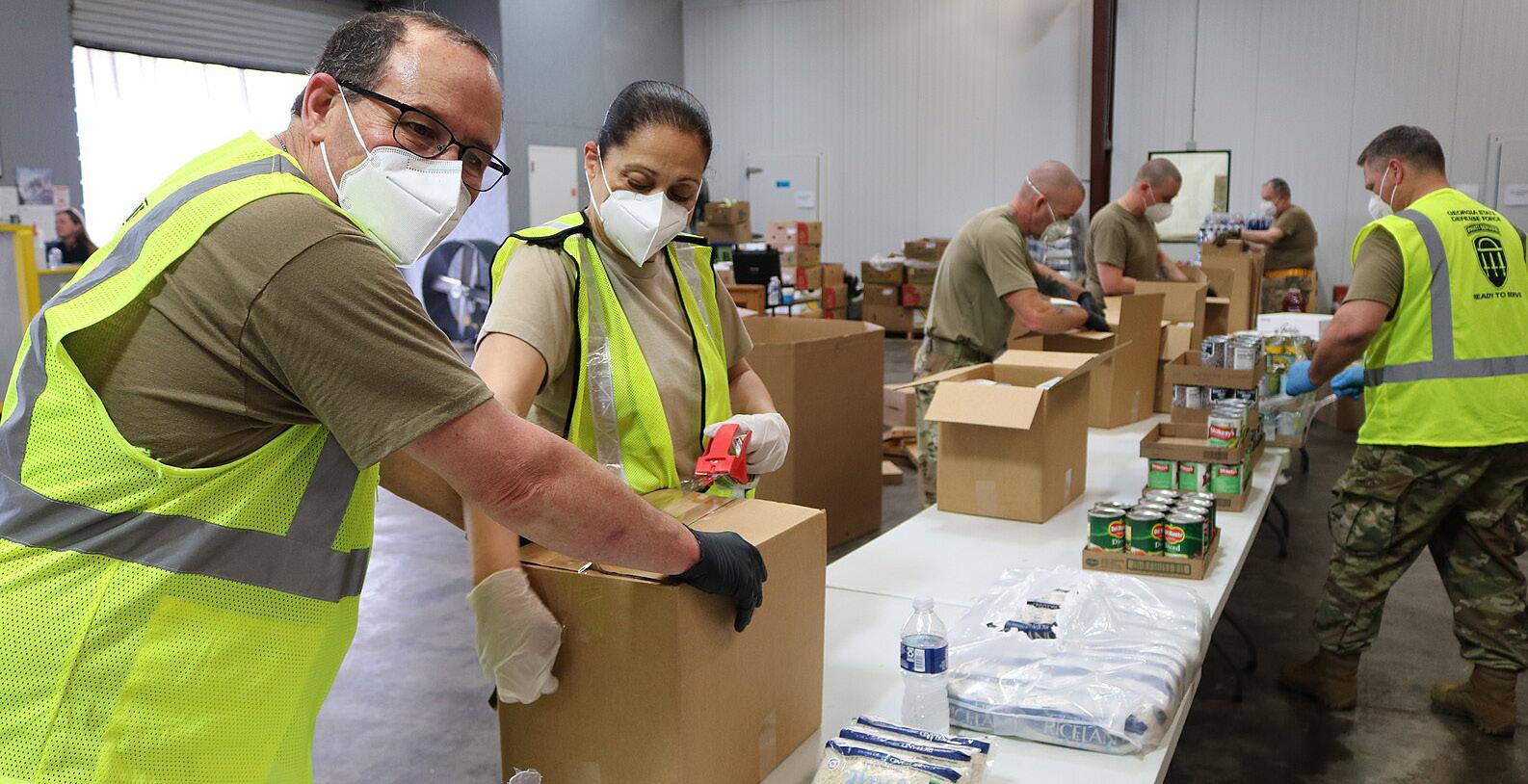
increase their pantries by 20 percent if only 5 percent of landfill-destined food is rescued, meaning millions of additional meals could be served.8 On top of this, the food sent to community or city-run composting locations can be used as fertilizer in gardens or turned into mulch to rejuvenate city parks. Surprisingly, this business model requires lower costs than it may seem. While image-recognition AI seems specialized and complex, the reality is a lot simpler. The greatest expense during the developmental phase would be a computer and CPUs or GPUs, which can cost at most a few thousand dollars. As for manpower, there is no need for expensive, full-time software engineers since pre-made programs such as PyTorch, Keras, and TensorFlow can help experienced computer scientists develop a working system in a few hours.9
After physically creating the system, the image recognition has to be trained to understand the differences in each menu item. This is the trickiest part of the process as businesses serve different dishes, and food waste looks different on each customer’s plate. For example, a half-eaten burger looks different than a burger which was deconstructed and strewn across the plate in a mess.
While collecting thousands of photos for the AI program to study would be rather time-consuming, the cost would be surprisingly low. Amazon offers a service where people can automate the machine learning process by sending the dataset of photos with the program code to its web services. Amazon’s technology would, in turn, churn out a fully educated model. This only costs about $4 to $7 per dataset, requiring under 24 hours to complete.10
A few miscellaneous factors within the business model include installing cameras within each client’s facilities to monitor food waste. This step would require a hired technician and proper transportation, which would mean higher wages, gas, and maintenance expenses. The last type of cost critical to the business’s growth would be outreach and marketing. Reaching a deal with clients may prove to be difficult at first without an established reputation or success in the industry.
Unfortunately, not every solution is airtight, and there are downsides to this proposal. One demographic that this solution doesn’t target is everyday households. The New York Department of Environmental Conservation estimates that 25 percent of the food that people buy goes to
waste, amounting to around $1,000 of wasted produce per person each year.11 Additionally, 37 percent of all food waste comes from residences,12 so failing to help individual families address this problem means food waste will still be a perpetual nuisance. However, most households cannot implement an AI program within their home due to the sheer cost required to do so. Because of this, the amount of money saved is almost minuscule compared to the downsides of using such a system, making this solution prohibitively impractical for homes. On top of this, artificial intelligence is still relatively new, so not all businesses have the resources to implement it into their systems. Forbes notes how businesses need “proper storage, processors, [and] the necessary training needed to understand these new tools and troubleshoot problems.”13 These costs can set the bill from $45,000-$50,000 to more than $100,000 for a single company.14 While several factors may shift the price slightly, these fixed costs may render this AI program unaffordable for small businesses, and larger firms may be hesitant to incur such an expense.
What business owners need to take into account, though, are the long-

term benefits of using this system. Sure, the fixed costs are quite high, and the variable costs, such as electricity and maintenance, add even more to the business’ overhead. Still, the savings from not overordering food or spending money on waste disposal add up. For example, according to the New York City government website, it can cost up to $24.21 to dispose of a cubic
yard of liquid refuse and up to $15.89 for 100 pounds of solid refuse when hiring a private carter.15 Companies can easily cut down on these costs simply by donating scraps or unsold food rather than throwing them out, limiting the overall weight of their garbage, and saving them thousands of dollars in trash disposal fees. This can ultimately offset the installation and operational
expenses in the long run and allow businesses to direct their money toward other endeavors.
All in all, having businesses implement an AI solution would dramatically help the issue of food waste. AI can efficiently and automatically perform many tasks that humans cannot execute under reasonable conditions. The biggest impact is that the spillover effects of food waste will flip from negative to positive, as less food decaying in landfills results in less CO2 and fewer methane emissions. As for the companies themselves, they can take pride in knowing they minimized overspending, maximized shareholder value, and finally produced savings that they can dedicate to expanding the business.
As mentioned before, it is entirely up to the business executives to decide how they will utilize this technology. The AI itself cannot (yet) dictate what people do, so it is important to emphasize that only those in power can make a difference by implementing such efforts. Ultimately, it comes down to human will and whether people are willing to play their role in creating change. So, I hope this solution will not only have a tangible effect by limiting the amount of physical waste but also increase awareness in peoples’ minds. Every little effort can make a difference.
1. While the author offers some corporate solutions, how might individual families waste less food?
2. Given the author’s concerns, do you think the application Too Good to Go (https://www. toogoodtogo.com/en-us) might offer another workable solution?
1 Melissa Gallanter, RD. “Food Waste: Food by the Numbers - NYC Food Policy Center.” NYC Food Policy Center (Hunter College), 25 Mar. 2021, www.nycfoodpolicy.org/food-waste-food-by-thenumbers/#:~:text=Supermarkets%2C%20restaurants%2C%20 colleges%2C%20and,be%20rescued%20instead%20of%20discarded.
2 Ibid.
3 Buzby, Jean. “Food Waste and Its Links to Greenhouse Gases and Climate Change.” USDA, 24 Jan. 2022, www.usda.gov/media/blog/2022/01/24/ food-waste-and-its-links-greenhouse-gases-and-climate-change.
4 Melissa Gallanter, RD.
5 “Businesses.” Businesses - DSNY, www.nyc.gov/site/dsny/businesses/ businesses.page. Accessed 26 Apr. 2024.
6 Revel. “What Is the True Cost of Food Waste?” Revel System Blog, Revel Systems, 12 Jan. 2023, blog.revelsystems.com/the-true-cost-of-foodwaste.
7 “Move over, CHATGPT. Ai Is Coming for Food Waste, Too.” | Blog Posts | WWF.” World Wildlife, www.worldwildlife.org/blogs/sustainabilityworks/posts/move-over-chatgpt-ai-is-coming-for-food-waste-too. Accessed 26 Apr. 2024.
8 Melissa Gallanter, RD.
9 Neo, Benedict. “Building an Image Classification Model with Pytorch from Scratch.” Medium, bitgrit Data Science Publication, 7 Feb. 2022, medium.com/bitgrit-data-science-publication/building-an-imageclassification-model-with-pytorch-from-scratch-f10452073212.
10 Li, Yuqi. “How to Estimate the Time and Cost to Train a Machine Learning Model.” Medium, Towards Data Science, 9 June 2022, towardsdatascience.com/how-to-estimate-the-time-and-cost-to-train-amachine-learning-model-eb6c8d433ff7.
11 “Reducing Wasted Food from Households.” Department of Environmental Conservation, dec.ny.gov/environmental-protection/recyclingcomposting/organic-materials-management/home-composting/reducingwasted-food. Accessed 26 Apr. 2024.
12 “Move over, CHATGPT.”
13 Panel, Expert. “Council Post: 10 Hurdles Companies Are Facing When Implementing AI (and How to Overcome Them).” Forbes, Forbes Magazine, 27 Oct. 2023, www.forbes.com/sites/theyec/2023/10/25/10hurdles-companies-are-facing-when-implementing-ai-and-how-toovercome-them/?sh=61853adb4c91.
14 Inc, RisingMax. “Artificial Intelligence for Waste Management in Smart Cities.” IT Consulting Company in NYC, risingmax.com/blog/artificialintelligence-for-waste-management-in-smart-cities#:~:text=An%20 AI%2Dpowered%20waste%20management,on%20the%20 above%2Dmentioned%20factors. Accessed 26 Apr. 2024.
15 “Maximum Rates.” Maximum Rates - BIC, www.nyc.gov/site/bic/ industries/maximum-rates.page#:~:text=%2424.21%20per%20cubic%20 yard%20of,100%20pounds%20of%20refuse%20(weight). Accessed 26 Apr. 2024.
Photo Credits:
• Jas Min/Unsplash–Page 58
• Markus Spiske/Unsplash–Page 60
• Georgia National Guard/Wikimedia Commons–Page 61
• mikemacmarketing/Wikimedia Commons–Page 62

“The most surprising part of my research on using AI to reduce food waste was discovering how effectively this form of technology can predict and optimize food inventory levels, preventing overstocking and reducing spoilage. AI systems, for example, can analyze large datasets and derive analytics which humans would have a much harder time doing.”
CLASS OF 2027, MAJORING IN FINANCE AND COMPUTING AND DATA SCIENCE


By Shiv Dhar
The article discusses the challenge of regulating corporate emissions to combat climate change. It highlights the potential of Carbon Accounting startups to streamline emissions tracking and reporting among ESG-focused investment funds. Author Shiv Dhar proposes the widespread usage of Persefoni, an artificial intelligence company that tracks and measures carbon emissions among investment funds’ portfolio companies.
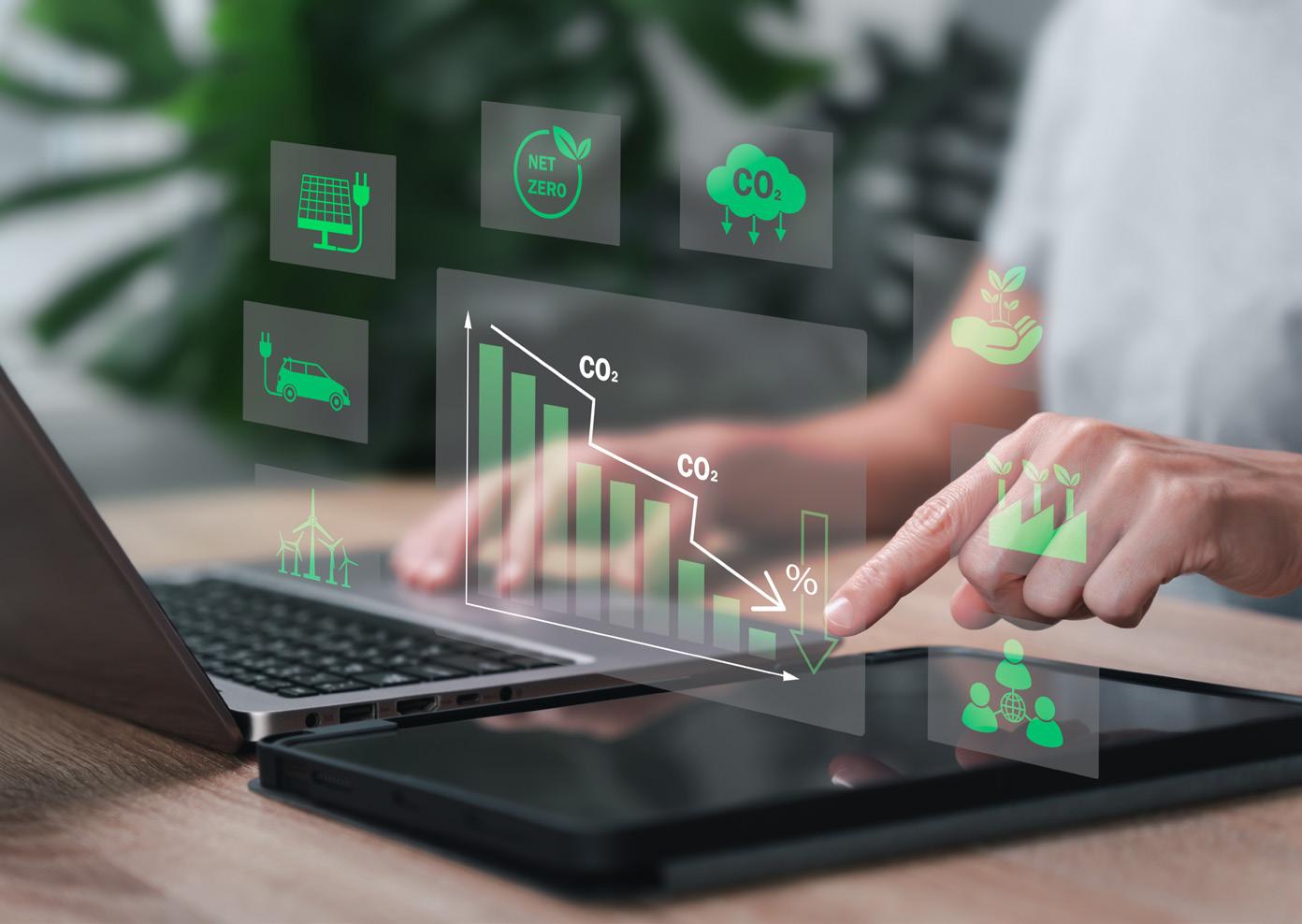
While some bright-eyed small businesses may view the climate crisis as a challenge to conquer, most sluggish conglomerates eye the imminent consequences of global warming with frustration. It is hard to say whether a regulatory crackdown will follow or precede the next milestone in climate deterioration. Corporations, themselves victims of the antiquated shareholderfirst business model, are likely happy about neither and will begrudgingly do what is necessary and perhaps little more. As a consequence, we wonder how to regulate businesses in an equitable and effective way. Building a sweeping, one-size-fits-all set of laws capable of promoting the right effects on every corporation, regardless of operational nuances, is a mammoth
challenge. Yet, it is necessary.
One oft-ignored angle of attack considers how small conscientious companies might be used to chip away at the disinterested majority. The newly-minted Carbon Technology industry, for example, has seen the birth of countless start-ups attempting to throw the best of modern technology at climate change to see what sticks. A subcategory of particular interest, at least from a regulatory and compliance standpoint, is Carbon Accounting, a term that encompasses start-ups that produce software intended to streamline emissions tracking, reporting, and management. One such company, Persefoni, has risen to the forefront, employing Artificial Intelligence to measure emissions, ensure they are reported in a regulation-compliant
manner, and even help companies model potential decarbonization strategies.1
Putting tools like these in the hands of corporations is a necessity. Per the United Nations Intergovernmental Panel on Climate Change (IPCC), meeting the Paris Agreement’s goal of limiting warming to just 1.5oC over pre-industrial levels will require emissions to be cut in half by 2030.2 In this pursuit, the first place to strike will have to be business – one study identified just 57 companies as being linked to 80 percent of greenhouse gas emissions since the landmark Paris climate agreement was introduced in 2016.3 Their own pollutive assets aside, corporations are undeniably responsible for putting the tools in people’s hands that allow them to be pollutive, things like fossil-fuel-based electrical sources and combustion-based vehicles, making them the optimal starting point for implementing widespread change.
The most obvious plan of action is to push for climate action at the company level. The foundational impetus could arise from a growing wave of voluntary climate commitment; roughly twothirds of Fortune 500 companies have made commitments to achieving net-zero emissions.4 Or, if this fails, regulators could impose carbon taxes and green subsidies to incentivize, or even force, decarbonization. Tools like Persefoni are a critical part of this solution, making decarbonization costeffective and straightforward enough for small- to medium-sized businesses to reasonably invest in this pursuit and ensuring high-quality standardized
carbon reporting.
However, there are several places where this perspective falls short. Pragmatically, promissory statements and loose commitments will do little to compel a company to make the tougher sacrifices needed to truly be “green.” Regulatory action, on the other hand, is wrapped in endless layers of complexity. Even if an effective solution existed, it would be stalled indefinitely by debate and may arrive too late, if at all. Companies need to be forced to act, but without seeing their business models and profit margins destroyed.
Rather than attempt to exert influence directly within company operations, it may be time to consider exerting influence through capital structures and financing. Even in the absence of compelling regulation, institutional investors increasingly take it upon themselves to pursue Environmental, Social, and Governance (ESG) goals in their portfolios. Driving and facilitating the ongoing rise in ESG investing may be the best way to reward companies for doing things right and quietly punish those lagging behind. According to McKinsey, 85 percent of Chief Investment Officers already consider ESG metrics an important factor in their investment decisions.5
Large institutional investors primarily hold two types of positions in companies: equity and debt. Equity presents an ownership stake in the company and rights to its residual value, and debt presents fixed, contractual returns, where the company will pay back the amount provided by the investor at some future date and pay some rate of interest in the intervening period. As they adopt ESG goals alongside conventional return maximization, the expectation is that financial institutions would be incentivized to either divest equity investments in carbon-intensive industries or charge increased rates on lending to these companies as a way of offsetting a higher inherent climate and regulatory risk. In this way,
carbon-intensive companies are not necessarily penalized for carrying on with regular operations. Still, they are confronted with a higher cost of capital as a disincentive for failing to rein in emissions.
This approach mitigates a number of the typical criticisms of a straightforward carbon tax. Carbon taxes are often argued to be regressive, being passed down to consumers through higher prices and disproportionately impacting low-income communities.6 Others believe carbon taxes can force carbonintensive businesses into insolvency, demanding a far more rapid pace of transition than most businesses can accommodate. However, allowing the anti-carbon sentiment to manifest itself in investment trends ensures that the day-to-day production of goods and services remains unmarred but that carbon-intensive companies’ capacity to finance new projects is capped.
The problem with these lofty pursuits is a dearth of high-quality, objective data for fund managers to look at when evaluating ESG investments. Practices like greenwashing – the use of misleading marketing to over-represent a company’s eco-friendliness – and inconsistencies arising from small differences in how companies establish their reporting practices can limit the comparability of reported (and self-reported) ESG data. At first glance, mitigating this discrepancy through deeper institutional oversight also appears infeasible. Monitoring emissions across a portfolio of countless investments of various sizes seems like an exceptionally resourceintensive task for investors.
Here, a specific component of Persefoni’s product suite that is of special interest is Persefoni for Financial Services. Beyond tracking their own carbon footprint, Persefoni for Financial Services offers financial institutions the capability to track emissions across all of their portfolio companies.7 Apollo Global Management, one of the world’s

largest alternative asset managers, offers a strong proof-of-concept for this approach. Since launching its partnership with Persefoni, Apollo has worked to onboard portfolio companies to the platform and assist them in pursuing climate-related goals.8
This is exactly what makes the prospect of adopting carbon accounting software at the financial institution level so attractive. Institutions can act as regulators, pushing their portfolio companies to use these platforms and ultimately sending the broader message that attracting investment means providing high-quality ESG data produced through reliable tools.
What might be next for Persefoni’s strategy? The lowest-hanging fruit may be to push for more partnerships akin to the one they have built with Apollo. But, in doubling down on this pursuit, the next steps must be bigger and broader. The direction has been set – Persefoni has recently undertaken a partnership with Apollo and financial research firm MSCI to develop a data platform for credit investors to access the ESG data of their portfolio companies.9 Becoming integrated into a wider investment database evolves Persefoni from a client-driven business into a broader enabler of ESG data transparency.
One way forward could be to expand this partnership with MSCI so that Persefoni’s technology and knowhow support MSCI’s existing efforts to evaluate and assign publicly available ESG ratings to companies.10 Currently, MSCI relies heavily on voluntary corporate disclosures to produce ratings.11 Persefoni could significantly augment this process by establishing data sources from within a company’s operations and providing comparable company data so that approximate conclusions can be drawn about even businesses with no published data at all.
The benefits of such a partnership could be significant. MSCI could bolster the reliability of its evaluation processes, building greater trust in its rating system. Businesses seeking a favorable and reputable rating might

turn to Persefoni’s accounting system, driving demand to unprecedented heights. Above all, funds and investors who have chosen to pursue ESG goals would be better equipped to identify and support the right companies, advancing the fight against climate change.
Of course, relying on voluntary ESG adoption, whether driven by business leaders’ own morals or their desire to appeal to customers’ morals, is simply not a long-term solution. One way or another, more robust frameworks need to be established to change behavior in a lasting way. In a Persefoni-enabled utopia of total carbon transparency, one unique potential solution is a Scope 3 carbon tax specifically for financial institutions.12 Broadly speaking, Scope 3 encompasses emissions arising from upstream and downstream activities not necessarily linked to the assets a company owns.13 For a financial institution holding the debt and equity of other companies, this assessment would encompass the pro-rated carbon emissions of their portfolio companies. Whatever the broad sentiment towards ESG may be, financing would, without a doubt, become harder for unsustainable businesses.
Carbon accounting dangles over the climate crisis as a weapon capable of cutting through the ambiguity and bringing unprecedented clarity and transparency to the web of cause and effect behind climate change. But for all its powers, the deployment of this tool is stunted by this simple fact: the average business gains nothing from it. However, by strategically targeting investors and the investing decisionmaking process, carbon accounting start-ups like Persefoni may find a strong access point to propagate into the world of business.
1. What do you perceive is the biggest challenge surrounding this proposal? Why?
2. What needs to happen for businesses to embrace sustainability?
1 “Persefoni – Climate Management & Carbon Accounting Platform.” www. persefoni.com/.
2 IPCC. “Urgent Climate Action Can Secure a Liveable Future for All — IPCC.” IPCC, 20 Mar. 2023, www.ipcc.ch/2023/03/20/press-release-ar6synthesis-report/.
3 Watts, Jonathan. “Just 57 Companies Linked to 80% of Greenhouse Gas Emissions since 2016.” The Guardian, 3 Apr. 2024, www.theguardian. com/environment/2024/apr/04/just-57-companies-linked-to-80-ofgreenhouse-gas-emissions-since-2016.
4 Climate Impact Partners. “Fortune Global 500 Climate Commitments.” www.climateimpact.com, www.climateimpact.com/news-insights/ fortune-global-500-climate-commitments/.
5 Gelb, Jay, et al. “Investors Want to Hear from Companies about the Value of Sustainability | McKinsey.” Www.mckinsey.com, 15 Sept. 2023, www.mckinsey.com/capabilities/strategy-and-corporate-finance/ourinsights/investors-want-to-hear-from-companies-about-the-value-ofsustainability.
6 “What a Carbon Tax Can Do and Why It Cannot Do It All.” World Bank Blogs, blogs.worldbank.org/en/energy/what-carbon-tax-can-do-andwhy-it-cannot-do-it-all#:~:text=There%20are%20good%20reasons%20 why.
7 “Persefoni for Financial Services: Investor-Grade Carbon Management, Disclosure, and Reduction.” Www.persefoni.com, www.persefoni.com/ financial-services. Accessed 6 May 2024.
8 Global Management, Apollo. 2022 Annual Sustainability Report. www. apollo.com/content/dam/apolloaem/documents/insights/apollo-2022sustainability-report-June-19-2023.pdf.
9 Avery, Charles. “Apollo, Persefoni and MSCI Launch Private Credit ESG Data Platform.” New Private Markets, 12 Feb. 2024, www. newprivatemarkets.com/apollo-persefoni-and-msci-launch-privatecredit-esg-data-platform/. Accessed 6 May 2024.
10 MSCI. “ESG Investing: ESG Ratings.” Www.msci.com, 2023, www.msci. com/our-solutions/esg-investing/esg-ratings.
11 “What If ESG Disclosures Become Standardized?” Www.msci.com, www.msci.com/what-if-esg-disclosures-become-standardized.
12 Padin-Dujon, Alejandra. “The Case for a Scope 3 Carbon Tax for Financial Institutions.” Grantham Research Institute on Climate Change and the Environment, 27 Feb. 2023, www.lse.ac.uk/granthaminstitute/ news/the-case-for-a-scope-3-carbon-tax-for-financial-institutions/.
13 US EPA, OAR. “Scope 3 Inventory Guidance.” US EPA, 8 Nov. 2016, www.epa.gov/climateleadership/scope-3-inventoryguidance#:~:text=Scope%203%20emissions%20are%20the.
Photo Credits:
• Stockwerk-Fotodesign/AdobeStock–Page 64
• Silence/AdobeStock–Page 66
• Jaen/AdobeStock–Page 67
• VectorMine/AdobeStock–Page 68

“There is a fundamental misalignment between corporate incentives and social goals that complexifies the process of pushing for corporate climate action. Corporations are complex decision-makers, constructed with certain legal frameworks and fiduciary duties. Rather than attempting to sell them on ideology, it is far more effective to try to contextualize the costs of social issues within the scope of the corporation’s decision-making. Increasing the prominence and feasibility of ESG investing - through greater data transparency, for one - is an example of this.
I believe it is an excellent way to make socially conscious decisions that also make business and financial sense.”
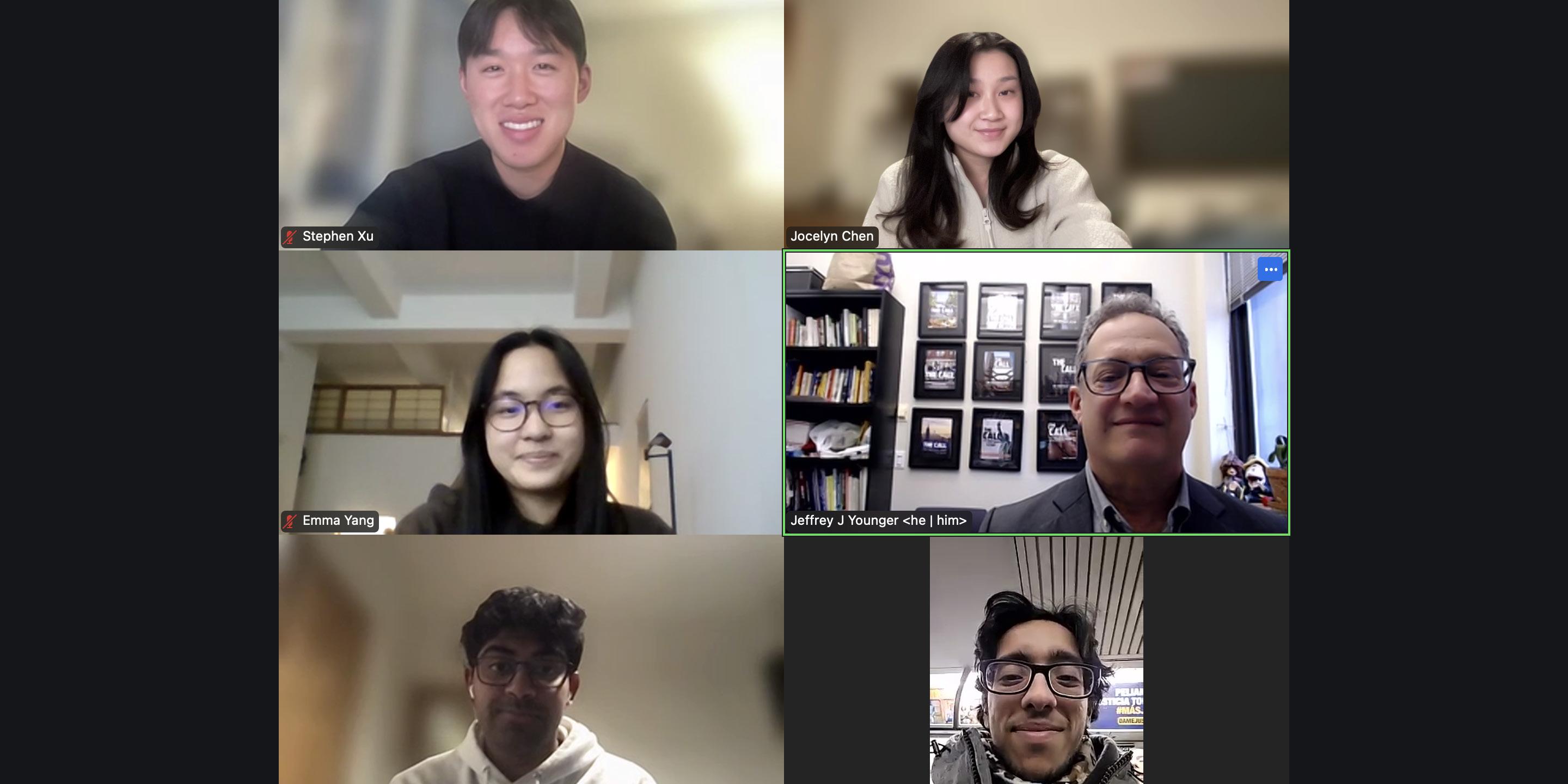



Lead Editor: Stephen Xu
Editors: Emma Yang, Miranda Womack, Moksh Jain, Tarun Sivakumar, and Vihaan Hari Designers: Jocelyn Chen and Sneha Rao
Back cover: The San Remo is a historic and iconic twin-towered apartment building located at 145-146 Central Park West in New York City. Completed in 1930, it is one of the city’s most prestigious co-op buildings, known for its distinctive Renaissance revival architecture, luxurious amenities, and celebrity residents over the years.
Front and back inner cover and page 02 taken by Jocelyn Chen, a sophomore (Class of '27) majoring in Media, Culture, and Communication and minoring in Business of Entertainment, Media, and Technology.
Ihope you enjoyed this edition of The Call for Corporate Action, NYU Stern Student Voices. It’s my pleasure to celebrate this year’s published authors and extend heartfelt thanks to all the contributors who made this 12th edition possible.
From over 650 student essays submitted for the Spring 2024 Business and Society course, our team reviewed 75 semi-finalists and ultimately published 10 standout pieces. These essays represent the heart and soul of this issue, embodying creativity and critical thinking alongside powerful ideas. We hope the high caliber of their thinking and writing inspires current and future writers to push boundaries and explore the complex connections between business, society, and government.
Our student selection team—most of whom are past Call authors—evaluated the essays with an eye for compelling content, fluid composition, and thought-provoking “calls for corporate action.” The team sought originality, feasibility, and passion while curating a mix of perspectives and topics. Their goal was to showcase the best of current Stern student thought throughout this issue. I thank them for their dedication.

Faculty Editor, The Call Clinical Professor
Senior Editor Stephen Xu and his incredible editorial team—Emma Yang, Miranda Womack, Moksh Jain, Tarun Sivakumar, and Vihaan Hari—ensured every essay was polished to perfection. Thanks to Graphic Designers Jocelyn Chen and Sneha Rao, the visual presentation matches the excellence of the writing. Additional support from Management Communication Assistants Amaya Chmielewski, Brigitte Uriarte, and Corina Senior-Egana elevated every page. I deeply appreciate all of you for your hard work, creativity, and passion.
Special thanks go to NYU Stern Undergraduate Dean Rohit Deo for his thoughtful opening letter, Professor Matt Statler for his introduction to the Business & Society course, and Erin K. Potter and Sangeeta Bhojwani for their invaluable assistance.
The core of this publication lies in the unwavering commitment of the instructors who guide our students through weekly critical thinking and writing sessions in the Business & Society course. Their expertise is evident in every essay. My sincere appreciation to the following Spring 2024 instructors: A.J. Fuentes, Alex Puutio, Amaya Rivera, Aya Tanaka, Bob DiYanni, Bruce Meyerson, Claudia Caruana, Ellen Pluta, Fadia Nordveit, Haider Fancy, Irv Schenkler, Kate Brideau, Keith Meatto, Kevin Barrow, Kim Bhasin, Larry Menna, Mark Brennan, Matt Statler, Nicole Jones, Petria May, Robert Wosnitzer, Tim Gilman, Tim Glencross, Vivian Giang, and Wei Shi. Your dedication to nurturing Stern students is inspiring and transformative.
Finally, I am deeply grateful to Batia Wiesenfeld, Brian Hanssen, Matt Statler, Mara van Loggerenberg, and Janeece Lewis for their guidance and support. Your leadership ensures the continued success of this publication. Thank you for contributing to this 12th volume of The Call for Corporate Action, NYU Stern Student Voices.
Warmly, Jeffrey J. Younger
Enjoyed this magazine? Check out past issues of The Call for Corporate Action: NYU Stern Student Voices
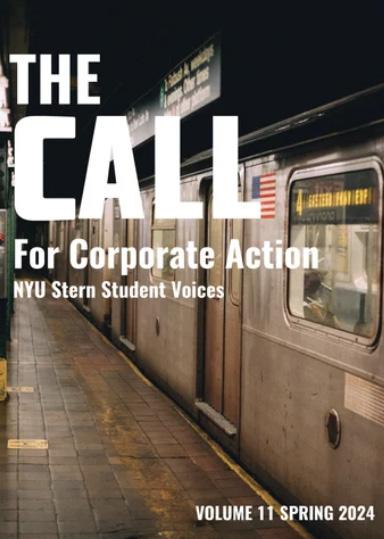
Volume 11, Spring 2024
https://issuu.com/corporateaction/docs/ the_call_2024

Volume 08, Spring 2021
https://issuu.com/corporateaction/docs/ the_call_2021

Volume 04, Spring 2017
https://issuu.com/corporateaction/docs/ the_call_2017
/
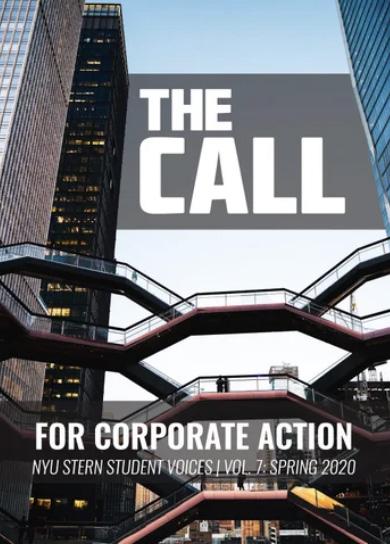
Volume 07, Spring 2020
https://issuu.com/corporateaction/docs/ the_call_2020

Volume 03, Spring 2015
https://issuu.com/corporateaction/docs/ the_call_2015
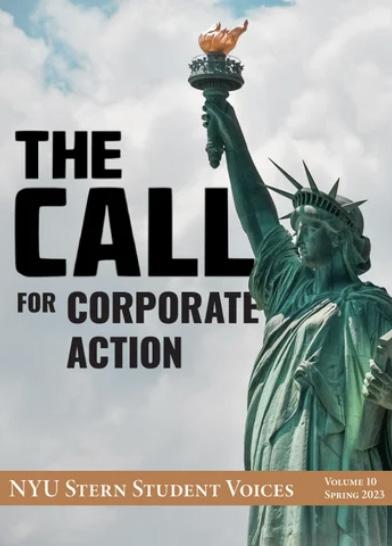
Volume 10, Spring 2023
https://issuu.com/corporateaction/docs/ the_call_2023
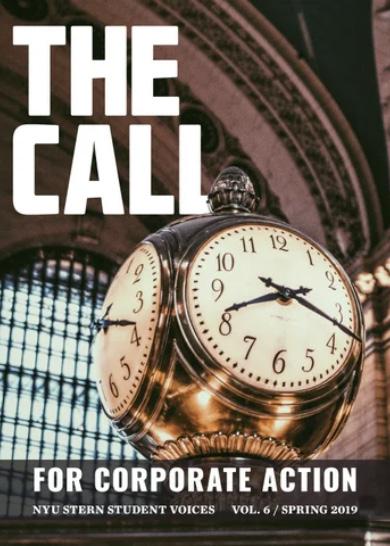
Volume 06, Spring 2019
https://issuu.com/corporateaction/docs/ the_call_2019

Volume 02, Spring 2013
https://issuu.com/corporateaction/docs/ the_call_2013
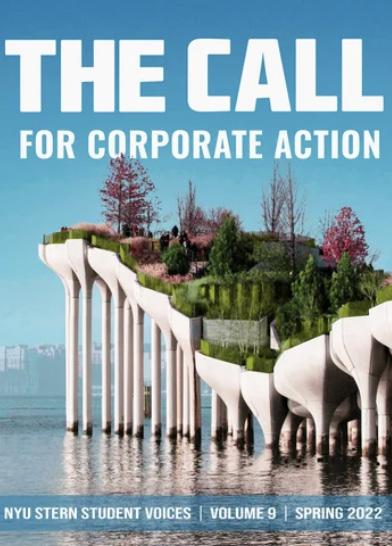
Volume 09, Spring 2022
https://issuu.com/corporateaction/docs/ the_call_2022

Volume 05, Spring 2018
https://issuu.com/corporateaction/docs/ the_call_2018
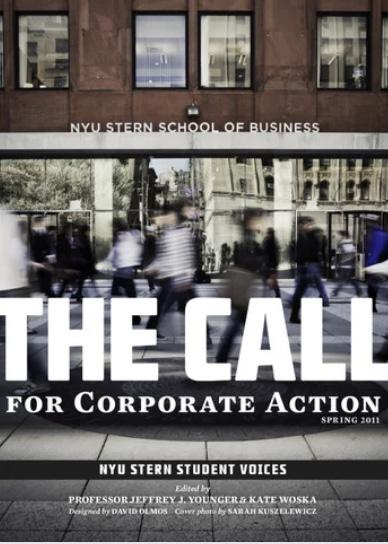
Volume 01, Spring 2011
https://issuu.com/corporateaction/docs/ the_call_2011

